Appendix D3 LTT 2020 Communication Materials
Appendix D3 LTT 2020 Communication Materials.docx
National Assessment of Educational Progress (NAEP) 2019 and 2020 Long-Term Trend (LTT) Update 2
Appendix D3 LTT 2020 Communication Materials
OMB: 1850-0928
National Center for Education Statistics
National Assessment of Educational Progress
National Assessment of Education Progress (NAEP)
2019 and 2020
Long-Term Trend (LTT) 2020 Update 2
Appendix D3
Long Term Trend (LTT) 2019- 2020 Communications and Recruitment Materials Update
OMB# 1850-0928 v.16
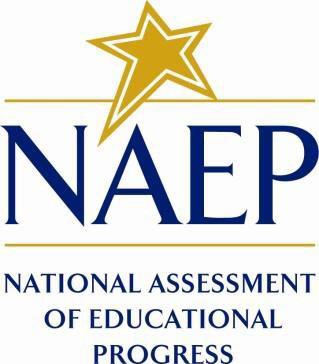
March 2019
revised July 2019
The following Appendices have been revised based on those in Appendix D1 and D2 of this submission (used in NAEP 2019 and marked below as “old”) and added to Appendix D3 (this document) for use in the 2019-2020 LTT (marked below as “new”):
Facts for Teachers, Public Schools and Private Schools, Appendix D1-7 (old) - Appendix D3-15 (new),
Templates for State Specific SD Inclusion Policy, Appendix D1-8 (old) - Appendix D3-16 (new),
Templates for State Specific ELL Inclusion Policy, Appendix D1-9 (old) - Appendix D3-17 (new),
Best Practices for Students age 17, Appendix D1-10 (old) - Appendix D3-18 (new),
References for Best Practices, Appendix D1-11 (old) - Appendix D3-19 (new),
Parent/Guardian Letter in Spanish, translation of Appendix D3-7 and D3-8 - Appendix D3-20 and D3-21 (new), respectively, and
2020 NCES Letter to Chiefs, Appendix D2-15 (old) - Appendix D3-22 (new).
Should any additional revisions be necessary, they will be submitted to OMB by October 2019.
Table of Contents
Appendix D3-1: 2019-2020 Facts for Districts 3
Appendix D3-2: 2019-2020 Facts for Principals 6
Appendix D3-4: 2020 NAEP in Your School, Public 12
Appendix D3-5: 2020 NAEP in Your School, Private 15
Appendix D3-6: 2019-2020 Save-the-Date Letter from the NAEP Coordinator to School Principal 18
Appendix D3-7: 2019-2020 Parent/ Guardian Notification Letter, Public 20
Appendix D3-8: 2020 Parent/ Guardian Notification Letter, Private 22
Appendix D3-9: 2020 Private School Endorsement Letter 24
Appendix D3-10: 2019-2020 Notification Letter from NAEP State Coordinator to Principals 26
Appendix D3-11: 2020 School Coordinator Responsibilities: A Guide to MyNAEP, Public 30
Appendix D3-12: 2020 School Coordinator Responsibilities: A Guide to MyNAEP, Private 35
Appendix D3-14: 2019-2020 Assessment Details Letter from the NAEP State Coordinator to Principals 43
Appendix D3-15: Facts for Teachers, Public Schools and Private Schools 45
Appendix D3-16: Templates for State Specific SD Inclusion Policy 54
Appendix D3-17: Templates for State Specific ELL Inclusion Policy 58
Appendix D3-18: Best Practices for Students 62
Appendix D3-19: References for Best Practices 71
Appendix D3-20: (Spanish version) 2020 Parent/ Guardian Notification Letter, Public 154
Appendix D3-21: (Spanish version) 2020 Parent/ Guardian Notification Letter, Private 156
Appendix D3-1: 2019-2020 Facts for Districts
NAEP 2019-2020
Facts for Districts
Page One Sidebar
NAEP is an integral part of education in the United States.
Elected officials, policymakers, and educators all use NAEP results to develop ways to improve education.
NAEP is a congressionally mandated project administered by the National Center for Education Statistics (NCES), within the U.S. Department of Education and the Institute of Education Sciences.
NAEP serves a different role than state assessments. While states have their own unique assessments with different content standards, the same NAEP assessment is administered in every state, providing a common measure of student achievement.
Depending on the type of NAEP assessment that is administered, the data can be used to compare and understand the performance of demographic groups within your state, the nation, other states, and districts that participate in the Trial Urban District Assessment (TUDA). NAEP is not designed to collect or report results for individual students, classrooms, or schools.
To provide a better understanding of educational experiences and factors that may be related to students’ learning, students are asked to complete questionnaires. There are no teacher or school questionnaires in the long- term trend assessment.
Page One Body
“Informational assessment materials were accessible and easy to understand. The NAEP representative assigned to our school was supportive and very knowledgeable about assessment protocols and what our school needed to do to be well prepared. On testing day, the NAEP team was organized and administered the assessment efficiently.”
- Ronda E. George, Assistant Principal, Noe Middle School, Louisville, KY
The National Assessment of Educational Progress (NAEP), first administered in 1969, is the largest nationally representative and continuing assessment of what our nation’s students know and can do in various subjects such as civics, geography, mathematics, reading, science, U.S. history, and writing. The results of NAEP are released as The Nation’s Report Card.
District staff play an essential role in NAEP. Superintendents and district staff can work closely with principals to explain the importance of the assessment to teachers and participating students. When students take part in the assessment and give their best effort, NAEP results provide the most accurate measure possible of student achievement across the country.
NAEP representatives will bring all necessary materials to schools on assessment day. Schools will only need to provide space with desks or tables for students to take the assessment. The table below shows which subjects and student groups will be assessed during the 2019-2020 school year. National results will be released for the long-term trend assessment.
|
The NAEP 2019-2020 Assessment |
||||
Age or Grade |
Type of NAEP |
Subjects |
Format |
National Results |
Assessment Window |
9-year-olds |
Long-term trend |
Reading |
Paper & Pencil |
√ |
January 6, 2020 – March 13, 2020 |
Mathematics |
Paper & Pencil |
√ |
|||
13-year-olds |
Long-term trend |
Reading |
Paper & Pencil |
√ |
October 14, 2019 – December 20, 2019 |
Mathematics |
Paper & Pencil |
√ |
|||
17-year-olds |
Long-term trend |
Reading |
Paper & Pencil |
√ |
March 16, 2020 – May 22, 2020 |
Mathematics |
Paper & Pencil |
√ |
|||
Page One Footer
For more information about NAEP, visit www.nces.ed.gov/nationsreportcard.
Page Two Body
It’s important to know...
NAEP long-term trend assessments measure student performance in mathematics and reading and have allowed the performance of today’s students to be compared with students since the early 1970s. Long-term trend assessments are administered periodically to 9-, 13-, and 17-year-olds.
Main NAEP is administered to fourth, eighth, and twelfth graders in a variety of subjects. For all main NAEP and LTT assessments, results are available at the national-level. Depending on the assessment year and subject, main NAEP results may also be available at the state-level and for large urban districts participating in the TUDA program.
NAEP is considered the gold standard of assessments because of its high technical quality. From the development of assessment frameworks and questions to the reporting of results, NAEP represents the best thinking of assessment and content specialists, state education staff, and teachers from around the nation. NAEP is a trusted resource that measures student progress and helps inform policy decisions that improve education in the United States.
NAEP results are reported for different demographic groups and are not reported for individual students or schools. Within a school, just some of the student population participates, and student responses are combined with those from other participating students to produce the results.
A carefully designed sampling process ensures that NAEP-selected schools and students are representative of all schools and students across the United States. To ensure that the sample represents all students in the nation’s schools, a broad range of accommodations are allowed for students with disabilities and English language learners.
NAEP is designed to cause minimal disruption of classroom instruction. Including transition time, directions, and completion of a short five-minute questionnaire, it takes approximately 90 minutes for students to complete the NAEP assessment. Each student is assessed in only one subject. Teachers do not need to prepare their students to take the assessment but should encourage students to do their best. NAEP representatives provide significant support to your district’s schools by working with the designated coordinator in each school to organize assessment activities.
NAEP items can be used as a helpful educational resource in the classroom. Teachers and district staff can use the NAEP Questions Tool (http://nces.ed.gov/nationsreportcard/nqt) to see how students’ performance compares nationally on specific items. Released NAEP items come with a scoring guide, sample student responses, and performance data.
Visit the NAEP website at http://nces.ed.gov/nationsreportcard to access this information and more.
National Center for Education Statistics (NCES) is authorized to conduct NAEP by the National Assessment of Educational Progress Authorization Act (20 U.S.C. §9622). All of the information provided by participants may be used only for statistical purposes and may not be disclosed, or used, in identifiable form for any other purpose except as required by law (20 U.S.C. §9573 and 6 U.S.C. §151). By law, every NCES employee as well as every NCES agent, such as contractors and NAEP coordinators, has taken an oath and is subject to a jail term of up to 5 years, a fine of $250,000, or both if he or she willfully discloses ANY identifiable information about participants. Electronic submission of participant’s information will be monitored for viruses, malware, and other threats by Federal employees and contractors in accordance with the Cybersecurity Enhancement Act of 2015. The collected information will be combined across respondents to produce statistical reports.
Page Two Footer
Find us on: [insert social media icons]
Appendix D3-2: 2019-2020 Facts for Principals
NAEP 2019-2020 Long-Term Trend
Facts for Principals
Page One Sidebar
NAEP is an integral part of education in the United States.
Elected officials, policymakers, and educators all use NAEP results to develop ways to improve education.
NAEP is a congressionally mandated project administered by the National Center for Education Statistics (NCES), within the U.S. Department of Education and the Institute of Education Sciences.
NAEP serves a different role than state assessments. While states have their own unique assessments with different content standards, the same NAEP assessment is administered in every state, providing a common measure of student achievement.
Depending on the type of NAEP assessment that is administered, the data can be used to compare and understand the performance of demographic groups within your state, the nation, other states, and districts that participate in the Trial Urban District Assessment (TUDA). NAEP is not designed to collect or report results for individual students, classrooms, or schools.
To provide a better understanding of educational experiences and factors that may be related to students’ learning, students are asked to complete questionnaires. There are no teacher or school questionnaires in the long- term trend assessment.
Page One Body
“The NAEP representatives were informative and provided specific instructions when administering the assessment. Their professionalism and knowledge before the assessment ensured that the students had a positive experience with NAEP.”
—Amneris Montalvo, NAEP School Coordinator, Citrus Grove Middle School, Miami, FL
The National Assessment of Educational Progress (NAEP), first administered in 1969, is the largest nationally representative and continuing assessment of what our nation’s students know and can do in various subjects such as civics, geography, mathematics, reading, science, U.S. history, and writing. The results of NAEP are released as The Nation’s Report Card.
NAEP is designed to be minimally disruptive to schools, and NAEP representatives will provide significant support to your school on assessment day. As principals, you make an important contribution to the program by selecting and empowering a NAEP school coordinator, meeting with teachers and participating students, and encouraging your students to participate and do their best. You are essential partners in NAEP. When students participate and give their best effort, NAEP results provide the most accurate measure possible of student achievement across the country.
During the 2019-2020 school year, the NAEP long-term trend assessment will be administered in your school. NAEP long-term trend assessments measure student performance in mathematics and reading, and have allowed the performance of today’s students to be compared with students since the early 1970s. The table below describes the 2019-2020 assessment program for which national results will be available. For more information about the long-term trend assessment, visit https://nces.ed.gov/nationsreportcard/ltt.
Assessments in mathematics and reading will be conducted with representative samples of 9-, 13-, and 17-year-old students on the following schedule. Each student will be assessed in only one subject.
Age 13: October 14, 2019 – December 20, 2019
Age 9: January 6, 2020 – March 13, 2020
Age 17: March 16, 2020 – May 22, 2020
|
The NAEP 2019-2020 Assessment |
||||
Age or Grade |
Type of NAEP |
Subjects |
Format |
National Results |
Assessment Window |
9-year-olds |
Long-term trend |
Reading |
Paper & Pencil |
√ |
January 6, 2020 – March 13, 2020 |
Mathematics |
Paper & Pencil |
√ |
|||
13-year-olds |
Long-term trend |
Reading |
Paper & Pencil |
√ |
October 14, 2019 – December 20, 2019 |
Mathematics |
Paper & Pencil |
√ |
|||
17-year-olds |
Long-term trend |
Reading |
Paper & Pencil |
√ |
March 16, 2020 – May 22, 2020 |
Mathematics |
Paper & Pencil |
√ |
|||
Page One Footer
For more information about NAEP, visit www.nces.ed.gov/nationsreportcard.
Page Two Body
It’s important to know...
NAEP long-term trend assessments measure student performance in mathematics and reading and have allowed the performance of today’s students to be compared with students since the early 1970s. Long-term trend assessments are administered periodically to 9-, 13-, and 17-year-olds.
Main NAEP is administered to fourth, eighth, and twelfth graders in a variety of subjects. For all main NAEP and LTT assessments, results are available at the national-level. Depending on the assessment year and subject, main NAEP results may also be available at the state-level and for large urban districts participating in the TUDA program.
NAEP is considered the gold standard of assessments because of its high technical quality. From the development of assessment frameworks and questions to the reporting of results, NAEP represents the best thinking of assessment and content specialists, state education staff, and teachers from around the nation. NAEP is a trusted resource that measures student progress and helps inform policy decisions that improve education in the United States.
NAEP results are reported for different demographic groups and are not reported for individual students or schools. Within a school, just some of the student population participates, and student responses are combined with those from other participating students to produce the results.
A carefully designed sampling process ensures that NAEP-selected schools and students are representative of all schools and students in their district, state, and across the United States. To ensure that the sample represents all students in the nation’s schools, a broad range of accommodations are allowed for students with disabilities and English language learners.
NAEP is designed to cause minimal disruption of classroom instruction. Including transition time, directions, and completion of a short five-minute questionnaire, it takes approximately 90 minutes for students to complete the assessment. Each student is assessed in only one subject. Teachers do not need to prepare their students to take the assessment but should encourage students to do their best. NAEP representatives provide significant support to your school by working with the designated coordinator in your school to organize assessment activities.
NAEP items can be used as a helpful educational resource in the classroom. Teachers and district staff can use the NAEP Questions Tool (http://nces.ed.gov/nationsreportcard/nqt) to see how students’ performance compares nationally on specific items. Released NAEP items come with a scoring guide, sample student responses, and performance data.
Visit the NAEP website at http://nces.ed.gov/nationsreportcard to access this information and more.
National Center for Education Statistics (NCES) is authorized to conduct NAEP by the National Assessment of Educational Progress Authorization Act (20 U.S.C. §9622). All of the information provided by participants may be used only for statistical purposes and may not be disclosed, or used, in identifiable form for any other purpose except as required by law (20 U.S.C. §9573 and 6 U.S.C. §151). By law, every NCES employee as well as every NCES agent, such as contractors and NAEP coordinators, has taken an oath and is subject to a jail term of up to 5 years, a fine of $250,000, or both if he or she willfully discloses ANY identifiable information about participants. Electronic submission of participant’s information will be monitored for viruses, malware, and other threats by Federal employees and contractors in accordance with the Cybersecurity Enhancement Act of 2015. The collected information will be combined across respondents to produce statistical reports.
Page Two Footer
Find us on: [insert social media icons]
Appendix D3-3: 2019-2020 Notification Letter from Chief State School Officer to District Superintendent
Early May NAEP 2019-2020 Notification Letter From
CHIEF STATE SCHOOL OFFICER TO DISTRICT SUPERINTENDENT
Red text should be customized before mail merge: highlighted text represents mail merge fields
Dear District Superintendent name,
I am pleased to notify you that number schools in your district have been selected to participate in the 2019-2020 administration of the National Assessment of Educational Progress (NAEP). NAEP is the largest nationally representative and continuing assessment of what students in the United States know and can do in various subjects. It is administered by the National Center for Education Statistics (NCES), within the U.S. Department of Education. Selected schools represent schools across the nation, and their participation provides an accurate picture of student performance. School District will play an important role by participating, and I know that we can count on your full support to make this a meaningful experience for your schools and students.
Selected schools are notified in advance so that principals can place the assessment windows on their calendars and incorporate NAEP into the planned school program. A few additional schools within School District may also be selected at a later date; your NAEP State Coordinator will contact you should this happen. Starting in May 2019 and continuing through June, each school will receive its assessment date. Schools may work with the NAEP State Coordinator if there is a conflict with the scheduled date.
Beginning in October 2019 and continuing through May 2020, NAEP will administer long-term trend (LTT) assessments in mathematics and reading. The attached list of district schools selected for NAEP shows the age group for each selected school.
Age 13: October 14–December 20, 2019
Age 9: January 6–March 13, 2020
Age 17: March 16–May 22, 2020
The data collected can be linked to NAEP assessments conducted in the early 1970s to measure progress over time. National-level results will be released as The Nation’s Report Card. As in previous years, NAEP representatives provide significant support to schools: they bring all necessary materials and equipment, and administer the assessment.
Please include the NAEP assessment windows on your district test calendar. Information about NAEP can be found in the enclosures listed below and at http://nces.ed.gov/nationsreportcard. Name, our NAEP State Coordinator, will contact your staff with additional information.
Thank you for supporting this important assessment and for helping accomplish our goal of 100 percent participation.
Sincerely,
Name of Chief State School Officer
Enclosures: List of district schools selected for NAEP
Facts for Districts – Link for electronic mailing
CC: State Testing Director
District Testing Director
NAEP State Coordinator
National Center for Education Statistics (NCES) is authorized to conduct NAEP by the National Assessment of Educational Progress Authorization Act (20 U.S.C. §9622). All of the information provided by participants may be used only for statistical purposes and may not be disclosed, or used, in identifiable form for any other purpose except as required by law (20 U.S.C. §9573 and 6 U.S.C. §151). By law, every NCES employee as well as every NCES agent, such as contractors and NAEP coordinators, has taken an oath and is subject to a jail term of up to 5 years, a fine of $250,000, or both if he or she willfully discloses ANY identifiable information about participants. Electronic submission of participant’s information will be monitored for viruses, malware, and other threats by Federal employees and contractors in accordance with the Cybersecurity Enhancement Act of 2015. The collected information will be combined across respondents to produce statistical reports.
Appendix D3-4: 2020 NAEP in Your School, Public
NAEP 2020 in Your School
Long-Term Trend, Ages 9, 13, 17
Page One Sidebar
What is NAEP?
The National Assessment of Educational Progress (NAEP) is an essential measurement of student achievement in the United States.
First administered in 1969, NAEP is the largest continuing and nationally representative assessment of what our nation’s students know and can do in various subjects such as mathematics and reading.
The schools and students participating in NAEP make an important contribution by representing other schools and students across the country.
NAEP is considered the gold standard of assessments because of its high technical quality. From developing frameworks and questions to the reporting of results, NAEP represents the best thinking of assessment and content specialists, state education staff, and teachers from around the nation.
NAEP is a common measure of academic progress across the nation and over time. The results are released as The Nation's Report Card.
Page One Body
From October 2019 and continuing through May 2020, NAEP field staff will administer the long-term trend assessments in mathematics and reading in schools across the country. Long-term trend (LTT) results can be linked to NAEP assessments first administered in the early 1970s, allowing us to measure progress over a span of nearly 50 years. The age samples for long-term trend assessments are 9-, 13-, and 17-year-olds. The assessment window for each age group is as follows:
Age 13: October 14, 2019 – December 20, 2019
Age 9: January 6, 2020 – March 13, 2020
Age 17: March 16, 2020 – May 22, 2020
Results will be reported at the national level. NAEP data are used by teachers, principals, parents, policymakers, and researchers to assess students’ progress in various subject areas and to develop ways to improve education in the United States.
What is involved?
Selected students will participate in paper-based mathematics or reading assessments, and each student will be assessed in only one subject. NAEP representatives will bring all materials and equipment to the school on assessment day. Students will spend up to 90 minutes completing the assessment. This includes transition time, directions, and completion of a student survey questionnaire. The questionnaire provides valuable information about students’ educational experiences and opportunities to learn both inside and outside of the classroom. There will be no school or teacher questionnaires for the long-term trend assessment.
How many students will be assessed?
Nationally, across both mathematics and reading and all three age groups, about 48,000 students will be assessed.
For more information about NAEP, visit www.nces.ed.gov/nationsreportcard.
Page Two Body
It’s important to know...
Who will be responsible for coordinating and administering NAEP?
Your NAEP State Coordinator, NAEP representatives, and school staff will work together to coordinate and administer the assessment. A member of your school’s staff will need to be assigned to serve as the school coordinator and be the primary contact for the assessment. This person should be:
familiar with how students participate in statewide assessments; and
comfortable using a computer to collect and enter student information online.
The NAEP State Coordinator works at your state department of education and will be responsible for:
working with schools to confirm the assessment date;
communicating with principals about the importance of NAEP and student participation;
providing schools with instructions for preparing a list of students and information about notifying parents of participating students;
providing guidance for including students with disabilities and English language learners; and
responding to questions from the school community throughout the assessment period.
NAEP representatives employed by a U.S. Department of Education contractor to work directly with schools will be responsible for:
selecting a random sample of students from the school list of students in the appropriate age group;
verifying information that the school coordinator has provided via the MyNAEP website, which will serve as the primary resource and action center throughout the NAEP assessment process;
working with the school coordinator to finalize assessment logistics;
bringing all assessment materials to the school on the scheduled day; and
conducting the assessment.
Each principal will be responsible for:
assigning a school staff member to serve as school coordinator;
including the NAEP assessment date on the school calendar;
empowering the designated school coordinator to work with the NAEP representative and NAEP State Coordinator to prepare for the assessment; and
informing school staff and students about NAEP and why student participation is critically important.
The school coordinator will be responsible for:
confirming the scheduled assessment date with the NAEP State Coordinator;
registering for the MyNAEP website and providing information about the school;
if requested, overseeing the submission of an electronic list of students in the appropriate age group;
using the MyNAEP website to prepare for the assessment;
informing parents of the assessment (more information will be provided on how to complete this task);
communicating with the NAEP representative to finalize assessment preparations;
organizing the availability of school space for the assessment, including room(s) and desks or tables; and
collaborating with school staff to ensure a high rate of student participation.
Detailed information about the school coordinator’s responsibilities will be sent at the beginning of the school year.
National Center for Education Statistics (NCES) is authorized to conduct NAEP by the National Assessment of Educational Progress Authorization Act (20 U.S.C. §9622). All of the information provided by participants may be used only for statistical purposes and may not be disclosed, or used, in identifiable form for any other purpose except as required by law (20 U.S.C. §9573 and 6 U.S.C. §151). By law, every NCES employee as well as every NCES agent, such as contractors and NAEP coordinators, has taken an oath and is subject to a jail term of up to 5 years, a fine of $250,000, or both if he or she willfully discloses ANY identifiable information about participants. Electronic submission of participant’s information will be monitored for viruses, malware, and other threats by Federal employees and contractors in accordance with the Cybersecurity Enhancement Act of 2015. The collected information will be combined across respondents to produce statistical reports.
Page Two Footer
Find us on: [Facebook, Twitter and YouTube logos]
Appendix D3-5: 2020 NAEP in Your School, Private
NAEP 2020 in Your Private School
Long-Term Trend, Ages 9, 13, and 17
Page 1 Sidebar
What is NAEP?
The National Assessment of Educational Progress (NAEP) is an essential measurement of student achievement in the United States.
First administered in 1969, NAEP is the largest continuing and nationally representative assessment of what our nation’s public and private school students know and can do in various subjects.
NAEP is considered the gold standard of assessments because of its high technical quality. From developing frameworks and questions to the reporting of results, NAEP represents the best thinking of assessment and content specialists and teachers from around the nation.
The schools and students participating in NAEP make an important contribution by representing other schools and students across the country.
NAEP is a common measure of academic progress across the nation and over time. The results are released as The Nation’s Report Card.
Page 1 Text
Why assess private schools?
Private school data are essential for a complete picture of education in the United States and to inform future policy decisions. Private schools represent about 25 percent of schools in the nation and educate approximately 9 percent of its students. NAEP has consistently demonstrated how student performance in private schools compares positively to student performance in public schools.
Why participate in NAEP?
Your school has been selected to represent other private schools across the nation, and it is vital that all selected students participate. Doing so helps accurately capture the nation’s student progress. Students who participate in NAEP perform a valuable community service and enable The Nation’s Report Card to provide a more inclusive representation of what our nation’s students know and can do in key subject areas.
NAEP has the support of numerous private school organizations, including the National Association of Independent Schools (NAIS), the National Catholic Educational Association (NCEA), and the Council for American Private Education (CAPE).
The NAEP 2020 program in your school
From October 2019 and continuing through May 2020, NAEP field staff will administer the long-term trend assessments in mathematics and reading in public and private schools across the country. Long-term trend (LTT) results can be linked to NAEP assessments first administered in the early 1970s, allowing us to measure progress over a span of nearly 50 years. The age samples for long-term trend assessments are 9-, 13-, and 17-year-olds. The assessment window for each age group is as follows:
Age 13: October 14, 2019 – December 20, 2019
Age 9: January 6, 2020 – March 13, 2020
Age 17: March 16, 2020 – May 22, 2020
Selected students will participate in paper-based mathematics or reading assessments, and each student will be assessed in only one subject. NAEP representatives will bring all materials and equipment to the school on assessment day. Students will spend up to 90 minutes completing the assessment. This includes transition time, directions, and completion of a student survey questionnaire. The questionnaire provides valuable information about students’ educational experiences and opportunities to learn both inside and outside of the classroom. There will be no school or teacher questionnaires for the long-term trend assessment.
Page 2 Sidebar:
For more information about NAEP visit:
Program overview http://nces.ed.gov/nationsreportcard
Private school participation https://nces.ed.gov/nationsreportcard/participating/private_nonpublic.aspx
Page 2 Inset:
“The Council for American Private Education (CAPE) strongly encourages private schools to participate in NAEP, an essential measure of student achievement in the United States.”
Michael Schuttloffel
Executive Director, CAPE
Page 2 Text:
What are the responsibilities of NAEP representatives?
NAEP representatives work directly with schools and are responsible for:
Confirming the assessment date and time with the school;
Providing schools with instructions for preparing a list of eligible students from which a random sample will be selected for participation in the assessment;
Providing schools with information about notifying parents of selected students;
Providing resources, guidelines, and support to assist the school coordinator in completing activities and finalizing assessment arrangements;
Bringing all assessment materials and equipment to the school on assessment day;
Conducting the assessments; and
Responding to questions from the school throughout the assessment period.
What are the responsibilities of the principal and school coordinator?
The principal is responsible for:
Including the NAEP assessment date on the school calendar;
Designating a school coordinator to work with NAEP representatives and to prepare for the assessment; and
Informing school staff about NAEP and why participation is critically important.
The school coordinator is responsible for:
Confirming that the suggested assessment date works with the school calendar;
Securing space for the assessment to take place;
Providing a list of eligible students from which a random sample will be selected for participation in the assessment (student and school names will not be included in any reports);*
Informing parents about the assessment;
Completing preassessment activities with guidance and support from NAEP representatives; and
Ensuring that students attend the session on the assessment date.
Find us on:
[Facebook, Twitter and YouTube logos]
* National Center for Education Statistics (NCES) is authorized to conduct NAEP by the National Assessment of Educational Progress Authorization Act (20 U.S.C. §9622). All of the information provided by participants may be used only for statistical purposes and may not be disclosed, or used, in identifiable form for any other purpose except as required by law (20 U.S.C. §9573 and 6 U.S.C. §151). By law, every NCES employee as well as every NCES agent, such as contractors and NAEP coordinators, has taken an oath and is subject to a jail term of up to 5 years, a fine of $250,000, or both if he or she willfully discloses ANY identifiable information about participants. Electronic submission of participant’s information will be monitored for viruses, malware, and other threats by Federal employees and contractors in accordance with the Cybersecurity Enhancement Act of 2015. The collected information will be combined across respondents to produce statistical reports.
Appendix D3-6: 2019-2020 Save-the-Date Letter from the NAEP Coordinator to School Principal
NAEP 2019–2020 Save-the-Date Letter From
NAEP STATE COORDINATOR TO SCHOOL PRINCIPAL – For All Sampled Schools
Red text should be customized before mail merge; highlighted text represents mail merge fields
Save the date! NAEP is coming on assessment date.
Dear Principal:
In May, I notified you that school name was selected to participate in the 2019–2020 administration of the National Assessment of Educational Progress (NAEP). This letter includes the scheduled assessment date for your school.
Age-year-olds from your school will take the assessment on assessment date. Please place the NAEP assessment date on your 2019–2020 school calendar. Approximately estimated student sample students from your school will be selected to participate, but that number will vary depending on actual fall 2019 student enrollment numbers. The assessment will take about 90 minutes for most students, including transition time, directions, and completion of a survey questionnaire. NAEP representatives will provide significant support to your school, bring all necessary materials and equipment, and administer the assessment.
If you have questions or a conflict with the scheduled assessment date, please contact me at telephone number or email address by date. I will send you more information about preparing for the assessment at the beginning of the school year.
NAEP is a common measure of student achievement across the country and is used to inform education policies and practices. Schools and students have an important role in ensuring that NAEP results are accurate. Our goal is 100 percent participation in this important assessment, and we know that we can count on you to help us reach it.
Sincerely,
NAEP State Coordinator
CC: District Test Coordinator
Enclosure: NAEP in Your School 2019–2020
National Center for Education Statistics (NCES) is authorized to conduct NAEP by the National Assessment of Educational Progress Authorization Act (20 U.S.C. §9622). All of the information provided by participants may be used only for statistical purposes and may not be disclosed, or used, in identifiable form for any other purpose except as required by law (20 U.S.C. §9573 and 6 U.S.C. §151). By law, every NCES employee as well as every NCES agent, such as contractors and NAEP coordinators, has taken an oath and is subject to a jail term of up to 5 years, a fine of $250,000, or both if he or she willfully discloses ANY identifiable information about participants. Electronic submission of participant’s information will be monitored for viruses, malware, and other threats by Federal employees and contractors in accordance with the Cybersecurity Enhancement Act of 2015. The collected information will be combined across respondents to produce statistical reports.
Appendix D3-7: 2019-2020 Parent/ Guardian Notification Letter, Public
NAEP 2019–2020 PARENT/GUARDIAN NOTIFICATION LETTER
(School Letterhead)
(Insert Date Here)
Dear Parent or Guardian:
(School name) will participate in the National Assessment of Educational Progress (NAEP) on (date). NAEP is the largest nationally representative and continuing assessment of what students know and can do in various subjects. NAEP is administered by the National Center for Education Statistics, within the U.S. Department of Education. NAEP is different from our state assessments because it is a common measure of achievement across the country. The results are released as The Nation’s Report Card, which provides information about student achievement to educators, parents, policymakers, and the public.
Your child (will/may) take a mathematics or reading assessment. In addition to subject area questions, NAEP questionnaires are voluntarily completed by students. The questionnaires help by providing valuable information about participating students’ educational experiences and opportunities to learn both in and out of the classroom. More information about NAEP questionnaires is available at https://nces.ed.gov/nationsreportcard/parents under the section “What Questions Are on the Test?”
The assessment takes about 90 minutes for most students, including transition time and directions.
The information collected is used for statistical purposes only.
Your child’s grades will not be affected.
Students may be excused for any reason, are not required to complete the assessment, and may skip any question.
While the assessment is voluntary, NAEP depends on student participation to help policymakers improve education. However, if you do not want your child to participate, please notify me in writing by (date).
There is no need to study in preparation for NAEP, but please encourage your child to do his or her best. A brochure that explains what participation in NAEP means for you and your child is available at http://nces.ed.gov/nationsreportcard/pdf/parents/2012469.pdf. Contact (name) at (telephone number) or at (email address) if you have any questions.
We are excited that our school is participating in NAEP. We know that (school name)’s students will show what our nation’s students know and can do.
Sincerely,
(School Principal’s Name)
National Center for Education Statistics (NCES) is authorized to conduct NAEP by the National Assessment of Educational Progress Authorization Act (20 U.S.C. §9622) and to collect students’ education records from education agencies or institutions for the purposes of evaluating federally supported education programs under the Family Educational Rights and Privacy Act (FERPA, 34 CFR §§ 99.31(a)(3)(iii) and 99.35). All of the information provided by participants may be used only for statistical purposes and may not be disclosed, or used, in identifiable form for any other purpose except as required by law (20 U.S.C. §9573 and 6 U.S.C. §151). By law, every NCES employee as well as every NCES agent, such as contractors and NAEP coordinators, has taken an oath and is subject to a jail term of up to 5 years, a fine of $250,000, or both if he or she willfully discloses ANY identifiable information about participants. Electronic submission of participant’s information will be monitored for viruses, malware, and other threats by Federal employees and contractors in accordance with the Cybersecurity Enhancement Act of 2015. The collected information will be combined across respondents to produce statistical reports.
Appendix D3-8: 2020 Parent/ Guardian Notification Letter, Private
NAEP 2020 PARENT/GUARDIAN NOTIFICATION LETTER PRIVATE SCHOOL
(School Letterhead)
(Insert Date Here)
Dear Parent or Guardian:
We are pleased to notify you that (school name) has been selected to represent private schools across the nation by participating in the National Assessment of Educational Progress (NAEP) on (date). NAEP is the largest nationally representative and continuing assessment of what students in public and private schools know and can do in various subjects. It is administered by the National Center for Education Statistics, within the U.S. Department of Education. NAEP is different from state and school assessments because it provides a common measure of student achievement across the country. The results are released as The Nation’s Report Card, which provides information about student achievement to educators, parents, policymakers, and the public.
Your child (will/may) take an assessment in mathematics or reading. In addition to subject-area questions, NAEP questionnaires are voluntarily completed by students. The questionnaires provide valuable information about participating students’ educational experiences and opportunities to learn both in and out of the classroom. More information is available at https://nces.ed.gov/nationsreportcard/parents under the section “What Questions Are on the Test?”
The assessment takes about 90 minutes for most students, including transition time and directions.
The information collected is used for statistical purposes only.
Your child’s grades will not be affected.
Students may be excused for any reason, are not required to complete the assessment, and may skip any question.
While the assessment is voluntary, NAEP depends on student participation to help policymakers improve education. However, if you do not want your child to participate, please notify me in writing by (date).
There is no need to study in preparation for NAEP, but please encourage your child to do his or her best. A brochure that explains what participation in NAEP means for you and your child is available at https://nces.ed.gov/nationsreportcard/pdf/parents/2012469.pdf. Contact (name) at (telephone number), or at (email address) if you have any questions. To learn more about private school participation in NAEP, visit https://nces.ed.gov/nationsreportcard/participating/private_nonpublic.aspx.
We are excited that our school is participating in NAEP. We know that (school name)'s students will show what our nation’s students in private schools know and can do.
Sincerely,
School Principal
National Center for Education Statistics (NCES) is authorized to conduct NAEP by the National Assessment of Educational Progress Authorization Act (20 U.S.C. §9622) and to collect students’ education records from education agencies or institutions for the purposes of evaluating federally supported education programs under the Family Educational Rights and Privacy Act (FERPA, 34 CFR §§ 99.31(a)(3)(iii) and 99.35). All of the information provided by participants may be used only for statistical purposes and may not be disclosed, or used, in identifiable form for any other purpose except as required by law (20 U.S.C. §9573 and 6 U.S.C. §151). By law, every NCES employee as well as every NCES agent, such as contractors and NAEP coordinators, has taken an oath and is subject to a jail term of up to 5 years, a fine of $250,000, or both if he or she willfully discloses ANY identifiable information about participants. Electronic submission of participant’s information will be monitored for viruses, malware, and other threats by Federal employees and contractors in accordance with the Cybersecurity Enhancement Act of 2015. The collected information will be combined across respondents to produce statistical reports.
.
Appendix D3-9: 2020 Private School Endorsement Letter
NAEP 2020 Sample Endorsement Letter
From Private School Organization to Private School Administrator
Red text should be customized and letter should be finalized on organization letterhead
Spring 2019
Dear Administrator:
I am writing to encourage you to participate in the 2020 National Assessment of Educational Progress (NAEP). Your decision has important implications for the entire private school community.
First administered in 1969, NAEP is the largest continuing and nationally representative measure of private and public school student achievement across the country. Your school’s participation will help make it possible for private school data to be reported and contribute to the picture of education across the nation and to future policy decisions. NAEP data have consistently shown across subjects and over time that students in private schools score higher than students in public schools.
Private schools account for about 25 percent of all schools in the nation and educate approximately 9 percent of all school children across the country. Therefore, it is important that our students' performance be included in all data that describe the condition of education in the United States. With your support, private schools can achieve excellent participation, and private school results can be reported.
A NAEP representative will contact you soon to discuss assessment details. In the meantime, please visit the NAEP website at https://nces.ed.gov/nationsreportcard for complete information about NAEP. For information for private schools, including a short four-minute video in which heads of school and teachers discuss their experiences with NAEP and the value of participating, visit https://nces.ed.gov/nationsreportcard/participating/private_nonpublic.aspx.
NAEP representatives will administer the assessment and provide all materials and equipment necessary to conduct the assessment. The assessment will only take about 90 minutes, including transition time and directions, and NAEP representatives will work closely with you to schedule the assessment at a time convenient for your school and students.
For the benefit of the private school community and to provide the most accurate information about student achievement in the United States, I strongly urge you to participate. Our goal is 100 percent school participation, and I am counting on you to help us reach that goal.
If you have questions or concerns about participating in NAEP, please contact [private school organization contact person and contact information] OR Mary Erbe at 502-459-0478 or [email protected].
Sincerely,
[Name]
Private School Organization
Title
Appendix D3-10: 2019-2020 Notification Letter from NAEP State Coordinator to Principals
May NAEP 2019–2020 Notification Letter From
NAEP STATE COORDINATOR TO SCHOOL PRINCIPAL: For LTT Age 9
Red text should be customized before mail merge; highlighted text represents mail merge fields
Dear Principal,
I am pleased to inform you that school name has been selected to represent schools across the nation by participating in the 2019–2020 administration of the National Assessment of Educational Progress (NAEP). NAEP is the largest nationally representative and continuing assessment of what students in the United States know and can do in various subjects. It is administered by the National Center for Education Statistics (NCES), within the U.S. Department of Education. As part of the NAEP 2019–2020 program, students will participate in mathematics and reading long-term trend assessments. Each student will be assessed in only one subject. Results will be released as The Nation’s Report Card.
The long-term trend (LTT) data collected can be linked to NAEP assessments conducted in the early 1970s to measure progress over time. The age samples for the NAEP long-term trend assessments are 9-, 13-, and 17-year-olds. For now, I am writing only to notify you of the assessment. In June, I will send you an assessment date. If the date presents a conflict for your school, we will work together to identify an alternate. Our goal is to schedule the assessment prior to the beginning of the school year so that you may include the assessment date on your 2019–2020 school calendar.
At the beginning of the school year, I will send you detailed assessment information and will ask you to identify a school coordinator, provide a student list, and submit additional information. NAEP representatives will provide significant support to your school by administering the assessment and bringing all materials and equipment. Outlined below is a broad overview of the assessment:
Subjects: Mathematics and reading
Students to be assessed: 9-year-olds
Assessment window: January 6–March 13, 2020
Assessment duration: Approximately 90 minutes for students
Assessment administrator: NAEP representatives
More information about NAEP can be found in the enclosures listed below and at http://nces.ed.gov/nationsreportcard/ltt/. If you have questions, please contact me at telephone number or via email at email address.
Our chief state school officer, name, and your district superintendent, name, support NAEP and look forward to your school’s participation. We know that we can count on you to help reach our goal of 100 percent participation.
Sincerely,
NAEP State Coordinator
Enclosures: Facts for Principals – Link for electronic mailing
CC: District Test Director
National Center for Education Statistics (NCES) is authorized to conduct NAEP by the National Assessment of Educational Progress Authorization Act (20 U.S.C. §9622) and to collect students’ education records from education agencies or institutions for the purposes of evaluating federally supported education programs under the Family Educational Rights and Privacy Act (FERPA, 34 CFR §§ 99.31(a)(3)(iii) and 99.35). All of the information provided by participants may be used only for statistical purposes and may not be disclosed, or used, in identifiable form for any other purpose except as required by law (20 U.S.C. §9573 and 6 U.S.C. §151). By law, every NCES employee as well as every NCES agent, such as contractors and NAEP coordinators, has taken an oath and is subject to a jail term of up to 5 years, a fine of $250,000, or both if he or she willfully discloses ANY identifiable information about participants. Electronic submission of participant’s information will be monitored for viruses, malware, and other threats by Federal employees and contractors in accordance with the Cybersecurity Enhancement Act of 2015. The collected information will be combined across respondents to produce statistical reports.
May NAEP 2019–2020 Notification Letter From
NAEP STATE COORDINATOR TO SCHOOL PRINCIPAL: For LTT Age 13
Red text should be customized before mail merge; highlighted text represents mail merge fields
Dear Principal,
I am pleased to inform you that school name has been selected to represent schools across the nation by participating in the 2019–2020 administration of the National Assessment of Educational Progress (NAEP). NAEP is the largest nationally representative and continuing assessment of what students in the United States know and can do in various subjects. It is administered by the National Center for Education Statistics (NCES), within the U.S. Department of Education. As part of the NAEP 2019–2020 program, students will participate in mathematics and reading long-term trend assessments. Each student will be assessed in only one subject. Results will be released as The Nation’s Report Card.
The long-term trend (LTT) data collected can be linked to NAEP assessments conducted in the early 1970s to measure progress over time. The age samples for the NAEP long-term trend assessments are 9-, 13-, and 17-year-olds. For now, I am writing only to notify you of the assessment. In June, I will send you an assessment date. If the date presents a conflict for your school, we will work together to identify an alternate. Our goal is to schedule the assessment prior to the beginning of the school year so that you may include the assessment date on your 2019–2020 school calendar.
At the beginning of the school year, I will send you detailed assessment information and will ask you to identify a school coordinator, provide a student list, and submit additional information. NAEP representatives will provide significant support to your school by administering the assessment and bringing all materials and equipment. Outlined below is a broad overview of the assessment:
Subjects: Mathematics and reading
Students to be assessed: 13-year-olds
Assessment window: October 14–December 20, 2019
Assessment duration: Approximately 90 minutes for students
Assessment administrator: NAEP representatives
More information about NAEP can be found in the enclosures listed below and at http://nces.ed.gov/nationsreportcard/ltt/. If you have questions, please contact me at telephone number or via email at email address.
Our chief state school officer, name, and your district superintendent, name, support NAEP and look forward to your school’s participation. We know that we can count on you to help reach our goal of 100 percent participation.
Sincerely,
NAEP State Coordinator
Enclosures: Facts for Principals – Link for electronic mailing
CC: District Test Director
National Center for Education Statistics (NCES) is authorized to conduct NAEP by the National Assessment of Educational Progress Authorization Act (20 U.S.C. §9622) and to collect students’ education records from education agencies or institutions for the purposes of evaluating federally supported education programs under the Family Educational Rights and Privacy Act (FERPA, 34 CFR §§ 99.31(a)(3)(iii) and 99.35). All of the information provided by participants may be used only for statistical purposes and may not be disclosed, or used, in identifiable form for any other purpose except as required by law (20 U.S.C. §9573 and 6 U.S.C. §151). By law, every NCES employee as well as every NCES agent, such as contractors and NAEP coordinators, has taken an oath and is subject to a jail term of up to 5 years, a fine of $250,000, or both if he or she willfully discloses ANY identifiable information about participants. Electronic submission of participant’s information will be monitored for viruses, malware, and other threats by Federal employees and contractors in accordance with the Cybersecurity Enhancement Act of 2015. The collected information will be combined across respondents to produce statistical reports.
May NAEP 2019–2020 Notification Letter From
NAEP STATE COORDINATOR TO SCHOOL PRINCIPAL: For LTT Age 17
Red text should be customized before mail merge; highlighted text represents mail merge fields
Dear Principal,
I am pleased to inform you that school name has been selected to represent schools across the nation by participating in the 2019–2020 administration of the National Assessment of Educational Progress (NAEP). NAEP is the largest nationally representative and continuing assessment of what students in the United States know and can do in various subjects. It is administered by the National Center for Education Statistics (NCES), within the U.S. Department of Education. As part of the NAEP 2019–2020 program, students will participate in mathematics and reading long-term trend assessments. Each student will be assessed in only one subject. Results will be released as The Nation’s Report Card.
The long-term trend (LTT) data collected can be linked to NAEP assessments conducted in the early 1970s to measure progress over time. The age samples for the NAEP long-term trend assessments are 9-, 13-, and 17-year-olds. For now, I am writing only to notify you of the assessment. In June, I will send you an assessment date. If the date presents a conflict for your school, we will work together to identify an alternate. Our goal is to schedule the assessment prior to the beginning of the school year so that you may include the assessment date on your 2019–2020 school calendar.
At the beginning of the school year, I will send you detailed assessment information and will ask you to identify a school coordinator, provide a student list, and submit additional information. NAEP representatives will provide significant support to your school by administering the assessment and bringing all materials and equipment. Outlined below is a broad overview of the assessment:
Subjects: Mathematics and reading
Students to be assessed: 17-year-olds
Assessment window: March 16–May 22, 2020
Assessment duration: Approximately 90 minutes for students
Assessment administrator: NAEP representatives
More information about NAEP can be found in the enclosures listed below and at http://nces.ed.gov/nationsreportcard/ltt/. If you have questions, please contact me at telephone number or via email at email address.
Our chief state school officer, name, and your district superintendent, name, support NAEP and look forward to your school’s participation. We know that we can count on you to help reach our goal of 100 percent participation.
Sincerely,
NAEP State Coordinator
Enclosures: Facts for Principals – Link for electronic mailing
CC: District Test Director
National Center for Education Statistics (NCES) is authorized to conduct NAEP by the National Assessment of Educational Progress Authorization Act (20 U.S.C. §9622) and to collect students’ education records from education agencies or institutions for the purposes of evaluating federally supported education programs under the Family Educational Rights and Privacy Act (FERPA, 34 CFR §§ 99.31(a)(3)(iii) and 99.35). All of the information provided by participants may be used only for statistical purposes and may not be disclosed, or used, in identifiable form for any other purpose except as required by law (20 U.S.C. §9573 and 6 U.S.C. §151). By law, every NCES employee as well as every NCES agent, such as contractors and NAEP coordinators, has taken an oath and is subject to a jail term of up to 5 years, a fine of $250,000, or both if he or she willfully discloses ANY identifiable information about participants. Electronic submission of participant’s information will be monitored for viruses, malware, and other threats by Federal employees and contractors in accordance with the Cybersecurity Enhancement Act of 2015. The collected information will be combined across respondents to produce statistical reports.
Appendix D3-11: 2020 School Coordinator Responsibilities: A Guide to MyNAEP, Public
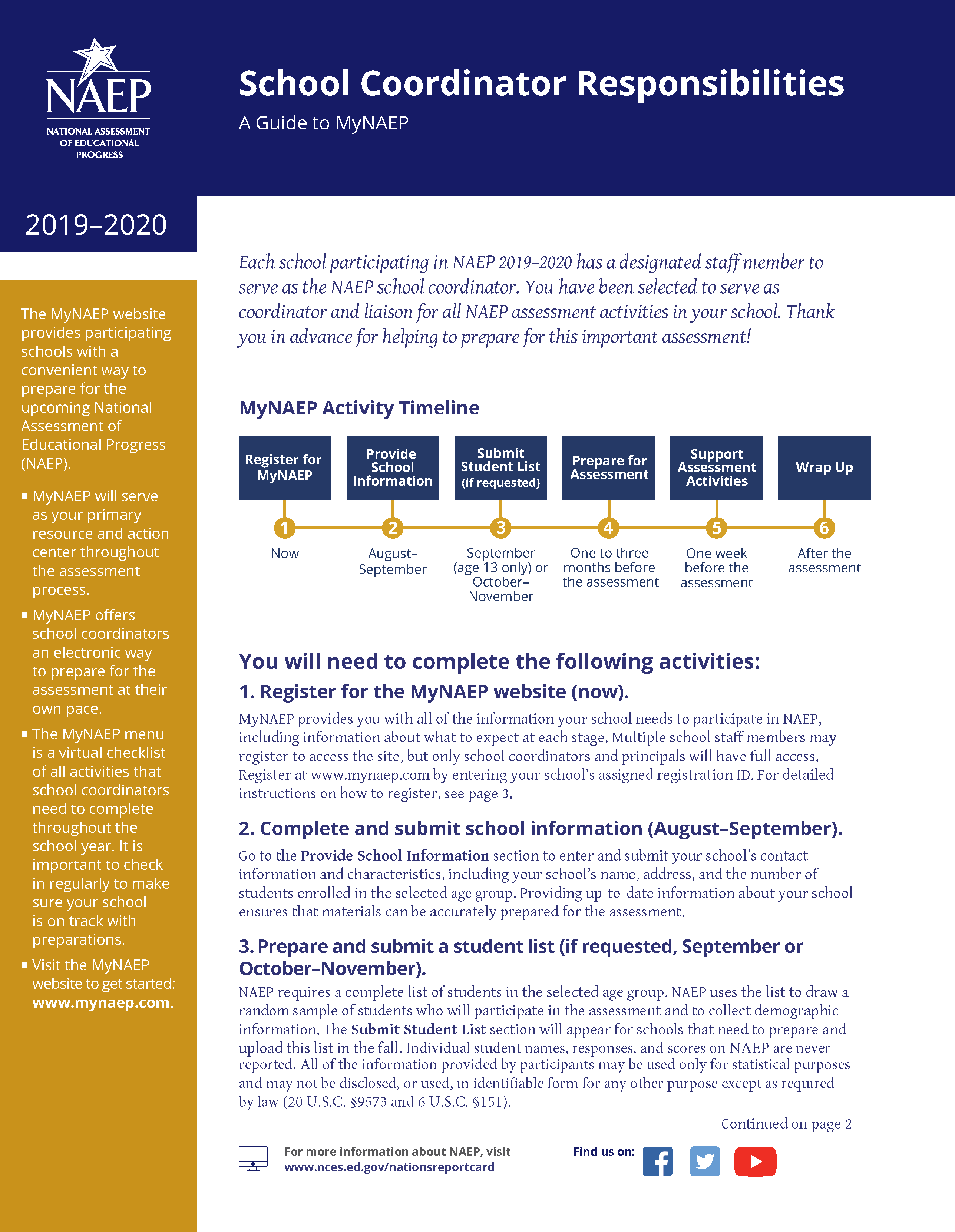
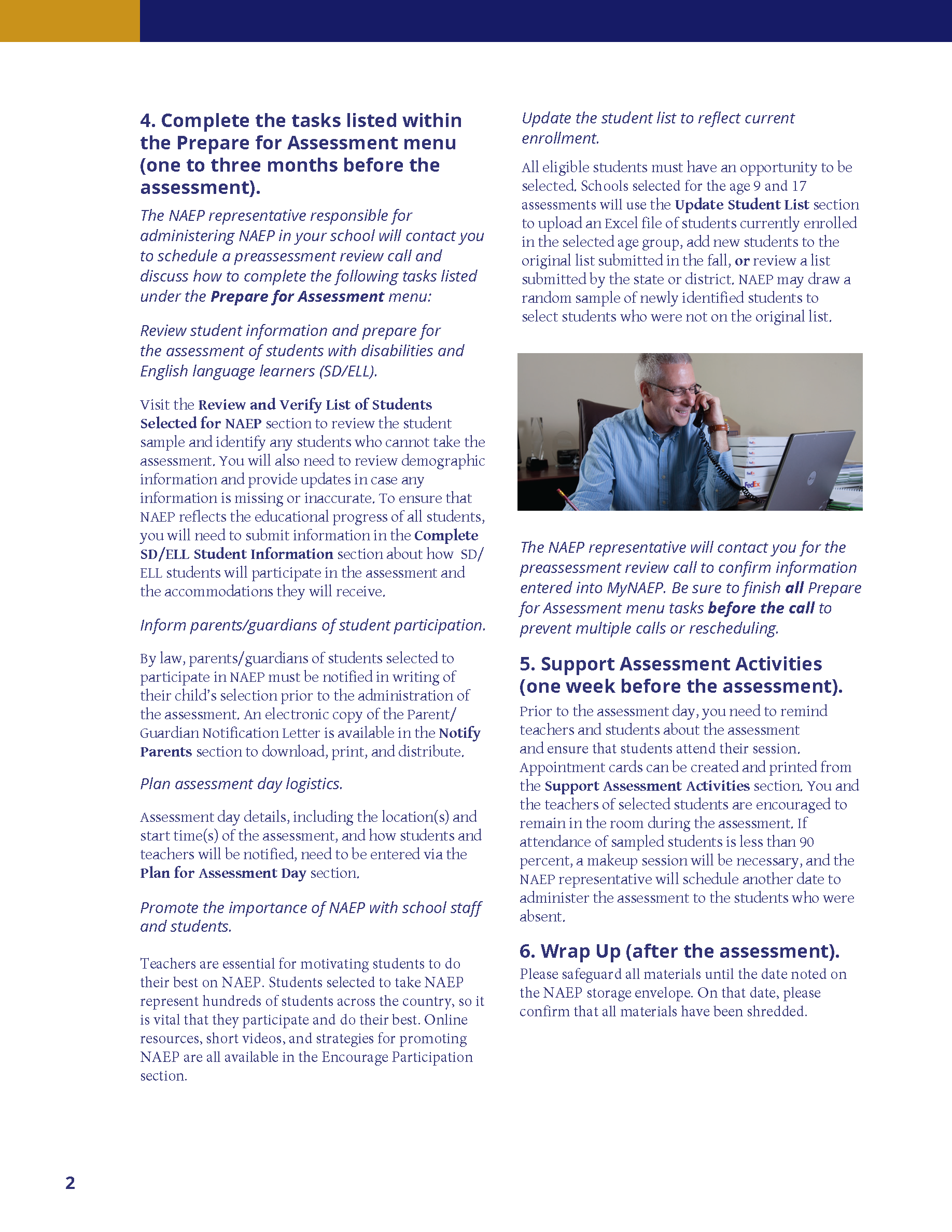

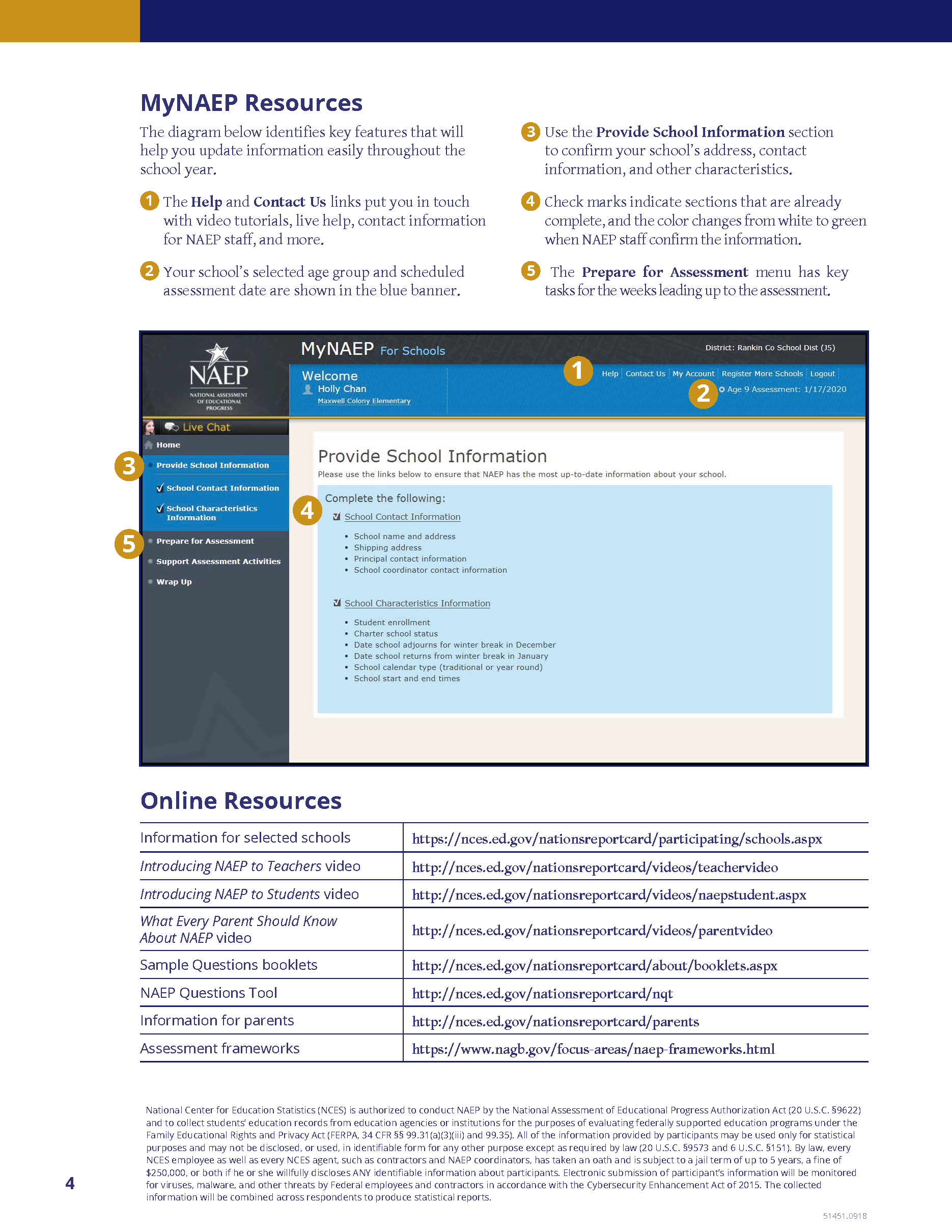
Appendix D3-12: 2020 School Coordinator Responsibilities: A Guide to MyNAEP, Private
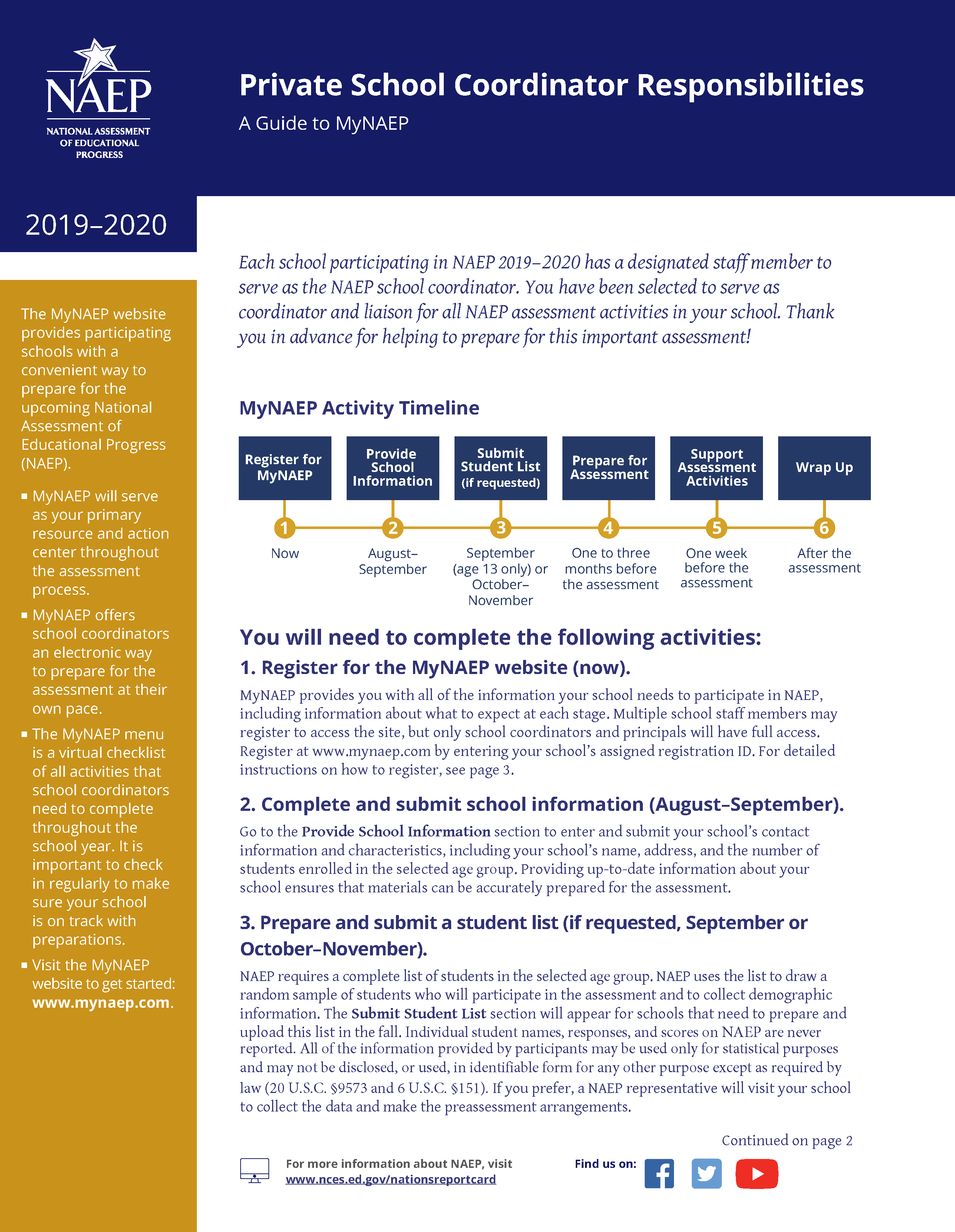
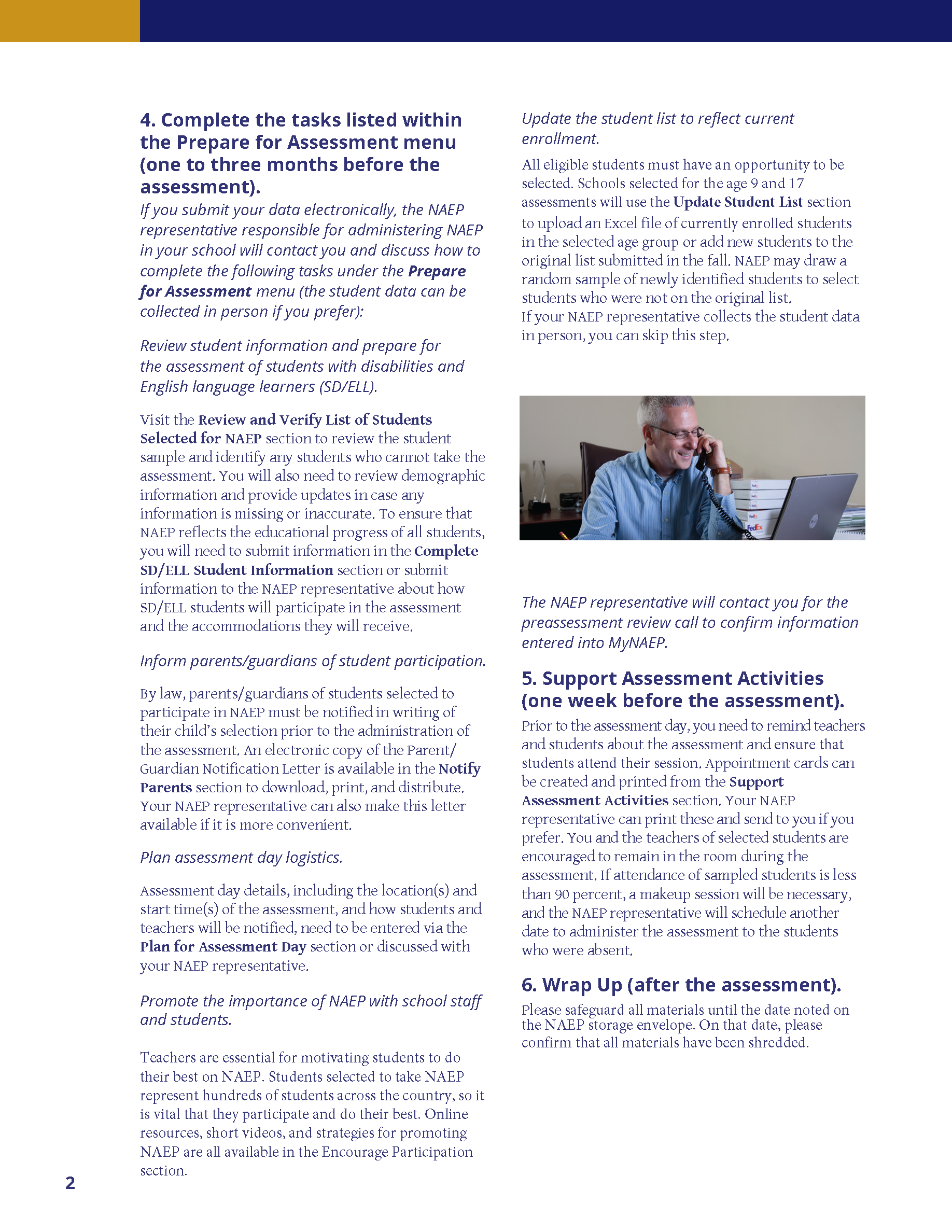
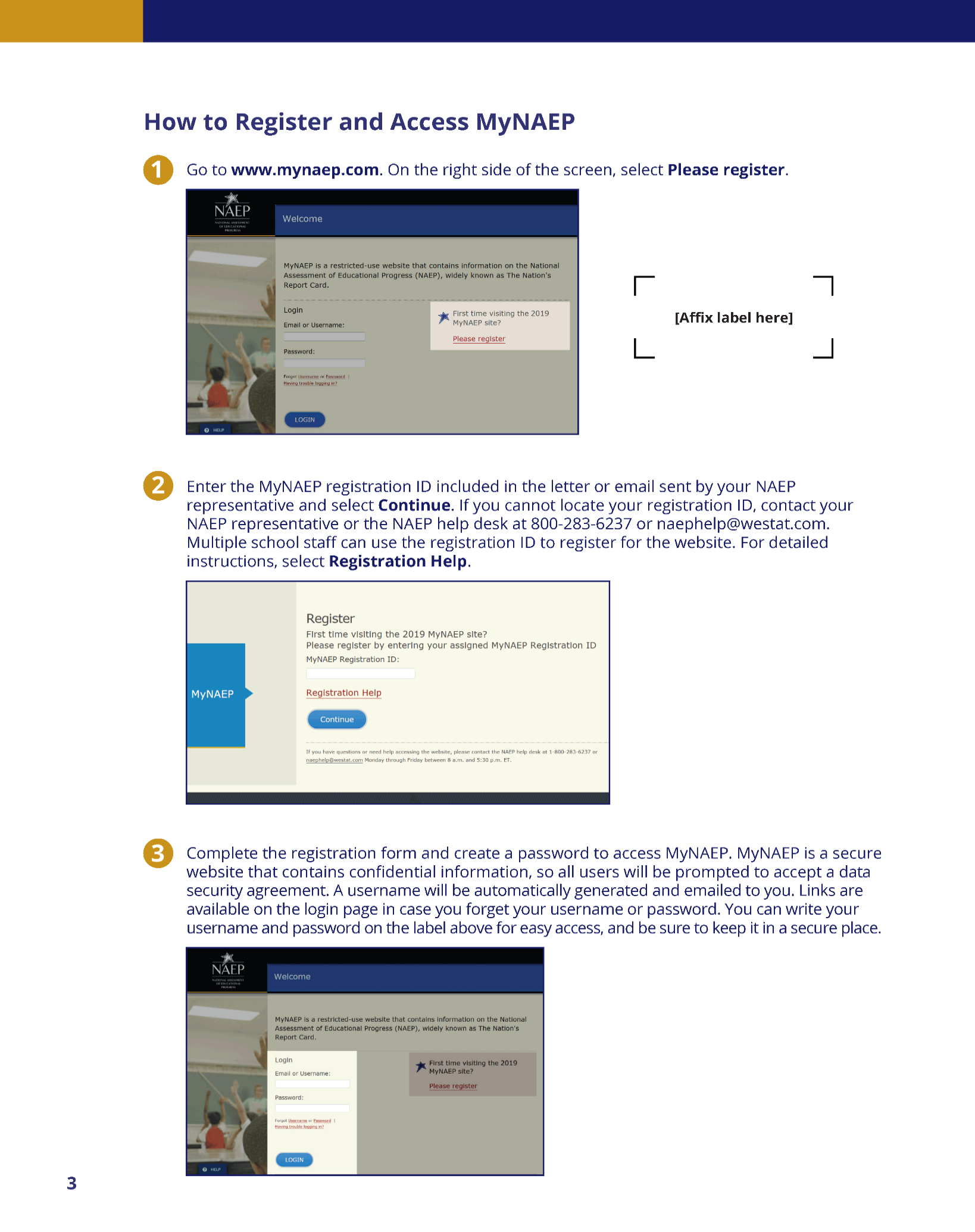

Appendix D3-13: 2019-2020 Assessment Details Letter from NAEP State Coordinator to School Coordinator
NAEP 2019–2020 Assessment Details Letter
NAEP STATE COORDINATOR TO SCHOOL COORDINATOR
Red text should be customized before mail merge, highlighted text represents mail merge fields.
Dear School Coordinator:
Welcome to the 2019–2020 National Assessment of Educational Progress (NAEP). I look forward to working with you to coordinate NAEP at school name. A sample of age-year-old students will take mathematics and reading assessments on assessment date. Each student will take only one assessment.
As the school coordinator, you will have a number of responsibilities critical to making NAEP a success. The MyNAEP website is designed to assist you with these responsibilities. The timeline below indicates when you will need to complete specific MyNAEP sections.
August–September: Register at www.mynaep.com with the following registration ID: MyNAEP Registration ID. Answer the questions in the Provide School Information section by date. For instructions, see the enclosed School Coordinator Responsibilities: A Guide to MyNAEP.
The following red text should only be included for schools that are submitting their own student lists. September (for age 13) October–November (for ages 9 & 17): Prepare and submit a list of all age-year-old students electronically in the Submit Student List section by date. Please see the enclosed Student List Submission Instructions.
September–October (for age 13) November–December (for age 9) February–March (for age 17): An assigned NAEP representative who is responsible for administering the assessment will contact you. At that time, you will log onto the MyNAEP site with the representative and discuss how to complete the Prepare for Assessment section. Major tasks are highlighted below.
Provide information about students with disabilities and English language learners (SD/ELL) so that assessment administrators can plan appropriate testing accommodations. You can request MyNAEP access for your school’s SD/ELL specialists on the Complete SD/ELL Student Information page so that they can assist with this task.
Notify parents/guardians that their children have been selected for the assessment. A sample parent/guardian notification letter is enclosed and will be available on the MyNAEP website for you to customize and print on your school letterhead.
Schedule assessment sessions and reserve space at your school.
The following red text should not be included for long-term trend age 13. Update the student list to add any new students who have enrolled since the fall. NAEP will draw a random sample from this group to ensure that all students have an opportunity to be selected for NAEP.
Participate in a preassessment review call with your assigned NAEP representative. During this call, you will review and confirm information entered into MyNAEP and other assessment details. Be sure to complete all Prepare for Assessment activities before the scheduled call.
One week before the assessment: Visit the Support Assessment Activities section to print student appointment cards and notify teachers in advance so they know when to release students from class.
After the assessment: Safeguard all confidential hardcopy materials until the date noted on the NAEP storage envelope. Shred all materials on the specified date.
During the assessment, we would appreciate the presence of a school staff person as an observer in each session. A staff member’s presence can have a positive impact on students’ motivation and performance.
More information about your responsibilities is provided in the enclosed School Coordinator Responsibilities: A Guide to MyNAEP. Additional information about NAEP can be found at http://nces.ed.gov/nationsreportcard.
Thank you in advance for your cooperation and effort in helping to coordinate this important assessment. If you have any questions, please feel free to contact me at telephone number or email address.
Sincerely,
NAEP State Coordinator
Enclosures: NAEP folder, including the following:
School Coordinator Responsibilities: A Guide to MyNAEP
Student List Submission Instructions
Parent/Guardian Notification Letter
MyNAEP Registration Instructions
National Center for Education Statistics (NCES) is authorized to conduct NAEP by the National Assessment of Educational Progress Authorization Act (20 U.S.C. §9622) and to collect students’ education records from education agencies or institutions for the purposes of evaluating federally supported education programs under the Family Educational Rights and Privacy Act (FERPA, 34 CFR §§ 99.31(a)(3)(iii) and 99.35). All of the information provided by participants may be used only for statistical purposes and may not be disclosed, or used, in identifiable form for any other purpose except as required by law (20 U.S.C. §9573 and 6 U.S.C. §151). By law, every NCES employee as well as every NCES agent, such as contractors and NAEP coordinators, has taken an oath and is subject to a jail term of up to 5 years, a fine of $250,000, or both if he or she willfully discloses ANY identifiable information about participants. Electronic submission of participant’s information will be monitored for viruses, malware, and other threats by Federal employees and contractors in accordance with the Cybersecurity Enhancement Act of 2015. The collected information will be combined across respondents to produce statistical reports.
Appendix D3-14: 2019-2020 Assessment Details Letter from the NAEP State Coordinator to Principals
Early Fall NAEP 2019–2020 Assessment Details Letter
NAEP STATE COORDINATOR TO PRINCIPALS
Red text should be customized before mail merge, highlighted text represents mail merge fields.
Dear principal name:
At the end of the school year, I notified school name of its selection to participate in the National Assessment of Educational Progress (NAEP). I am following up with you to provide additional information about the upcoming assessment.
To prepare for the assessment, please:
Place the NAEP assessment date, assessment date, on your school calendar.
Review the enclosed School Coordinator Responsibilities: A Guide to MyNAEP and designate a NAEP school coordinator to serve as the liaison for all NAEP activities in your school. Give the enclosed folder to your designated NAEP school coordinator. The school coordinator should
know how to collect student information, such as birth dates, demographic information, and if any students have withdrawn;
be comfortable using a computer, since all assessment preparation activities will be completed online; and
be familiar with how students participate in statewide assessments.
A NAEP representative responsible for administering the assessment will contact your school coordinator in September (for age 13), November (for age 9), and/or February (for age 17). During the assessment, we would appreciate the presence of a school staff person as an observer in each session. A staff member’s presence can have a positive impact on students’ motivation and performance.
Again, I would like to express my appreciation for your assistance with this very important assessment of our nation’s students. Our chief state school officer, name, supports NAEP and encourages your students’ participation.
I look forward to collaborating with you and your school coordinator to ensure a successful NAEP administration. If you would like to access the MyNAEP site (www.mynaep.com), please register with this ID number: MyNAEP Registration ID. MyNAEP is a protected site, so you will need to create your own password. Should you have questions, please contact me at telephone number or email address.
Sincerely,
NAEP State Coordinator
Enclosures: NAEP folder for your NAEP school coordinator, including the following:
Letter to your school coordinator
School Coordinator Responsibilities: A Guide to MyNAEP
MyNAEP Registration Instructions
Student List Submission Instructions
Parent/Guardian Notification Letter
National Center for Education Statistics (NCES) is authorized to conduct NAEP by the National Assessment of Educational Progress Authorization Act (20 U.S.C. §9622) and to collect students’ education records from education agencies or institutions for the purposes of evaluating federally supported education programs under the Family Educational Rights and Privacy Act (FERPA, 34 CFR §§ 99.31(a)(3)(iii) and 99.35). All of the information provided by participants may be used only for statistical purposes and may not be disclosed, or used, in identifiable form for any other purpose except as required by law (20 U.S.C. §9573 and 6 U.S.C. §151). By law, every NCES employee as well as every NCES agent, such as contractors and NAEP coordinators, has taken an oath and is subject to a jail term of up to 5 years, a fine of $250,000, or both if he or she willfully discloses ANY identifiable information about participants. Electronic submission of participant’s information will be monitored for viruses, malware, and other threats by Federal employees and contractors in accordance with the Cybersecurity Enhancement Act of 2015. The collected information will be combined across respondents to produce statistical reports.
Appendix D3-15: Facts for Teachers, Public Schools and Private Schools
NAEP 2019–2020 Facts for Teachers
[sidebar text]
NAEP
is an integral part of education in the United States.
NAEP is a congressionally mandated project administered by the National Center for Education Statistics (NCES), within the U.S. Department of Education and the Institute of Education Sciences.
Elected officials, policymakers, and educators all use NAEP results to develop ways to improve education.
NAEP serves a different role than state assessments. While states have their own unique assessments with different content standards, the same NAEP assessment is administered in every state, providing a common measure of student achievement.
Depending on the type of NAEP assessment that is administered, the data can be used to compare and understand the performance of demographic groups within your state, the nation, other states, and districts that participate in the Trial Urban District Assessment (TUDA). NAEP is not designed to collect or report results for individual students, classrooms, or schools.
To provide a better understanding of educational experiences and factors that may be related to student learning, students are asked to complete questionnaires. There are no teacher or school questionnaires in the long-term trend assessments.
[quote]
As an educator, I find the contextual information that NAEP provides to be particularly valuable. It helps me take a closer look at the factors related to student achievement across the country.
Ann M. Finch, Assessment Specialist, Arkansas Department of Education
[body text]
The National Assessment of Educational Progress (NAEP), first administered in 1969, is the largest nationally representative and continuing assessment of what our nation’s students know and can do in various subjects such as civics, geography, mathematics, reading, science, U.S. history, and writing. The results of NAEP are released as The Nation’s Report Card.
[footer text]
For more information about NAEP, visit http://nces.ed.gov/nationsreportcard
Find us on [insert Facebook, Twitter, and YouTube icons]
In fall 2019 and spring 2020, students in participating schools will take the NAEP long-term trend assessments in mathematics and reading at ages 9, 13, and 17. These assessments measure students’ educational progress over time to look for and monitor trends in performance. Learn more about the long-term trend assessments at https://nces.ed.gov/nationsreportcard/ltt.
NAEP representatives will bring all necessary materials to schools on assessment day. Schools will only need to provide space with desks or tables for students to take the assessment. The table below shows which subjects and age groups will be assessed during the 2019–2020 school year. National results will be released for the long-term trend assessment.
|
|||||
Age |
Assessment |
Subjects |
Format |
National Results |
Assessment Window |
9-year-olds |
Long-term trend |
Reading |
Paper & Pencil |
√ |
January 6, 2020 – March 13, 2020 |
Mathematics |
Paper & Pencil |
√ |
|||
13-year-olds |
Long-term trend |
Reading |
Paper & Pencil |
√ |
October 14, 2019 – December 20, 2019 |
Mathematics |
Paper & Pencil |
√ |
|||
17-year-olds |
Long-term trend |
Reading |
Paper & Pencil |
√ |
March 16, 2020 – May 22, 2020 |
Mathematics |
Paper & Pencil |
√ |
|||
NAEP and Teachers
As teachers, you are essential partners in NAEP. You make an important contribution by encouraging your students to participate and do their best. When students take part in NAEP and give their best effort, we get the most accurate measure possible of student achievement across the country. To learn more about NAEP and view FAQs for teachers, visit https://nces.ed.gov/nationsreportcard/educators.
Teachers can use NAEP questions as a helpful educational resource in the classroom. With the NAEP Questions Tool, you can view released NAEP items, create customized assessments for your classroom, and compare your students’ performance with national results. Teachers, students, and parents can access information and also compare results for various demographic groups. Most released items include a scoring guide, sample student responses, and performance data. Visit https://nces.ed.gov/nationsreportcard/nqt to learn more.
In 2019 and 2020, students will be asked to complete the long-term trend survey questionnaire. They may answer as many questions as they like and may skip any question by leaving a response blank. NAEP survey questionnaires provide valuable information about participating students’ educational experiences and opportunities to learn both in and out of the classroom. This information helps put student achievement results into context and allows for meaningful comparison between student groups. It also provides important data and insight for educators, policymakers, and researchers to better understand the educational experiences and needs of students in the United States. There will not be a long-term trend survey questionnaire for teachers or schools in 2019–2020.
To learn more about NAEP survey questionnaires and view long-term trend student questionnaires from previous years, visit https://nces.ed.gov/nationsreportcard/experience/survey_questionnaires.aspx.
New NAEP dashboards allow teachers to explore a variety of NAEP results across subjects. The Achievement Gaps Dashboard lets users explore achievement gaps that reveal significant differences in assessment scores between two groups of students (e.g., male and female students or White and Black students). You can also examine student groups by the type of school they attend with the new Public, Private, and Charter
Schools Dashboard. See how students’ educational experiences vary by school types by viewing the latest national results in all the NAEP subjects for students attending public, charter, private, and Catholic schools.
View the Achievement Gaps Dashboard at https://www.nationsreportcard.gov/dashboards/achievement_gaps.aspx. The Public, Private, and Charter Schools Dashboard is available at https://www.nationsreportcard.gov/dashboards/schools_dashboard.aspx.
NAEP Results
The NAEP 2019–2020 long-term trend assessments will be administered to nationally representative samples of 9-, 13-, and 17-year-old students, and results will be released for the nation only. The long-term trend assessments have monitored student progress in mathematics and reading since the early 1970s.
NAEP results are reported for different demographic groups rather than for individual students or schools. Information is reported by race/ethnicity, gender, type of school, and by both achievement level and scale scores. Within a school, just some of the student population participates, and student responses are combined with those from other participating students to produce the results. Because the privacy of schools and students is essential, the name of each participating student is not associated with a test booklet after that student takes a NAEP assessment. All data collected from NAEP assessment results will be used for statistical purposes only.*
You can access data from previous assessments at https://nces.ed.gov/nationsreportcard/naepdata and explore the most recent results at https://www.nationsreportcard.gov.
[footer text]
* National Center for Education Statistics (NCES) is authorized to conduct NAEP by the National Assessment of Educational Progress Authorization Act (20 U.S.C. §9622). All of the information provided by participants may be used only for statistical purposes and may not be disclosed, or used, in identifiable form for any other purpose except as required by law (20 U.S.C. §9573 and 6 U.S.C. §151). By law, every NCES employee as well as every NCES agent, such as contractors and NAEP coordinators, has taken an oath and is subject to a jail term of up to 5 years, a fine of $250,000, or both if he or she willfully discloses ANY identifiable information about participants. Electronic submission of participant’s information will be monitored for viruses, malware, and other threats by Federal employees and contractors in accordance with the Cybersecurity Enhancement Act of 2015. The collected information will be combined across respondents to produce statistical reports.
Recent NAEP Results
2018 Technology and Engineering Literacy (TEL) Assessment at Grade 8
The average overall TEL score for eighth-grade students was two points higher compared to 2014, the previous assessment year.
Compared to 2014, eighth-grade students also scored higher in all three TEL content areas (Technology and Society, Design and Systems, and Information and Communication Technology) and in all three practices (Understanding Technological Principles, Developing Solutions and Achieving Goals, and Communicating and Collaborating).
The average score in TEL overall was five points higher for females than their male peers.
To learn more about the 2018 TEL results, visit https://www.nationsreportcard.gov/tel.
Now Available! View the National Indian Education Study 2015: A Closer Look online at https://nces.ed.gov/nationsreportcard/nies.
It’s important to know...
NAEP long-term trend assessments measure student performance in mathematics and reading and have allowed the performance of today’s students to be compared with students since the early 1970s. Long-term trend assessments are administered periodically to 9-, 13-, and 17-year-olds.
Main NAEP is administered to fourth-, eighth-, and twelfth-graders in a variety of subjects. For all main NAEP and long-term trend assessments, results are available at the national level. Depending on the assessment year and subject, main NAEP results may also be available at the state level and for large urban districts participating in the TUDA program.
NAEP was first administered in 1969 to measure student achievement nationally. In 1990, NAEP was administered at the state level for the first time. Students in grades 4 and 8 are currently assessed at the national and state levels in mathematics and reading every 2 years and in other subjects periodically. The NAEP TUDA program, which measures student achievement in some of the nation’s large urban districts, began in 2002.
NAEP is considered the gold standard of assessments because of its high technical quality. From the
development of assessment frameworks and questions to the reporting of results, NAEP represents the best thinking of assessment and content specialists, state education staff, and teachers from around the nation. NAEP is a trusted resource that measures student progress and helps inform policy decisions that improve education in the United States.
A carefully designed sampling process ensures that NAEP-selected schools and students are representative of all schools and students across the United States. To ensure that the sample represents all students in the nation’s schools, a broad range of accommodations are allowed for students with disabilities and English language learners.
NAEP is designed to cause minimal disruption of classroom instruction. Including transition time,
directions, and completion of a survey questionnaire, it takes up to 90 minutes for students to complete paper-and-pencil assessments. Each student will be assessed in one format and one subject only. Teachers do not need to prepare their students to take the assessment, but should encourage students to do their best. NAEP representatives provide significant support by working with your school’s designated coordinator to organize assessment activities.
[quote]
The NAEP team that arrived at our school made the assessment process painless.
Everyone on the team previously worked as an educator and interacted well with
all of our students.
- Kimberly Wilborn, Guidance Counselor, Sandburg Middle School, Fairfax County Public Schools, Alexandria, Virginia
More About NAEP
Learn what NAEP means for schools that are selected to participate and get the latest NAEP news in Measure Up: NAEP News for the School Community, available online at https://nces.ed.gov/nationsreportcard/about/schools.aspx.
To hear teachers share their thoughts about why NAEP results are important, view the video Introducing NAEP to Teachers at https://nces.ed.gov/nationsreportcard/videos/teachervideo.
To learn about upcoming NAEP assessments, download NAEP reports, and access sample questions, visit https://nces.ed.gov/nationsreportcard.
For additional assistance, call the NAEP help desk at 800-283-6237.
To find your NAEP state coordinator’s contact information, visit https://nces.ed.gov/nationsreportcard/states and select your state or jurisdiction from the drop-down menu.
[footer text]
The work reported herein was supported under the National Assessment of Educational Progress (ED-07-CO-0078, ED-07-CO-0107) as administered by the National Center for Education Statistics, U.S. Department of Education.
Photo Credit: TBD. Photo is for illustrative purposes only. Any person depicted in the photo is a model."
Get NAEP on the go with the NAEP Results mobile app!
NAEP 2019—2020 FACTS FOR TEACHERS IN PRIVATE SCHOOLS
I'm thankful for the opportunity for our school to participate in NAEP because I believe it leads to useful outcomes for individual schools, private schools specifically, and education generally in our country. I would strongly encourage all private schools to participate if selected, as the data shared will be useful locally and nationally.
— Dr. James A. Thomas, President of Columbia Academy, Columbia, TN
The National Assessment of Educational Progress (NAEP) is the largest continuing and nationally representative assessment of what students in public and private schools know and can do in various subjects. First administered in 1969, NAEP collects and reports information on student trends and performance and compares the achievement of students in public schools with that of students in private schools. Private schools represent about 25 percent of the schools in the nation, educate approximately 9 percent of the nation’s students, and are a critical component of the NAEP program. Private school data are essential to providing a complete and accurate picture of education in the United States and to informing future policy decisions. The results of NAEP are released to the public as The Nation’s Report Card.
All About NAEP
As private school teachers, you are essential partners in NAEP. You make an important contribution by sharing your class time and encouraging your students to participate and do their best. When students take part in NAEP and give their best effort, we get the most accurate measure possible of student achievement across the country.
Teachers can use NAEP questions as a resource in the classroom. Teachers can use the NAEP Questions Tool at http://nces.ed.gov/nationsreportcard/nqt to create online self-scoring tests for students and see how the performance of students in private schools compares nationally with that of public school students on specific items. Released items generally come with a scoring guide, sample student responses, and performance data. Students can try NAEP questions by visiting https://www.nationsreportcard.gov/sample_questions.aspx.
Teachers can watch the NAEP teacher video. The video provides an overview of the assessment as well as tips on how to support students selected to participate. Watch the video at http://nces.ed.gov/nationsreportcard/videos/teachervideo.
Teachers can also view the private school video. Teachers and heads of school describe their experiences with the NAEP assessment and the value of NAEP to private schools in an online video, Private Schools and NAEP: A National Conversation. Watch the video at https://nces.ed.gov/nationsreportcard/participating/private_nonpublic.aspx.
Highlights of the NAEP 2019–2020 Program
From October 2019 and continuing through May 2020, NAEP field staff will administer the long-term trend assessments in mathematics and reading in schools across the country. Long-term trend results can be linked to NAEP assessments first administered in the early 1970s, allowing us to measure progress over a span of nearly 50 years. The age samples for long-term trend assessments are 9-, 13-, and 17-year-olds. The assessment window for each age group is as follows:
Age 13: October 14, 2019 – December 20, 2019
Age 9: January 6, 2020 – March 13, 2020
Age 17: March 16, 2020 – May 22, 2020
Selected students will participate in paper-based mathematics or reading assessments, and each student will be assessed in only one subject. NAEP representatives will bring all materials and equipment to the school on assessment day. Students will spend up to 90 minutes completing the assessment. This includes transition time, directions, and completion of a student survey questionnaire. The questionnaire provides valuable information about students’ educational experiences and opportunities to learn both inside and outside of the classroom. There will be no school or teacher questionnaires for the long-term trend assessment.
It’s important to know that…
NAEP causes minimal disruption for teachers and students. No advance preparation for teachers or for students is necessary. Trained NAEP representatives, employed by a contractor to the National Center for Education Statistics (NCES), administer NAEP.
Including all students is essential. To ensure that student achievement is accurately reported, students with disabilities (SD) and English language learners (ELL) are encouraged to participate in NAEP assessments. Many accommodations are allowed during the assessment, such as extended time, breaks during the test, and a separate setting. Teachers of SD and ELL students selected for the assessment are asked to provide information to determine how these students will be assessed on NAEP.
NAEP data are used for statistical purposes only. No one involved in administering NAEP keeps personal information on teachers or students after the assessments are completed. There are no results for individual students, classrooms, or schools.
How NAEP reports results
Since 1969, NAEP has produced many reports chronicling trends over time in student performance. Results for private schools are generally reported as overall private schools results and for two groups of private schools, Catholic and other private schools.
NAEP also disseminates contextual information from data collected on student survey questionnaires. This information can be used to inform parents, the public, and education policymakers about our students’ educational experiences inside and outside the classroom. You can access data from previous assessments at https://www.nationsreportcard.gov/ndecore/xplore/nde and explore the most recent results at http://nationsreportcard.gov. For a quick, but detailed, look at results for private schools, explore the NAEP Private School Quick Data tool at http://nces.ed.gov/nationsreportcard/about/private_school_quick_data.aspx.
Highlights of the NAEP Long-Term Trend Mathematics Assessment: 1978-2012
The mathematics long-term trend assessments were conducted in various years between 1978 and 2012, measuring performance on objectives developed by nationally representative panels of mathematics specialists, educators, and other interested parties.
Students in private schools generally performed higher on average than students in public schools in mathematics for all three age groups, which includes 9-, 13-, and 17-year-olds. Statistically significant differences between private and public schools are shown with an asterisk.
[GRAPH 1, data source: \\westat.com\dfs\NSSC\Private Schools\NAEP Results Brochure\NAEP LTT Results\Mike's Materials\Data for Jason's Review\Private\LTT Mathematics Age 9.Xls] –DO NOT INCLUDE BRACKETS IN BROCHURE, FOR REFERENCE ONLY

[GRAPH 2, data source: \\westat.com\dfs\NSSC\Private Schools\NAEP Results Brochure\NAEP LTT Results\Mike's Materials\Data for Jason's Review\Private\LTT Mathematics Age 13.Xls] –DO NOT INCLUDE BRACKETS IN BROCHURE, FOR REFERENCE ONLY
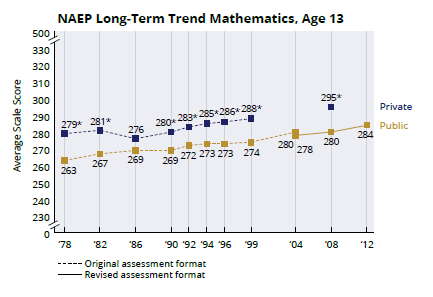
[GRAPH 3, data source: \\westat.com\dfs\NSSC\Private Schools\NAEP Results Brochure\NAEP LTT Results\Mike's Materials\Data for Jason's Review\Private\LTT Mathematics Age 17.Xls] –DO NOT INCLUDE BRACKETS IN BROCHURE, FOR REFERENCE ONLY

[IN A BOX:]
*Significantly different (p < .05) from public schools in the same year.
NOTE: NAEP scale scores in long-term trend mathematics and reading range from 0 to 500.
SOURCE: U.S. Department of Education, Institute of Education Sciences, National Center for Education Statistics, National Assessment of Educational Progress (NAEP), various years, 1978–2012 Long-Term Trend Mathematics Assessments.
National Center for Education Statistics (NCES) is authorized to conduct NAEP by the National Assessment of Educational Progress Authorization Act (20 U.S.C. §9622). All of the information provided by participants may be used only for statistical purposes and may not be disclosed, or used, in identifiable form for any other purpose except as required by law (20 U.S.C. §9573 and 6 U.S.C. §151). By law, every NCES employee as well as every NCES agent, such as contractors and NAEP coordinators, has taken an oath and is subject to a jail term of up to 5 years, a fine of $250,000, or both if he or she willfully discloses ANY identifiable information about participants. Electronic submission of participant’s information will be monitored for viruses, malware, and other threats by Federal employees and contractors in accordance with the Cybersecurity Enhancement Act of 2015. The collected information will be combined across respondents to produce statistical reports.
Appendix D3-16: Templates for State Specific SD Inclusion Policy
The New Moldavia Department of Education expects that most students with disabilities will be included on the National Assessment of Educational Progress (NAEP). Only students who meet (or met) participation criteria for the Name of Alternate Assessment based on Alternate Achievement Standards may be excluded from any NAEP assessment. All other students with disabilities should participate in NAEP with or without NAEP-allowed accommodations. If you have questions about the NAEP accommodations, please contact NSC name, NAEP State Coordinator at email address or phone number.
Several accommodations provided on the New Moldavia assessments are not necessary for the NAEP assessments because they are available for all students through universal design elements. The chart below is divided into two sections: (1) universal design elements that will be available to all students and (2) accommodations. NAEP accommodations are only allowed for a student on an Individualized Education Program (IEP) or Section 504 Plan. The person most knowledgeable about the student’s disability should determine how the student should be included on NAEP.
Please keep in mind that NAEP does not produce results for individual students or schools, unlike the New Moldavia state assessments. In other words, the NAEP assessments do not impose consequences for the student or the school and are instead intended purely to provide a picture of educational performance and progress.
Please note all assessments are not the same and are developed to measure specific constructs. Therefore, NAEP may not allow or provide all accessibility features and accommodations of the New Moldavia state assessments. The following are the expectations for inclusion on NAEP:
For mathematics: calculator, manipulatives, and multiplication charts are not allowed on the NAEP assessment. The NAEP Long-Term Trend (LTT) mathematics assessment measures the ability to carry out mathematic computations using paper and pencil.
For reading: read aloud occasional or most or all is not allowed on the NAEP assessment. The NAEP LTT reading assessment measures reading comprehension by asking students to read passages written in English and to answer questions about what they have read. Because this is an assessment of reading comprehension and not listening comprehension, NAEP does not allow passages or items to be read aloud to students as testing accommodations.
Students who receive multiple-day testing on the state assessments should take the NAEP assessments in 1 day with breaks as needed. NAEP is much shorter than the state assessments, so multiple-day testing is not supported. Students complete three 15-minute sections in mathematics or reading and a 5-minute student questionnaire on student experiences inside and outside of the classroom.
Graphic organizers are not allowed on the NAEP assessment.
NAEP Universal Design Elements for Students with Disabilities (SD) Ages 9, 13, & 17 Math and Reading Paper-and-Pencil Assessments |
||
Universal Design Element |
Subject |
Description |
Marks/Writes Directly in Test Book |
Math Reading |
All students write directly in the test book. NAEP does not have Scantron or bubble sheets. |
Directions Explained/Clarified |
Math Reading |
Student can raise his or her hand at any time and ask the test administrator to clarify or explain directions. |
Scratch Paper |
Math Reading |
Administrators inform students that they can use the white space in the test booklet as scratch paper. |
NAEP Accommodations for Students with Disabilities (SD) Ages 9, 13, & 17 Math and Reading Paper-and-Pencil Assessments |
||
Accommodation |
Subject |
Description |
Extended Time |
Math Reading |
Student is given up to three times (3X) the allotted time to complete the assessment.
|
Small Group |
Math Reading |
Group includes no more than five students. A student can be assigned to a small group session because:
|
One-on-One |
Math Reading |
Student is assessed individually in an area free of distractions. |
Read Aloud in English–Directions Only |
Math Reading |
General directions (the same for all students) and/or subject-specific directions are read aloud, repeated, or reworded in any way in English so that the student understands what to do.
|
Read Aloud in English–Occasional |
Math |
Student may request to have words, phrases, or sentences read aloud in English. |
Read Aloud in English–Most or All |
Math |
Student may request to have most or all of the assessment read aloud in English. |
Breaks During Test |
Math Reading |
Student is allowed to take breaks as requested or at predetermined intervals during the assessment. This could also mean that the student can take the assessment in more than one sitting during a single day. |
Use Computer/Tablet to Respond |
Math Reading |
Student records answers using a computer or tablet provided by the school. |
Familiar Person Present or Administer the Test |
Math Reading |
School staff member familiar to the student must be present during the assessment or administer the test. |
Scribe |
Math Reading |
Scribe provided by the school. Student responds orally or by pointing to his or her answers to a scribe who records the student’s responses in the booklet. |
Large Print Version of the Test |
Math Reading |
NAEP provides large-print booklets to visually impaired students.
|
Magnification Equipment |
Math Reading |
Lens or system provided by the school that enhance visual function. Magnification devices include:
|
Uses Template |
Math Reading |
Provided by the school.
|
Special Equipment |
Math Reading |
Provided by the school.
|
Preferential Seating |
Math Reading |
Provided by the school.
|
Cueing to Stay on Task |
Math Reading |
Provided by a school staff member.
|
Braille Version of the Test |
Math Reading |
A paper-based embossed Braille form. NAEP uses contracted Unified English Braille (UEB) for all subjects. For the mathematics and science assessments, NAEP uses UEB plus Nemeth.
|
Directions Only Presented in Sign Language |
Math Reading |
A qualified sign language interpreter provided by the school signs the instructions included in the session script. |
Presentation in Sign Language |
Math |
A qualified sign language interpreter provided by the school signs the instructions included in the session script and some or all of the test questions or answer choices for the student. |
Response in Sign Language |
Math Reading |
Student signs his or her responses to a scribe provided by the school who records the student’s responses in the booklet (select Scribe accommodation). |
Other (specify) |
Math Reading |
Any accommodation not listed above. Please check with your NAEP State Coordinator to see if other accommodations are allowed on NAEP. |
Appendix D3-17: Templates for State Specific ELL Inclusion Policy
The New Moldavia Department of Education expects that most English language learners will be included on the National Assessment of Educational Progress (NAEP). Only English language learners who have been enrolled in U.S. schools for less than one (1) full academic year before the NAEP assessment and cannot access NAEP may be excluded from any NAEP assessment. All other English language learners should participate in NAEP with or without NAEP-allowed accommodations. If you have questions about the NAEP accommodations, please contact NSC name, NAEP State Coordinator at email address or phone number.
Several accommodations provided on the New Moldavia assessments are not necessary for the NAEP assessments because they are available for all students through universal design elements. The chart below is divided into two sections: (1) universal design elements that will be available to all students and (2) accommodations. NAEP accommodations are only allowed for English language learners. The person most knowledgeable about the student’s English language proficiency should determine how the student should be included on NAEP.
Please keep in mind that NAEP does not produce results for individual students or schools, unlike the New Moldavia state assessments. In other words, the NAEP assessments do not impose consequences for the student or the school and are instead intended purely to provide a picture of educational performance and progress.
Please note all assessments are not the same and are developed to measure specific constructs. Therefore, NAEP may not allow or provide all accessibility features and accommodations of the New Moldavia state assessments. The following are the expectations for inclusion on NAEP:
Students who receive multiple-day testing on the state assessments should take the NAEP assessments in 1 day with breaks as needed. NAEP is much shorter than the state assessments, so multiple-day testing is not supported. Students complete three 15-minute sections in mathematics or reading and a 5-minute student questionnaire on student experiences inside and outside of the classroom.
For reading: read aloud occasional or most or all is not allowed on the NAEP assessment.
Graphic organizers are not allowed on the NAEP assessment.
NAEP Universal Design Elements for English Language Learners (ELL) Ages 9, 13, & 17 Math and Reading Paper-and-Pencil Assessments |
||
Universal Design Element |
Subject |
Description |
Marks/Writes Directly in Test Book |
Math Reading |
All students write directly in the test book. NAEP does not have Scantron or bubble sheets. |
Directions Explained/Clarified |
Math Reading |
Student can raise his or her hand at any time and ask the test administrator to clarify or explain directions. |
Scratch Paper |
Math Reading |
Administrators inform students that they can use the white space in the test booklet as scratch paper. |
NAEP Accommodations for English Language Learners (ELL) Ages 9, 13, & 17 Math and Reading Paper-and-Pencil Assessments |
||
Accommodation |
Subject |
Description |
Extended Time |
Math Reading |
Student is given up to three times (3X) the allotted time to complete the assessment.
|
Small Group |
Math Reading |
Group includes no more than five students. A student can be assigned to a small group session because:
|
One-on-One |
Math Reading |
Student is assessed individually in an area free of distractions. |
Read Aloud in English–Directions Only |
Math Reading |
General directions (the same for all students) and/or subject-specific directions are read aloud, repeated, or reworded in any way in English so that the student understands what to do.
|
Read Aloud in English–Occasional |
Math |
Student may request to have words, phrases, or sentences read aloud in English. |
Read Aloud in English–Most or All |
Math |
Student may request to have most or all of the assessment read aloud in English. |
Breaks During Test |
Math Reading |
Student is allowed to take breaks as requested or at predetermined intervals during the assessment. This could also mean that the student can take the assessment in more than one sitting during a single day. |
Use Computer/Tablet to Respond |
Math Reading |
Student records answers using a computer or tablet provided by the school. |
Familiar Person Present or Administer the Test |
Math Reading |
School staff member familiar to the student must be present during the assessment or administer the test. |
Uses Template |
Math Reading |
Provided by the school.
|
Special Equipment |
Math Reading |
Provided by the school.
|
Preferential Seating |
Math Reading |
Provided by the school.
|
Cueing to Stay on Task |
Math Reading |
Provided by a school staff member.
|
Bilingual Dictionary (in any language) |
Math |
A handheld electronic or hardcopy bilingual dictionary provided by the school in any language that contains English translations of words but does not contain definitions.
|
General Directions Only Read Aloud in Spanish |
Math Reading |
The general session script instructions are read aloud in Spanish. Session script is the same for all students. |
Spanish/English Version of the Test |
Math Not Provided for Age 17 |
Spanish/English version of the booklet.
|
Test Items Read Aloud in Spanish |
Math Not Provided for Age 17 |
Student may request to have words, phrases, or sentences read aloud in Spanish.
|
Other (specify) |
Math Reading |
Any accommodation not listed above. Please check with your NAEP State Coordinator to see if other accommodations are allowed on NAEP. |
Appendix D3-18: Best Practices for Students


Dear School Principal,
Your school is very important to The Nation’s Report Card. The National Assessment of Educational Progress (NAEP) is the largest continuing and nationally representative measure of what students in the United States know and can do in various subjects. In preparation for the NAEP 2019–2020 program, The Best Practices were developed as a comprehensive set of resources that your school can use to promote and motivate high school participation in NAEP. NAEP 2019–2020 will be administered to a nationally representative sample of 17-year-olds. Selected students will participate in paper-based mathematics or reading long-term trend assessments, and each student will be assessed in only one subject. The results of the long-term trend assessment will be released as The Nation’s Report Card. Since NAEP is designed to assess a representative sample of our nation’s students, the accuracy of NAEP relies on the full participation of you, your teachers, and students.
High School NAEP Participation
Historically, high school student participation in NAEP has been a challenge. Student participation reached an all-time low in 2005—only 66 percent of sampled high school students participated. Both low participation and low motivation can undermine the validity and credibility of NAEP results for high school students. As the graph below demonstrates, NAEP participation has increased significantly with the implementation of Best Practices in 2007. Although the graph shows a small decline in subsequent years, student participation rates are still far better than in 2005. Each year, strategies and resources from Best Practices offer schools an opportunity to renew efforts to encourage students to participate.
NAEP School and Student Participation Rates for Public Schools: Grade 12
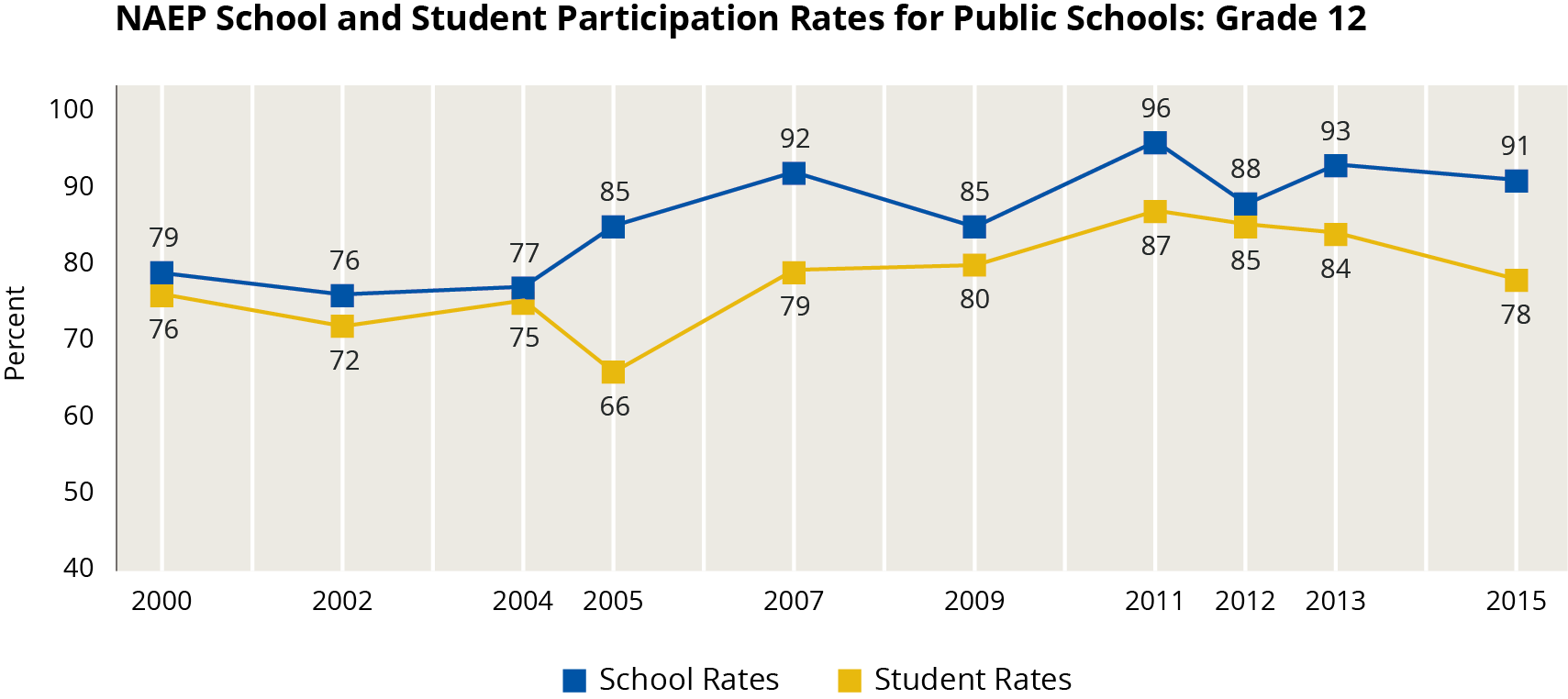
Recommendations from the Secondary School Principals’ Working Group
Best Practices was created after NCES convened a Secondary School Principals’ Working Group in 2005 to address high school participation rates. After discussing participation rates, student motivation, and high school student results, the working group concluded that the results did not reflect the true level of achievement of their students. The working group also concluded that high school principals and other school leaders could help improve participation rates by obtaining teacher buy-in and motivating students to take the assessment and do their best, and that best practices for achieving high participation should be shared with principals. Their recommendations set the stage for the initial Best Practices prepared for the 2007 assessment.
Preparing for NAEP 2019–2020
The Best Practices: Strategies for Supporting High School NAEP Participation is an all-digital toolkit —organized this year around the theme “Our Schools & Students, One collective Impact!” You can download more than 15 customizable resources and templates directly from www.mynaep.com. Select and implement the strategies that work best for your school from the many resources listed below.
Prepare & Schedule |
Work with Teachers |
Motivate Students |
Inform Parents |
Student Notification Letter |
Introducing NAEP to Teachers Video |
Introducing NAEP to Students Video |
Parent/Guardian Notification Letter |
Morning Announcement Template |
Talking Points for Principals to Teachers |
Talking Points for Teachers to Students |
Talking Points for Principals and Teachers to Parents |
Social Media Posts |
Measure Up Newsletter |
Certificate of Appreciation and Community Service |
The Nation’s Report Card Website |
NAEP in Your School |
Introducing NAEP to Teachers PowerPoint |
Introducing NAEP to Students PowerPoint |
Introducing NAEP to Parents PowerPoint |
Facts for Principals
|
NAEP Questions Tool |
High School Incentive Ideas |
What Every Parent Should Know About NAEP Brochure |
In addition, in the months leading up to the assessment, you will receive four tailored emails that provide targeted resources you can use to motivate the teachers, students, and parents at your school. Each email will highlight effective strategies for encouraging participation and will link to the above resources.
What is in your box?
Enclosed with this letter you are also receiving a Best Practices box kit. It contains a lanyard and flash drive pre-downloaded with resources and customizable templates that you can access on the go. You are also receiving a set of specially-designed student invitation cards that you may distribute to participating high school students.
If you have any questions about Best Practices or the upcoming NAEP assessment, please contact me at NSC email or NSC phone number. The NAEP 2019–2020 assessment is another opportunity to show the public and everyone around the world, what our students know and can do in core subjects.
Sincerely,
NSC Name
National Center for Education Statistics (NCES) is authorized to conduct NAEP by the National Assessment of Educational Progress Authorization Act (20 U.S.C. §9622) and to collect students’ education records from education agencies or institutions for the purposes of evaluating federally supported education programs under the Family Educational Rights and Privacy Act (FERPA, 34 CFR §§ 99.31(a)(3)(iii) and 99.35). All of the information provided by participants may be used only for statistical purposes and may not be disclosed, or used, in identifiable form for any other purpose except as required by law (20 U.S.C. §9573 and 6 U.S.C. §151). By law, every NCES employee as well as every NCES agent, such as contractors and NAEP coordinators, has taken an oath and is subject to a jail term of up to 5 years, a fine of $250,000, or both if he or she willfully discloses ANY identifiable information about participants. Electronic submission of participant’s information will be monitored for viruses, malware, and other threats by Federal employees and contractors in accordance with the Cybersecurity Enhancement Act of 2015. The collected information will be combined across respondents to produce statistical reports.
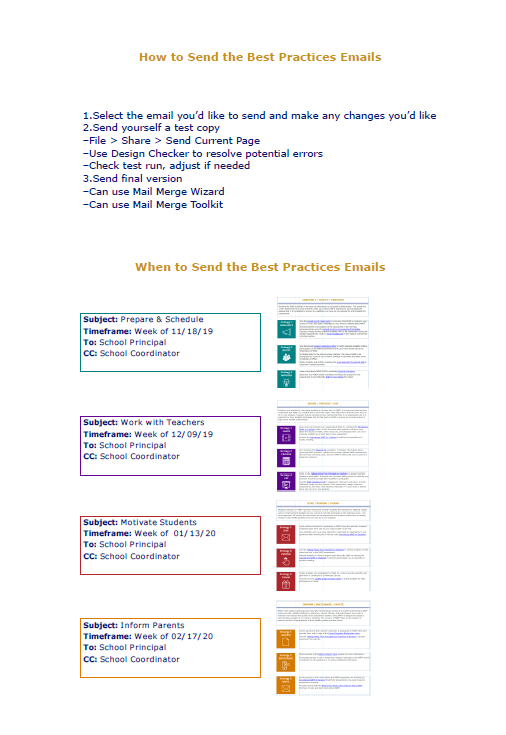
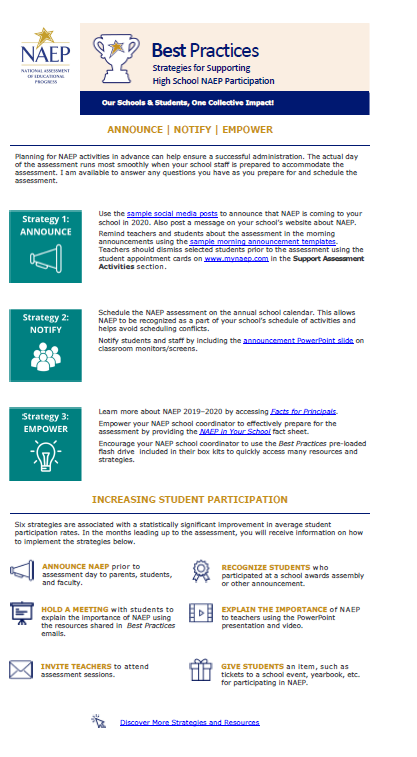
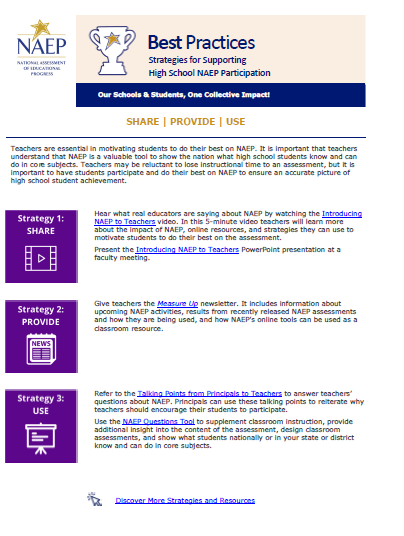
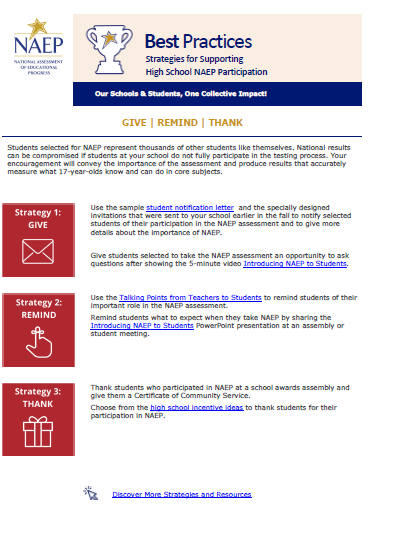


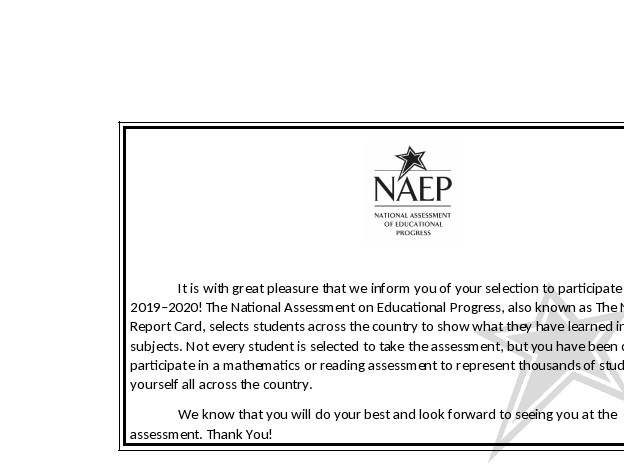
Appendix D3-19: References for Best Practices
Prepare & Schedule |
Work with Teachers |
Motivate Students |
Inform Parents |
Student Notification Letter (Page 73) |
Introducing NAEP to Teachers Video (See scripts in Appendix D1-11) |
Introducing NAEP to Students Video (See scripts in Appendix D1-11) |
Parent/Guardian Notification Letter (Appendix D3-7 & D3-8 or D3-20 & D3-21 (Spanish)) |
|
|
|
|
Morning Announcement Template (Page 74) |
Talking Points for Principals to Teachers (Page 78) |
Talking Points for Teachers to Students (Page 80) |
Talking Points for Principals and Teachers to Parents (Page 79) |
|
|
|
|
Social Media Posts (Pages 75-77) |
Measure Up Newsletter (Pages 94-97) |
Certificate of Appreciation and Community Service (Pages 81 & 82) |
The Nation’s Report Card Website (Pages 84-92) |
|
|
|
|
NAEP in Your School
(Appendix D3-4 & D3-5) |
Introducing NAEP to Teachers PowerPoint (Pages 98-112) |
Introducing NAEP to Students PowerPoint (Pages 133-148) |
Introducing NAEP to Parents PowerPoint (Pages 113-132) |
|
|
|
|
Facts for Principals (Appendix D3-2)
|
NAEP Questions Tool
|
High School Incentive Ideas (Page 83) |
What Every Parent Should Know About NAEP Brochure (Appendix D1-p.97) |
The table below is a recreation of the table shown in the Best Practices in Appendix D3-18, on page 64
Below each communication material title, a notation provides a reference to the active web link, page
number in Appendix D3 or if it is located in Appendix D1.

 Notification
Letter
Notification
Letter
For Students
Dear Student:
Congratulations! You have been selected to participate in this year’s National Assessment of Educational Progress, also known as NAEP. As a select participant, your test results will be part of what’s called The Nation’s Report Card! It is the most important assessment of what students from across the country know and can do in a variety of subject areas. It is different from our state assessments because it represents seventeen-year-old students across the country, not just those here in [state]. It is also different from the SAT and ACT because it focuses on student progress across several age levels.
Not every student is selected to take it, but you have been chosen to represent thousands of your peers in this important assessment. Your participation will provide a snapshot of what students from across the country have learned in school, which in turn will inform major decisions about how to improve the education system in the United States. In short, it’s important that you take part and give it your best effort!
You will take NAEP at [time, date, location] with other selected students. NAEP takes around 90 minutes, and you don’t need to study for it. You will take a mathematics or a reading assessment. Upon completion of the assessment, you will receive a Certificate of Community Service. Your scores will be anonymous and will NOT affect your grades or academic record in any way.
If you have any questions or would like to review sample questions, please ask [insert name of school contact person]. He/she will be happy to help. You can also visit http://nces.ed.gov/nationsreportcard/students for more information.
We are fortunate that our school has been selected to participate in NAEP and we are excited to have you take the assessment. We know that you will do your best and help us accurately represent the achievement of our students.
Sincerely,
(School Principal)
All of the information provided by participants may be used only for statistical purposes and may not be disclosed, or used, in identifiable form for any other purpose except as required by law (20 U.S.C. §9573 and 6 U.S.C. §151). By law, every NCES employee as well as every NCES agent, such as contractors and NAEP coordinators, has taken an oath and is subject to a jail term of up to 5 years, a fine of $250,000, or both if he or she willfully discloses ANY identifiable information about participants. Electronic submission of participant’s information will be monitored for viruses, malware, and other threats by Federal employees and contractors in accordance with the Cybersecurity Enhancement Act of 2015. The collected information will be combined across respondents to produce statistical reports.
![]()
S chool
Announcement
chool
Announcement
Templates
Initial morning announcement
Good morning, students and teachers. I am excited to announce that our school has been selected to participate in the 2019–2020 National Assessment of Educational Progress, also known as NAEP. It is the largest continuing and nationally representative assessment of what students across the country know and can do in a variety of subjects. Some of our seventeen-year-olds have been selected to take assessments in math or reading. To those who have been selected for this important test, you have all our support, and I have NO doubt that you will represent us well! More details to follow as we move closer to our school’s assessment day. Thank you in advance for your involvement.
Morning announcement used in the month leading up to NAEP assessment (possibly read once per week or bi-weekly)
Good morning, students and teachers. The countdown to the NAEP assessment is underway. We are only ___ days away from NAEP Day on [Date] when some of our seventeen-year-olds will take this important assessment to measure our nation’s educational progress. Students and teachers, if you have any questions, please reach out to ____our School’s NAEP coordinator. Thank you.
Morning announcement used the day of the NAEP assessment
Good morning, students and teachers. NAEP Day is finally here! I would like to remind everyone that today some of our seventeen-year-olds will be participating in the National Assessment of Educational Progress. Teachers, please be sure to release those students 5-minutes before the assessment is scheduled to begin. For those students who are participating, please report to your designated locations on time. You are playing an important role in our nation’s ability to measure what students across the country are learning. What’s more, by taking the assessment, you are having an impact on the future of education for the students who follow you. Do your best and good luck. Thank you.
![]()
 Social
Media
Social
Media
Sample Announcements
If your school uses Twitter and/or Facebook to communicate with parents, students, and teachers, you can use both platforms to communicate the importance of the assessment to teachers and to encourage student participation. The following tweets and Facebook posts are available for you to customize before posting to your school’s social media channels. When customizing, Facebook posts containing 200 characters of text or less and tweets containing less than 110 characters of text work best.
In addition, you can follow NAEP’s social media accounts as we regularly share resources, results, and tools for working with NAEP that states also share on their pages to prepare for participation in the assessments. Find our social media accounts below.
h![]() ttps://www.facebook.com/NationalAssessmentofEducationalProgress/
ttps://www.facebook.com/NationalAssessmentofEducationalProgress/
h![]()
![]() ttps://twitter.com/@NAEP_NCES
ttps://twitter.com/@NAEP_NCES
https://www.youtube.com/user/TheNationsReportCard
Scheduling Information
F |
T |
Our school will have the chance to make a difference in education on [DATE]! Learn why our participation in NAEP is important at https://go.usa.gov/xycJE. |
We’re excited to announce our school will participate in #NAEP on [DATE]! Learn about this national assessment at https://go.usa.gov/xycJE. |
A group of our seventeen-year-olds will represent thousands of others across the country on [DATE]! Known as The Nation’s Report Card, NAEP is the largest nationally representative and continuing assessment of what students in the United States know and can do in a variety of subjects. Learn more at https://go.usa.gov/xycJE. |
#NAEP will be administered to select seventeen-year-olds at our school on [DATE]. To learn more about the program, visit https://go.usa.gov/xycJE. |
Something big is happening on [DATE]. A group of our seventeen-year-olds will participate in #NAEP that day! Learn more at https://go.usa.gov/xycJE. |
![]()
Information for Teachers
F |
T |
Teachers, how much do you know about NAEP? What does NAEP mean for you and your students? Hear what other teachers are saying at https://youtu.be/zR1_pUdSlFg. |
#Teachers, do you know why our #student participation in #NAEP is important? Find out: https://go.usa.gov/xycJE. |
NAEP results help us better understand how our students are performing academically across the United States. Learn more about why participation is important at https://go.usa.gov/xycJE. |
Some of our seventeen-year-olds have been selected to participate in #NAEP! Discover what other #teachers are saying at http://youtu.be/zR1_pUdSlFg. |
#Teachers, find out the types of questions your #students will see on #NAEP with the NAEP Questions Tool: https://go.usa.gov/xycJf. |
Information for Students
F |
T |
Students, don’t forget! If you have been selected to take NAEP, your participation is essential for understanding what students across the country have learned in school. Warm up your mental gears by checking out the NAEP Test Yourself tool at http://bit.ly/2cm6NBa. |
The “AEP” in #NAEP does not stand for “Atomic Endangered Penguins!” Hear what other students have to say at http://youtu.be/8drjkhe0iQU. |
What is NAEP? Learn the answer to this question and more at https://youtu.be/8drjkhe0iQU. |
You don’t have to study for #NAEP, but your participation is still important. Find out why: http://bit.ly/2ciTxeH. |
Curious about the types of questions you can expect to see on #NAEP? Check out the NAEP Test Yourself tool at http://bit.ly/2cm6NBa. |
![]()
Information for Parents
F |
T |
Parents, if your seventeen-year-old has been selected to take NAEP, he or she will represent thousands of other students across the United States. Discover other reasons why participation is so important at https://go.usa.gov/xycJG. |
Mark your calendars, parents! Our school will participate in #NAEP on [DATE]. Learn more about the assessment at https://go.usa.gov/xycJG. |
Do you have any burning questions about NAEP and your child’s involvement? The wait is over! Learn the answers to your questions and more by visiting https://go.usa.gov/xycJG. |
If your child has been selected to participate in #NAEP, find more information about the assessment at https://go.usa.gov/xycJG. |
Why is your child’s participation in #NAEP important? Find out by visiting https://go.usa.gov/xycJG. |
![]()
 Talking
Points
Talking
Points
Principals to Teachers
What is NAEP?
The National Assessment of Educational Progress (NAEP) is the largest continuing and nationally representative assessment that shows what students across the country know and can do in various subjects. It is different from our state assessments and even the SAT and ACT because it represents seventeen-year-old students across the country, not just those here in our state or those who plan to go on to college.
Why should I encourage my students to participate?
NAEP is an important and integral part of education in the United States. The results of NAEP are released as The Nation’s Report Card. Encouraging your students to participate and do their best gives them the opportunity to show how well our nation’s students perform.
Elected officials, policymakers, and educators all use NAEP results to develop ways to improve education.
NAEP provides a common measure of student achievement across the country.
NAEP data can be used to compare and understand the performance of demographic groups within your state, the nation, and select urban districts.
Teachers can use sample NAEP questions and scoring guides as a resource for understanding student performance.
What do I have to do?
Your students will need to be out of class for about 90 minutes for the assessment. You do not have to do anything to prepare for the assessment; you just need to release students from class and encourage them to do their best. Each student represents thousands of other seventeen-year-old students across the nation, so it is important that they participate and do their best.
 Talking
Points
Talking
Points
Principals and Teachers to Parents
What is NAEP?
The National Assessment of Educational Progress, or NAEP, is often called the gold standard of assessments and has been around since 1969. It’s called The Nation’s Report Card because it tells us how students across the country are doing. It is different from any of the other tests your child takes in school – including state assessments and even the SAT and ACT – because it represents all seventeen-year-old students in the United States, not just those in our state or those who plan to go on to college. As the largest national test, the results are found in the headlines of national and local news stories all over the country.
Why should I encourage my child to participate?
NAEP is a window into the state of our educational system and what students are learning. It opens the door for parents to understand how well children like theirs are doing compared to other students in participating large urban districts, other states, the nation, and the rest of the world. Your child has been selected to represent other students like him or her across the country. Not every student or every school takes the test, and your child can help to show the country just how much all our high school students know and can do in a variety of subjects. The results of NAEP help the President, Congress, and educators make informed decisions about how to improve our education system. When your child participates, he or she is making a difference.
What does my child have to do?
If your child is selected to participate in the assessment, he or she will need to be out of class for about 90 minutes. The results are anonymous and your child’s grades won’t be affected. We encourage students to get a good amount of sleep the night before and to eat breakfast that morning. Please encourage your child to do his or her best.
Where can I find more information on NAEP?
Visit The Nation’s Report Card online at www.nces.ed.gov/nationsreportcard and dig deeper into topics such as:
How your child was selected
NAEP accommodations
NAEP scoring
Also, access the NAEP parent brochure at http://nces.ed.gov/pubsearch/pubsinfo.asp?pubid=2012469.
 Talking
Points
Talking
Points
Principals and Teachers to Students
What is NAEP?
NAEP stands for the National Assessment of Educational Progress. You may know it as The Nation’s Report Card. It’s the largest continuing and nationally representative assessment of what students across the country know and can do in various subjects. It is different from our state assessments and even the SAT and ACT because it represents all seventeen-year-old students across the country, not just those here in our state or those who plan to go on to college.
Why should I participate?
NAEP is important. The results of NAEP are released as The Nation’s Report Card and they help the President, Congress, and all of our educators make decisions about how to improve our education system. By participating, you have the ability to influence those decisions and contribute to the quality of education for future students. Not all students take the assessment. You have been chosen to represent other seventeen-year-old students in our school, in our state, and across the country. It is important that you take part and put forth your best effort.
What do I have to do?
You will take the test with other selected students. The test takes only about 90 minutes. Students will be assessed in mathematics, or reading. Each student will be assessed in only one subject. Your scores will be anonymous and will not affect your grades or academic record in any way. Instead, they will be combined with the scores of other students to produce overall results. You should do your best because you were selected to represent students just like you across the country. When NAEP results are reported in the news, they influence the public’s opinion of what high school students across the United States know and can do in a variety of subjects.
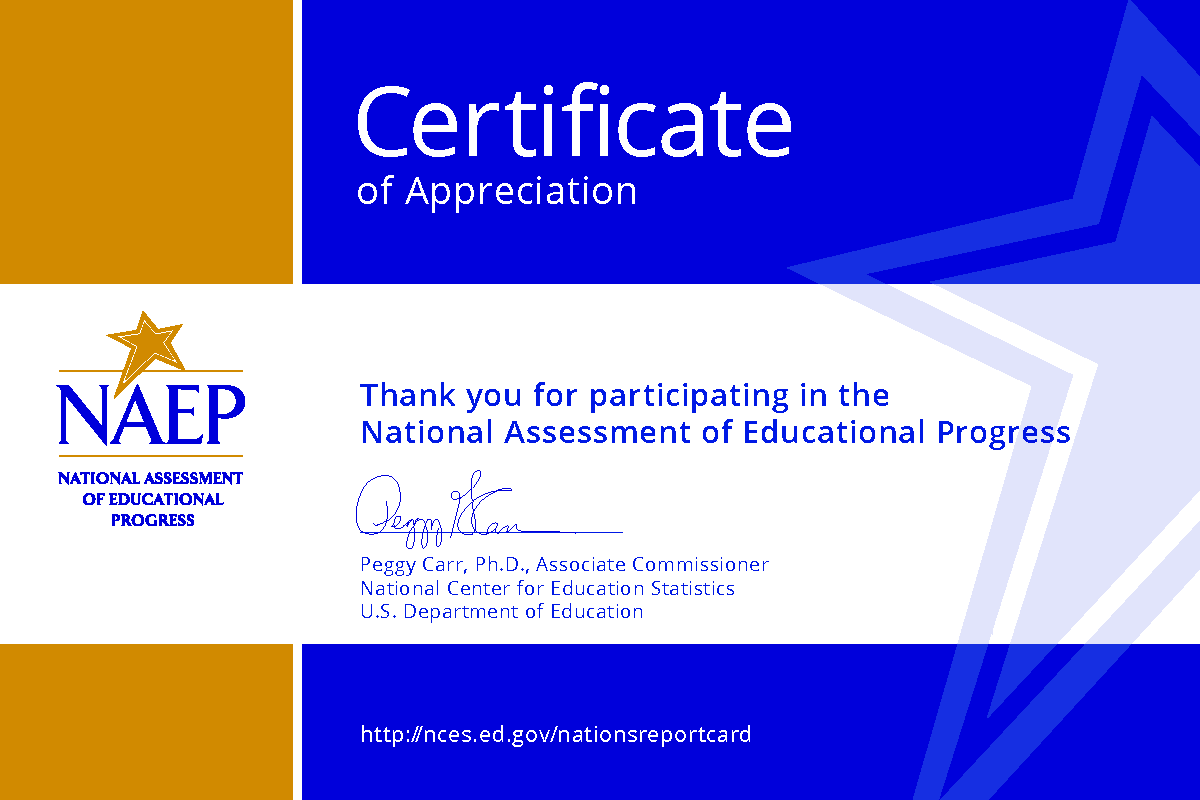
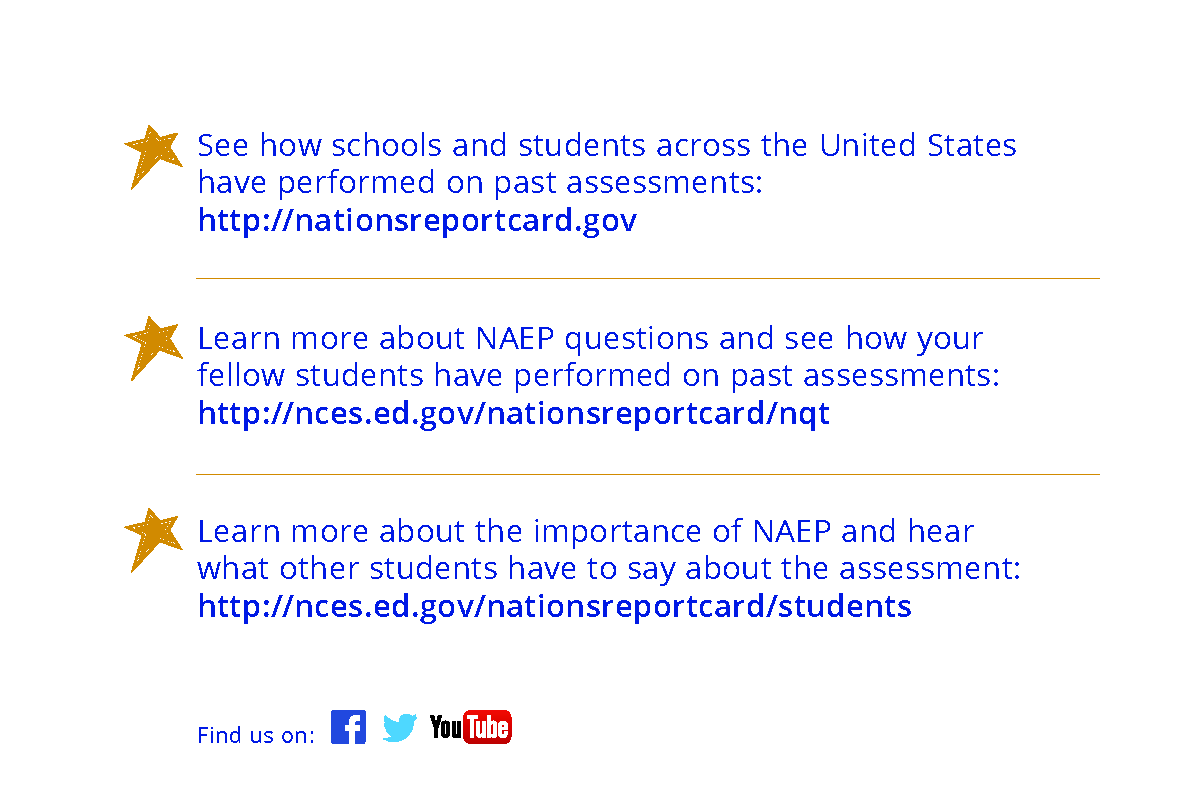 of
Community Service
of
Community Service
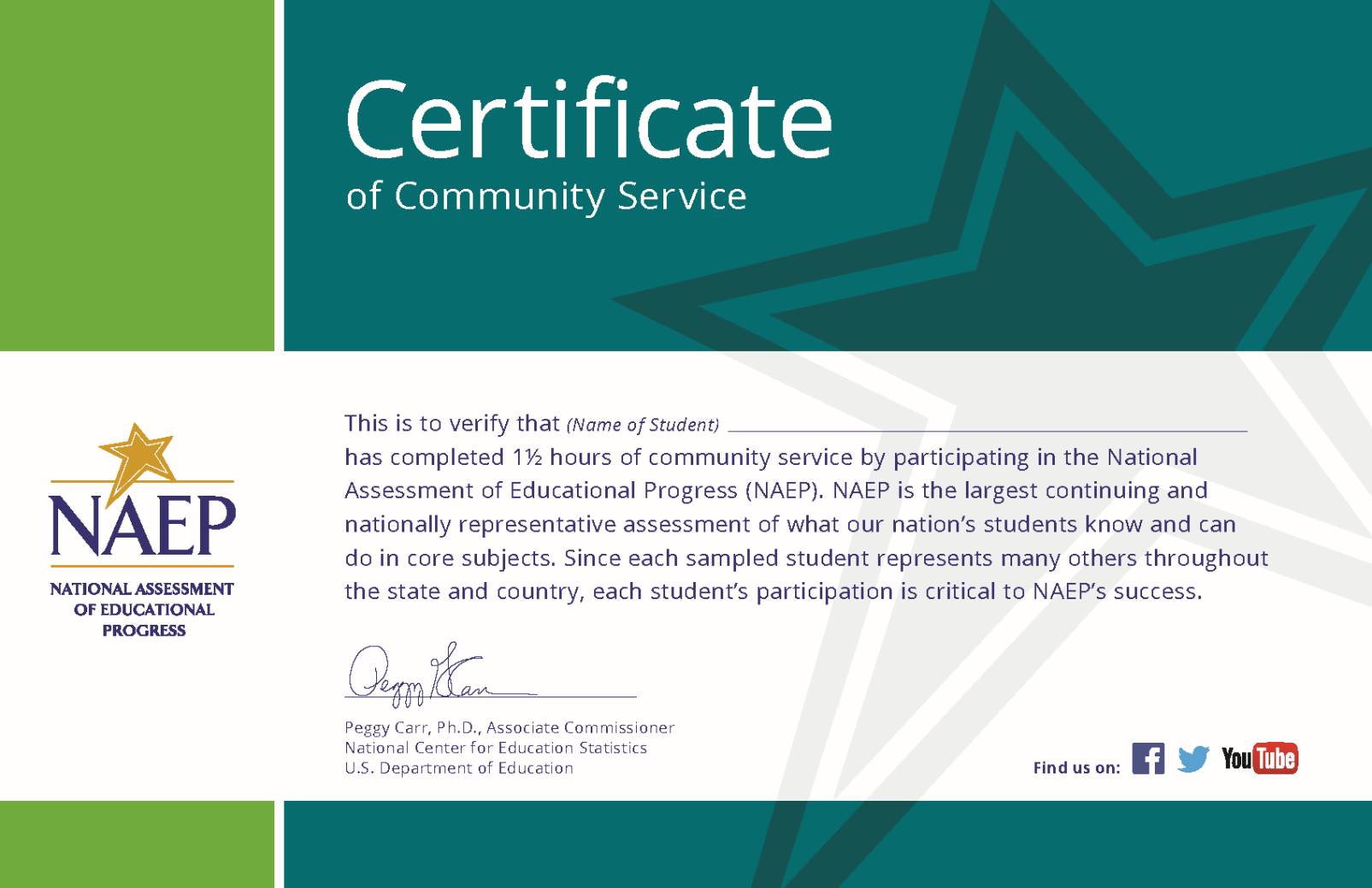
I ncentive
Ideas
ncentive
Ideas
For students who participate in NAEP
Student incentives can help boost NAEP participation rates in your school. Here are some examples of strategies used by school principals over the past 10 years.
Raffle for prizes
Students who choose to participate can be entered into a raffle for a special prize. Some possible prizes are listed below.
Free prom tickets
Special parking space for a day or week
Free yearbook
Free yearbook space/page
Gift card(s) from local businesses
Free food
Some schools offer a simple breakfast as a thank you to participating students—bagels, donuts, coffee, orange juice. Another option is pizza for lunch or snacks for after the assessment.
Extra credit
Drop a low homework score, or add extra credit to a test, quiz, or project.
Graduation pin
Create and distribute a pin or honor tag to be worn during graduation.
![]()
![]()

![]()
U.S. Department of Education NCES 2012-469
The Nation’s Report Card
What Every Parent Should Know About NAEP

![]()
![]()



You’ve probably heard of The Nation’s Report Card.
It’s a resource. It’s a national wakeup call.
It’s a window into the state of our educational system and what students are learning.
It’s more than just a test.
Today’s students take tests for everything. The National Assessment of Educational Progress (NAEP), though, is different. It’s called The Nation’s Report Card because it tells us how students across the country, not just
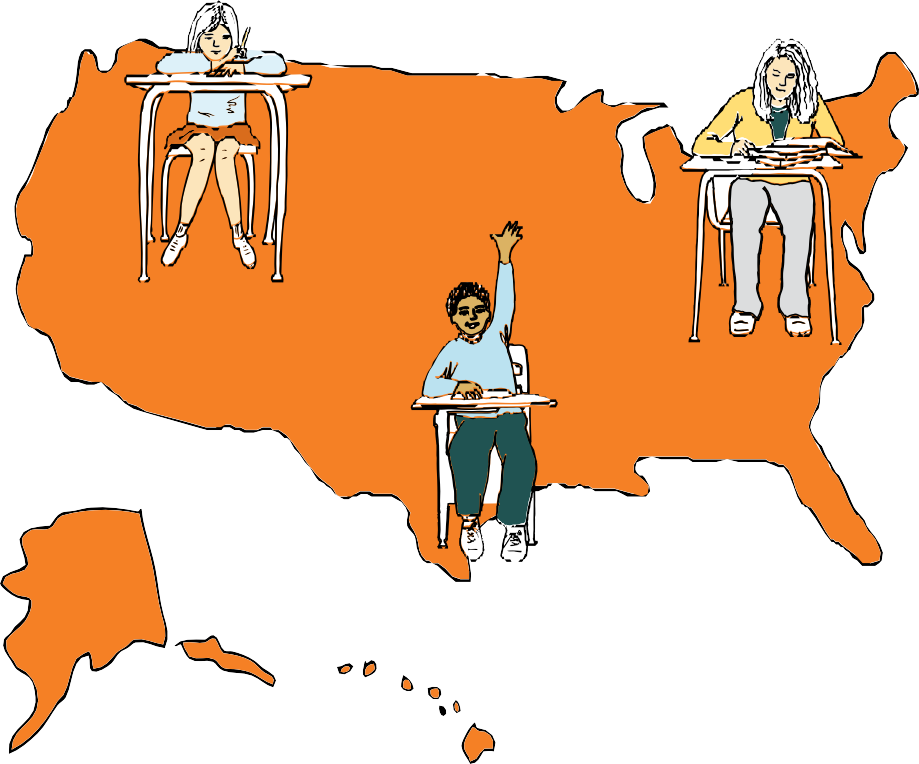 in
one
particular
school
or
state,
are
doing.
in
one
particular
school
or
state,
are
doing.
 “[T]he
definitive source… for state-to-state comparisons in
educational achievement…”
“[T]he
definitive source… for state-to-state comparisons in
educational achievement…”
of Educational Achievement
“NAEP is the gold standard of student assessments.”
“Students taking the math exam who reported taking algebra I in eighth grade tended to outscore their peers who had not taken algebra I.”
“Only 12% of U.S. high school seniors are proficient in the legacy of America’s past.”
![]()
“…higher math scores are “undoubtedly” a sign of the success of math instruction in classrooms…”
![]()

![]() -The
Washington Post editorial board
-The
Washington Post editorial board
![]()
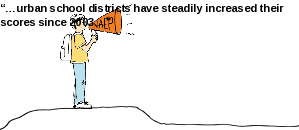 “The
nation’s
report
card
on
math
and
reading
shows
fourth-
and eighth-graders
scoring
their
best
ever
in
math…”
“The
nation’s
report
card
on
math
and
reading
shows
fourth-
and eighth-graders
scoring
their
best
ever
in
math…”
![]()
Everyone’s talking about NAEP. As the largest national test, its results are found
in the headlines of national and local news stories all over the country.
![]()
![]() “Today’s
NAEP
results
confirm
that
we
have a crisis
on
our
hands when
it comes
to
civics
education.”
“Today’s
NAEP
results
confirm
that
we
have a crisis
on
our
hands when
it comes
to
civics
education.”
“Very few students have the advanced skills that could lead to careers in science and technology, according to the results of a national exam…”
NAEP: The Big Picture
 The
Nation’s Report Card opens the door for parents to understand
how well children like theirs are doing compared to other students
in:
The
Nation’s Report Card opens the door for parents to understand
how well children like theirs are doing compared to other students
in:
Participating large urban districts
Other states
The nation
The rest of the world!
Appendix D1 NAEP 2019-2020
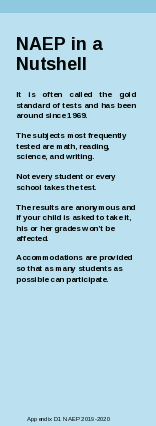
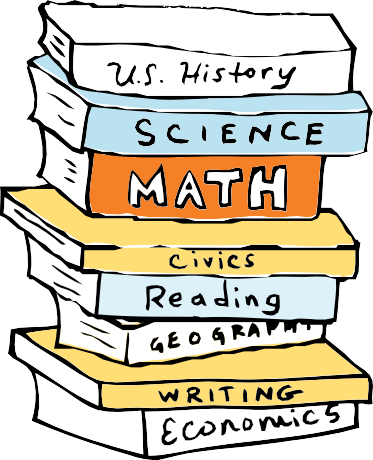 How
would
my
child
stack
up?
How
would
my
child
stack
up?
Use real NAEP questions to find out.
After each test, dozens of NAEP sample questions are released with The Nation’s Report Card to show how real students performed in that subject.



Give it a try. Test yourself!
Lightning and thunder happen at the same time, but you see the lightning before you hear the thunder.
Explain why this is so.
Do you know the answer? Find out online!
Appendix D1 NAEP 2019-2020
What do all of these NAEP results tell us about education?
See how your state measures up.
You can use NAEP results to compare your state to the nation, other states, and some large urban districts.
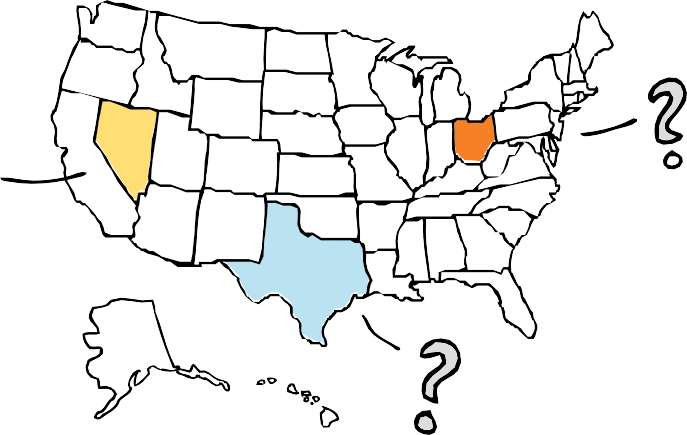

Go beyond the scores.
 NAEP
reports provide more than just results in school subjects and
grades.
NAEP
reports provide more than just results in school subjects and
grades.
See how students have performed over time, including by racial/ethnic groups and gender.
NAEP also looks at differences between the performances of groups of students, illuminating achievement gaps that exist among the nation’s students.
 Learn
which states are closing achievement gaps, and see whether your
state is making progress.
Learn
which states are closing achievement gaps, and see whether your
state is making progress.
NAEP examines the path to high school graduation by studying coursetaking and grades of America’s most recent high school graduates.
 Find
out if your child is prepared for the future.
Find
out if your child is prepared for the future.
Look at the full picture.
NAEP also looks at the factors that may be related to learning—both inside and outside the classroom.
![]() Fourth-graders
who
reported
reading
for
fun
almost
every
day
scored
higher
on
NAEP.
Fourth-graders
who
reported
reading
for
fun
almost
every
day
scored
higher
on
NAEP.
 The
percentage of twelfth-grade students who reported studying
the U.S. Constitution in
2010
was
lower
than
in
2006.
The
percentage of twelfth-grade students who reported studying
the U.S. Constitution in
2010
was
lower
than
in
2006.
 Eighth-graders
who reported taking
algebra I scored
higher on average than students taking lower-level
courses.
Eighth-graders
who reported taking
algebra I scored
higher on average than students taking lower-level
courses.
Since 1990, more high school graduates from each racial/ethnic group completed a rigorous curriculum.

 90
percent
of
fourth-graders
who
took
the
NAEP
reading
assessment
in
2011
reported
that
they
had
a
home
computer.
90
percent
of
fourth-graders
who
took
the
NAEP
reading
assessment
in
2011
reported
that
they
had
a
home
computer.
![]() More
than
any
other
single
subject,
science
was
the
key
to
reaching
a
higher
curriculum
level.
More
than
any
other
single
subject,
science
was
the
key
to
reaching
a
higher
curriculum
level.
 NAEP
Sparks
Change
Across
the
Country
NAEP
Sparks
Change
Across
the
Country
Detroit, Michigan North Carolina
In 2009, the NAEP assessment revealed that Detroit schoolchildren ranked the lowest in the nation in both grades 4 and 8. In response to the alarming results, The Detroit Free Press partnered with Detroit Public Schools (DPS) to create and implement a new reading initiative, The Call to Action for a new Reading Corps, which encouraged citizens to volunteer 100,000 hours collectively to tutor reading in DPS schools.
In 2005, results from the NAEP reading assessment revealed that eighth grade students in North Carolina scored below the national average. In response, the state deployed more than 200 literacy coaches to middle schools around the state to help teachers reach students with reading difficulties before they made the transition to high school.
Visit The Nation’s Report Card online. www.nces.ed.gov/nationsreportcard
Dig deeper into topics such as:
How your child was selected
NAEP accommodations
NAEP scoring
Stay involved! Connect with NAEP online to be the first to know about upcoming assessments and reports.

 This
document was prepared
for
the
National
Center for Education Statistics
under Contract No. ED-07-DO-0338 with Hager Sharp.
This
document was prepared
for
the
National
Center for Education Statistics
under Contract No. ED-07-DO-0338 with Hager Sharp.
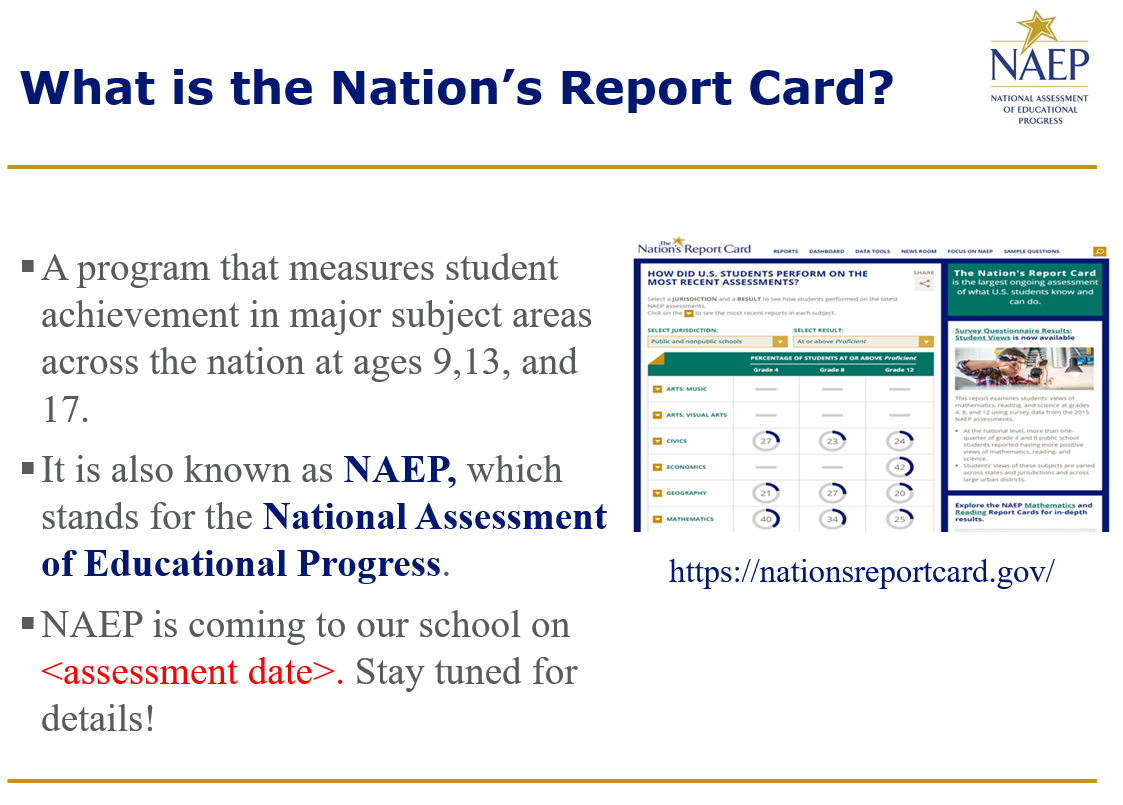

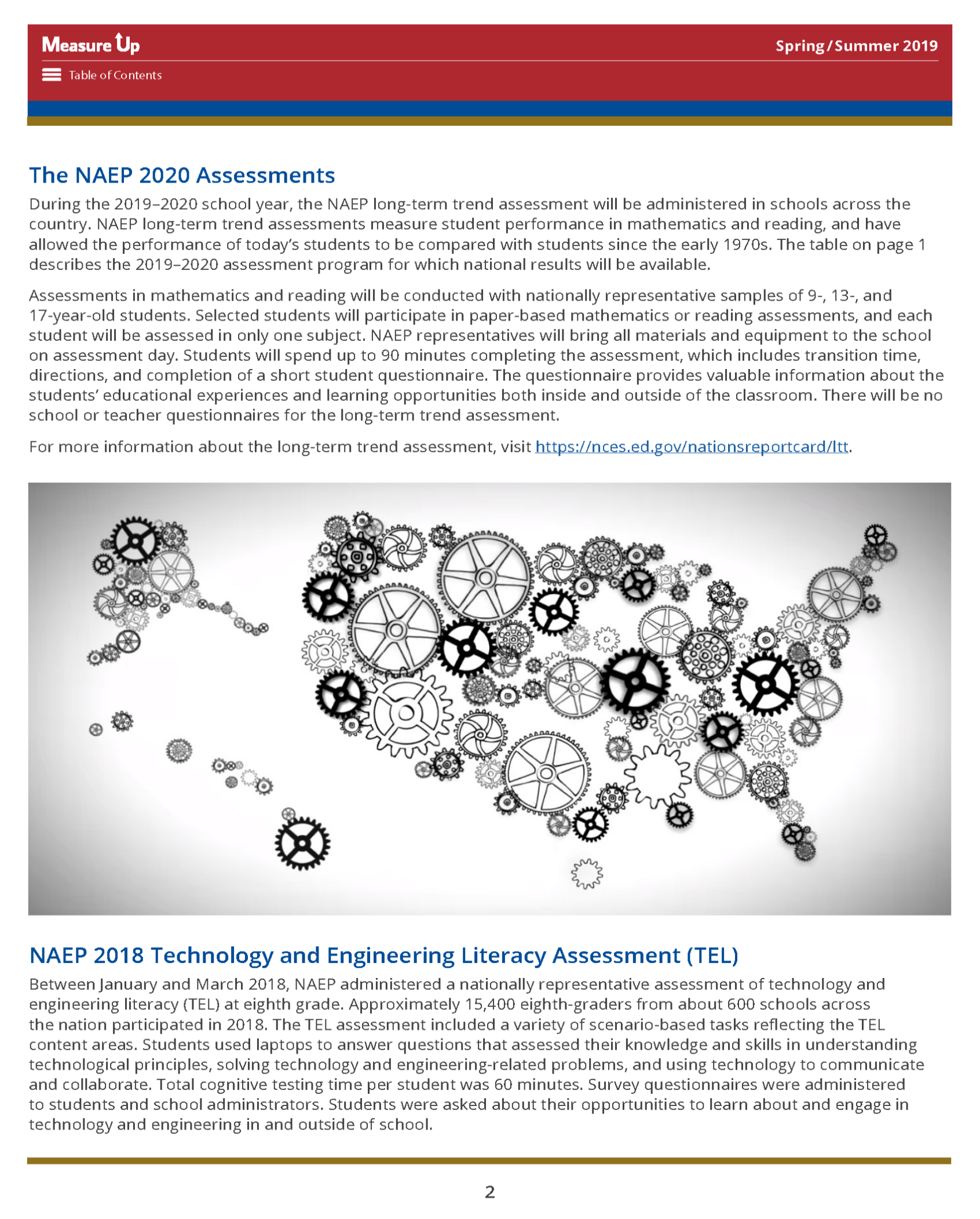
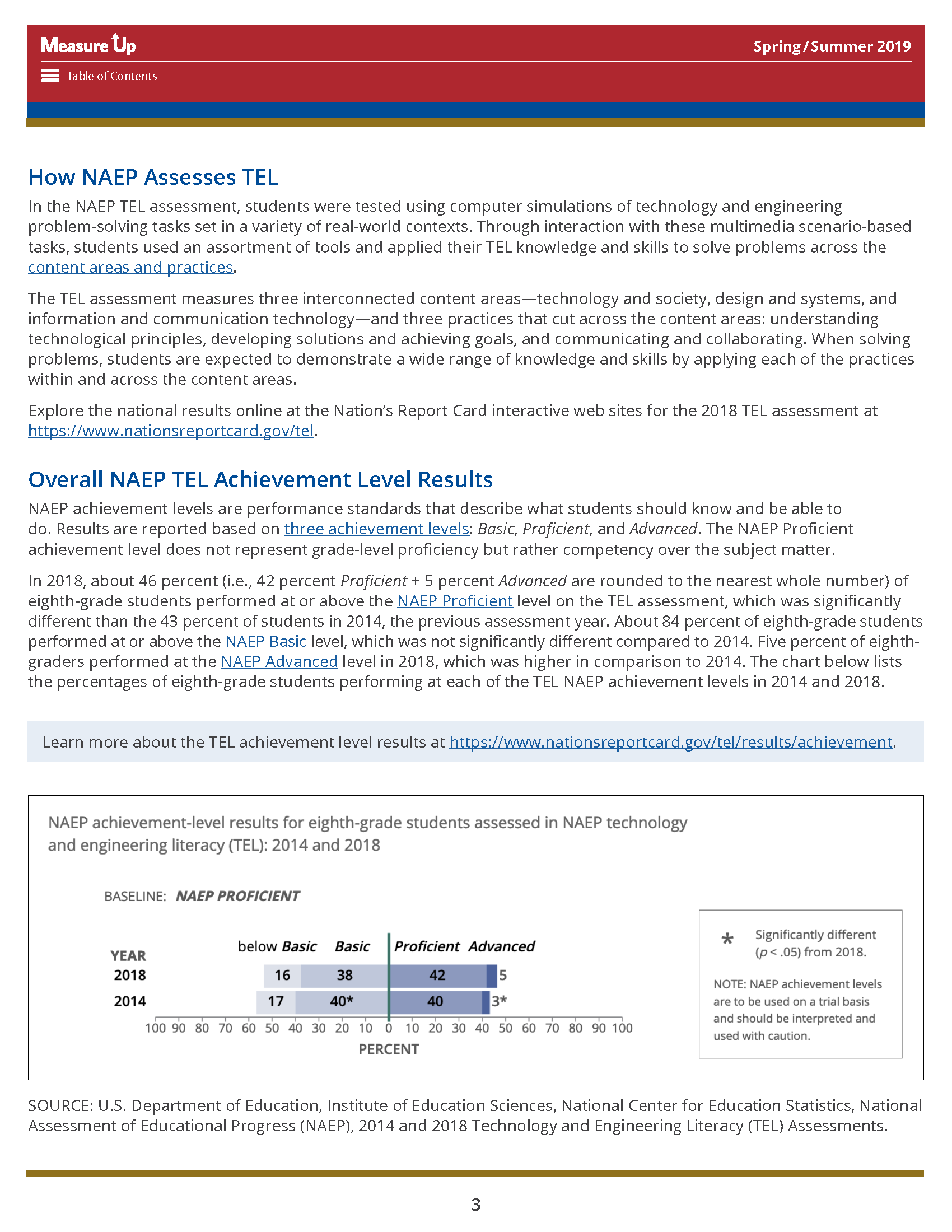


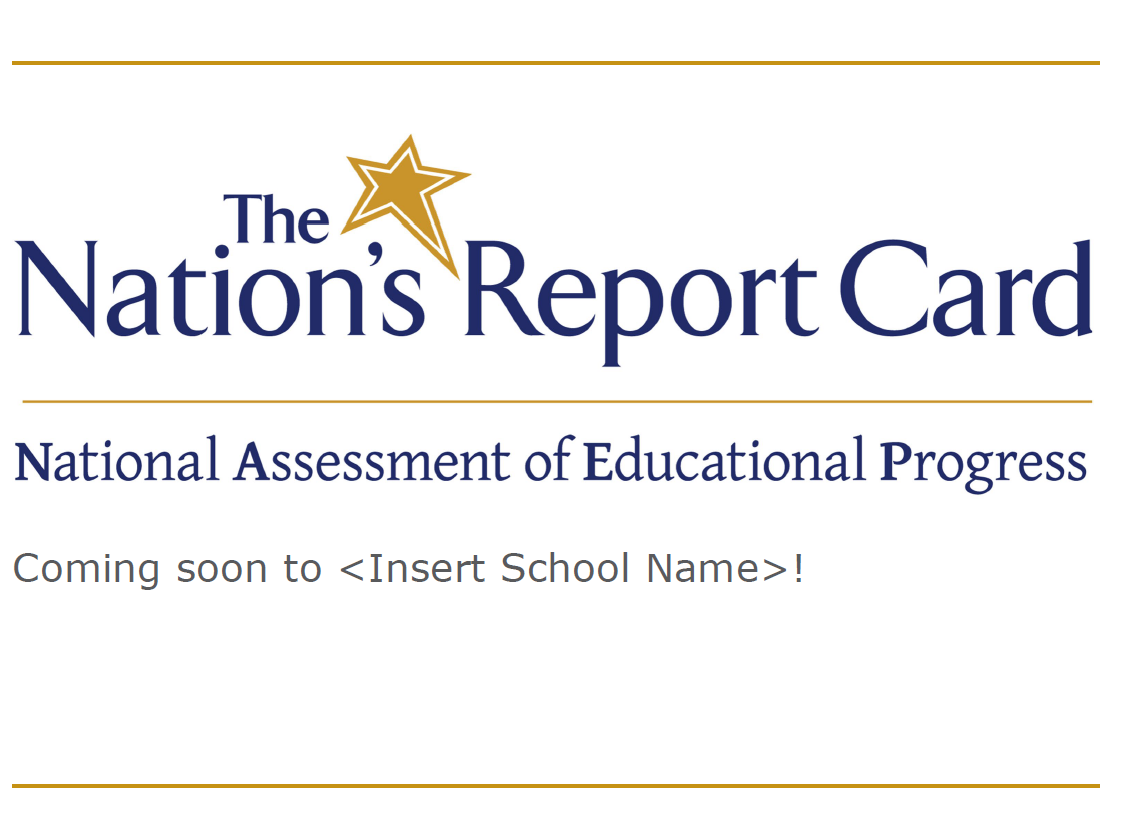
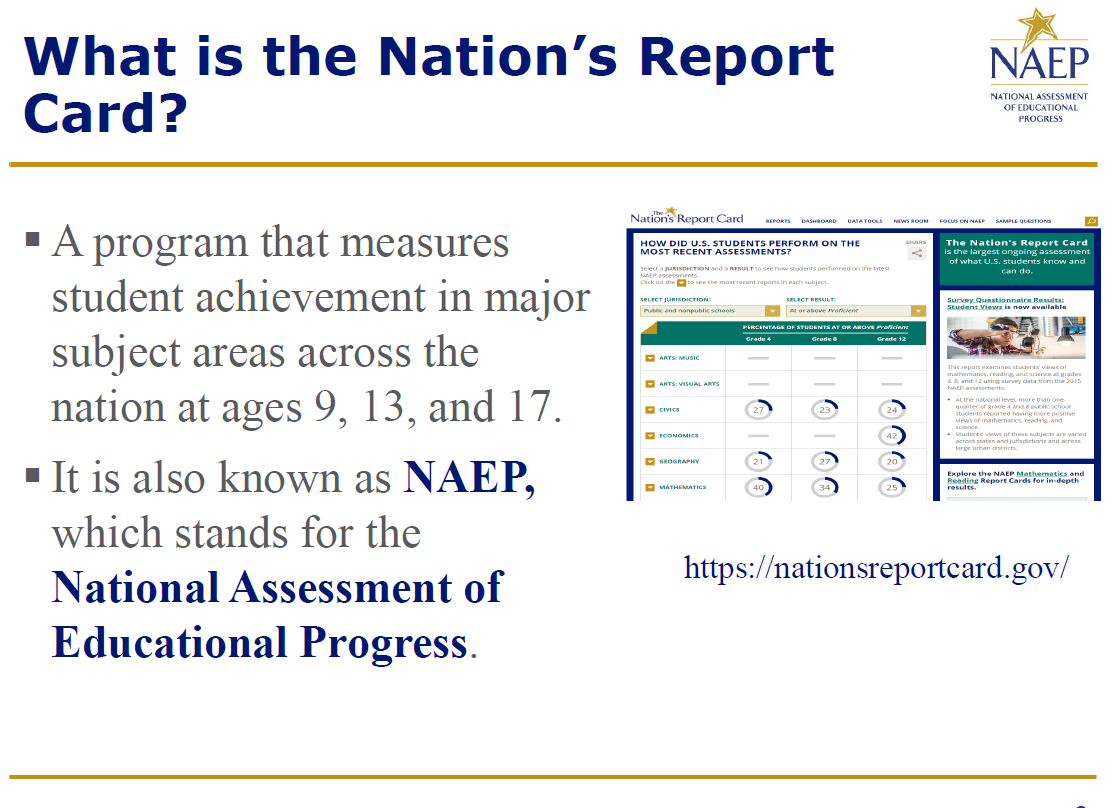
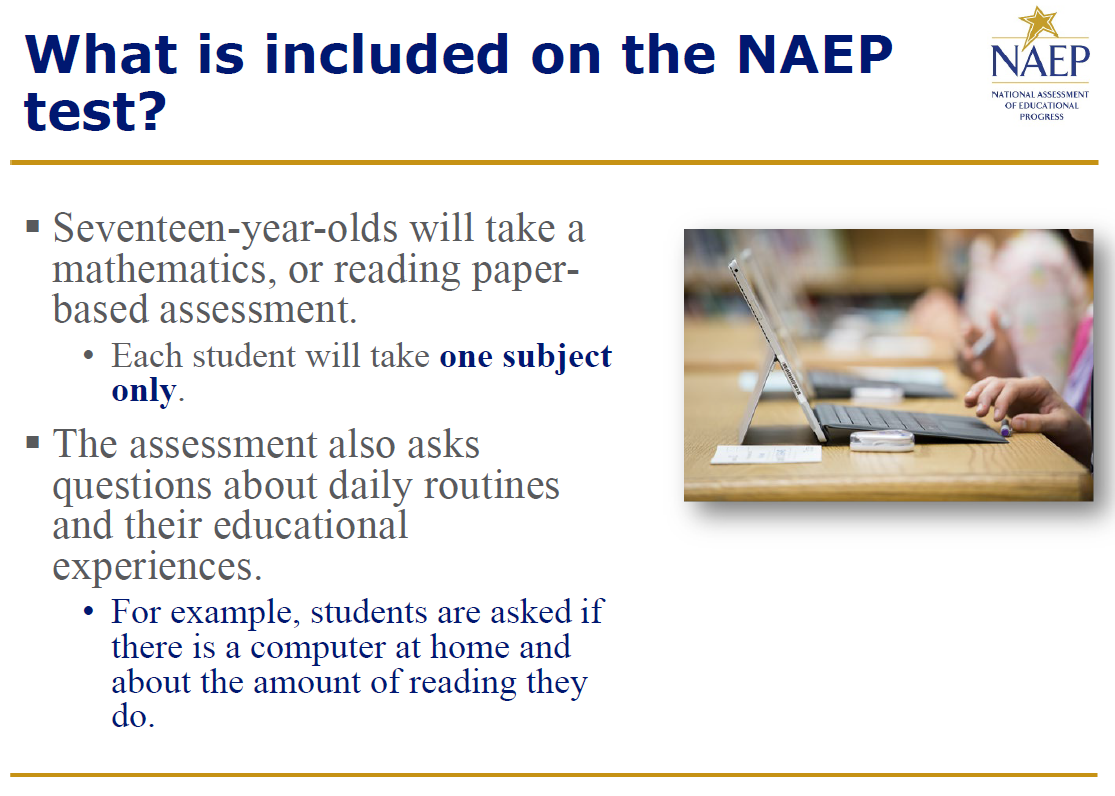
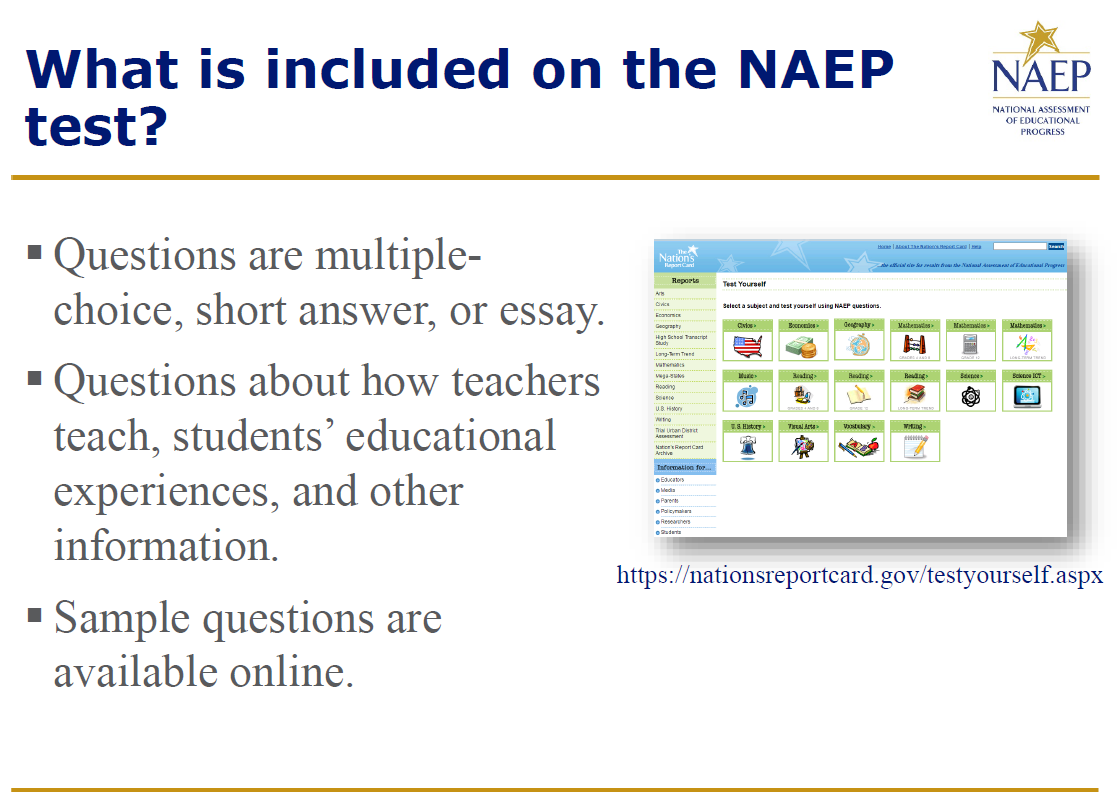
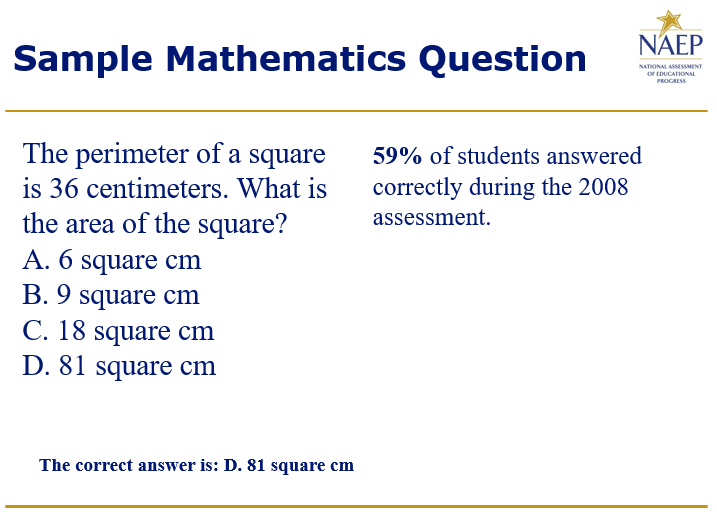
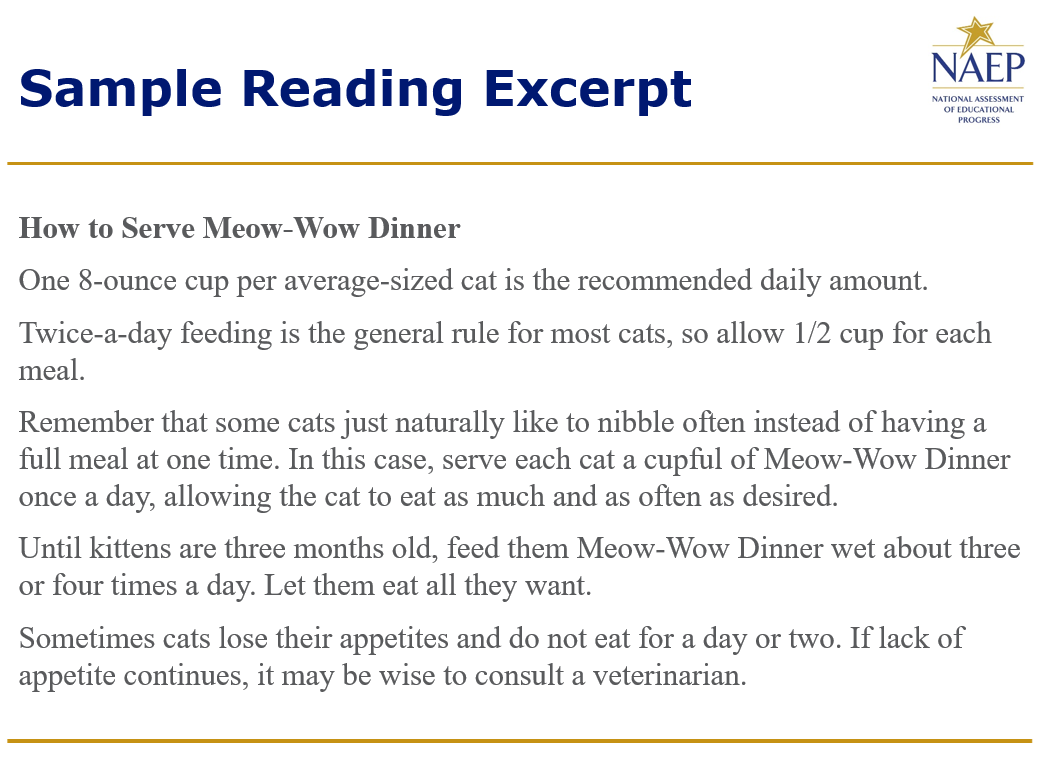
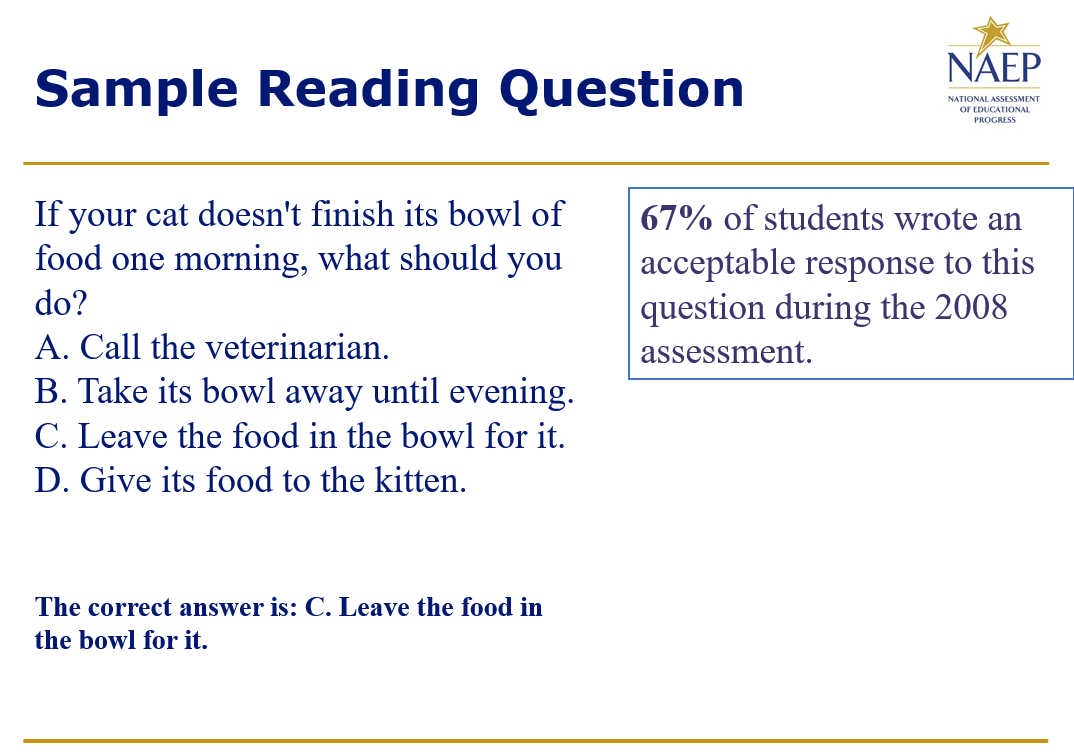

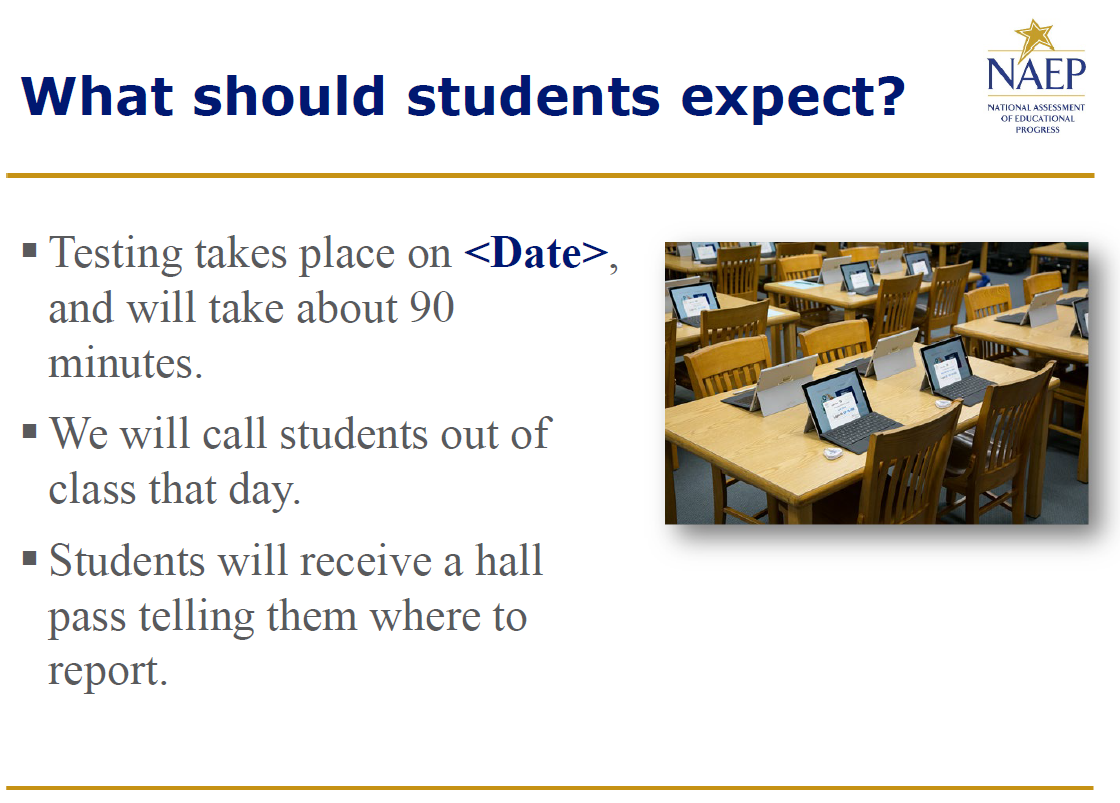
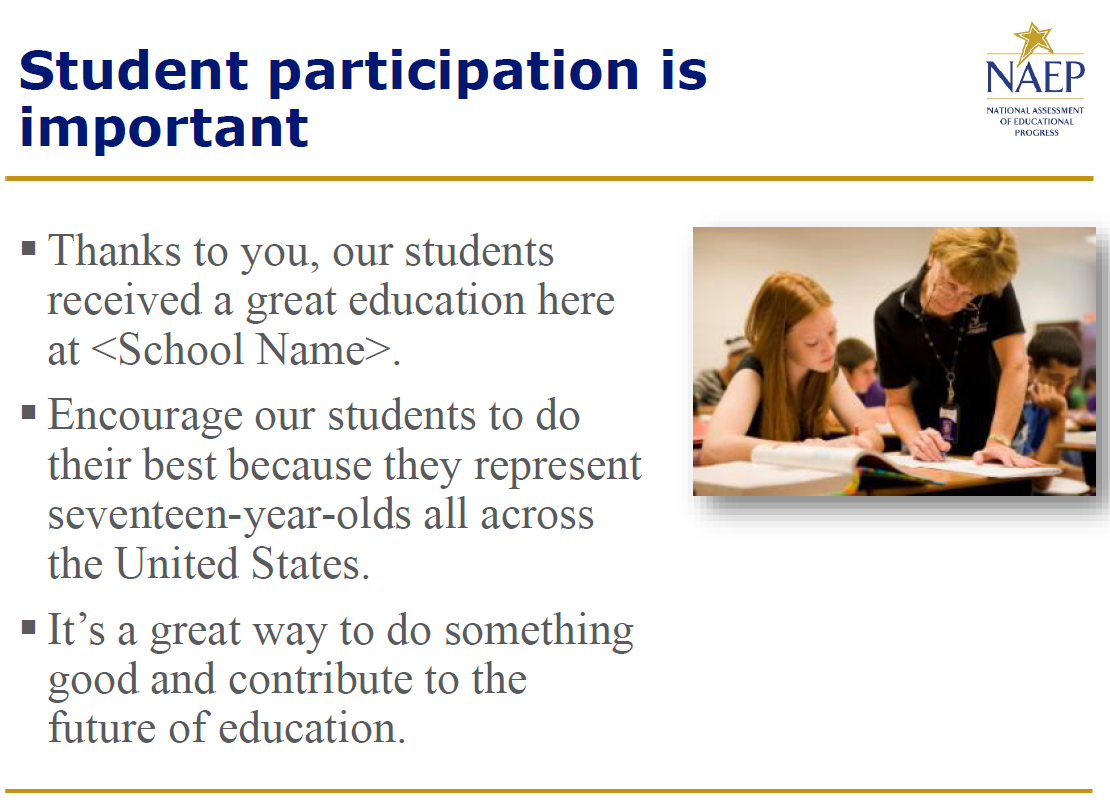
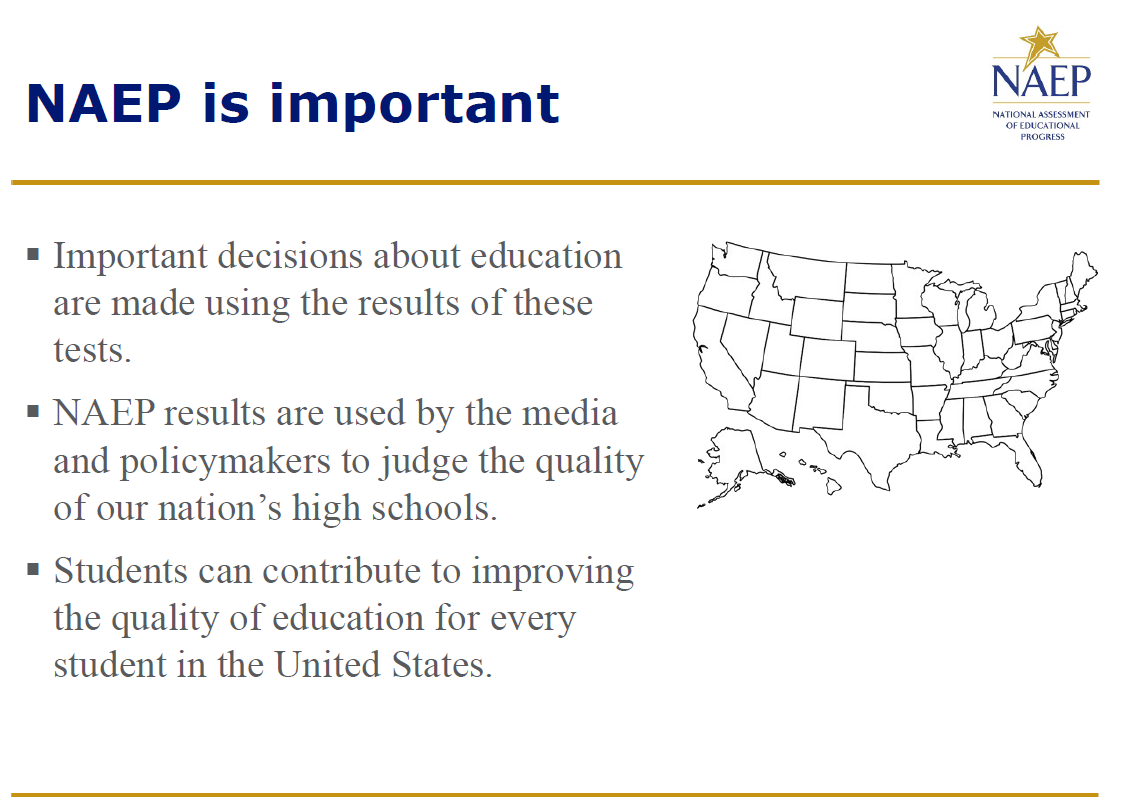
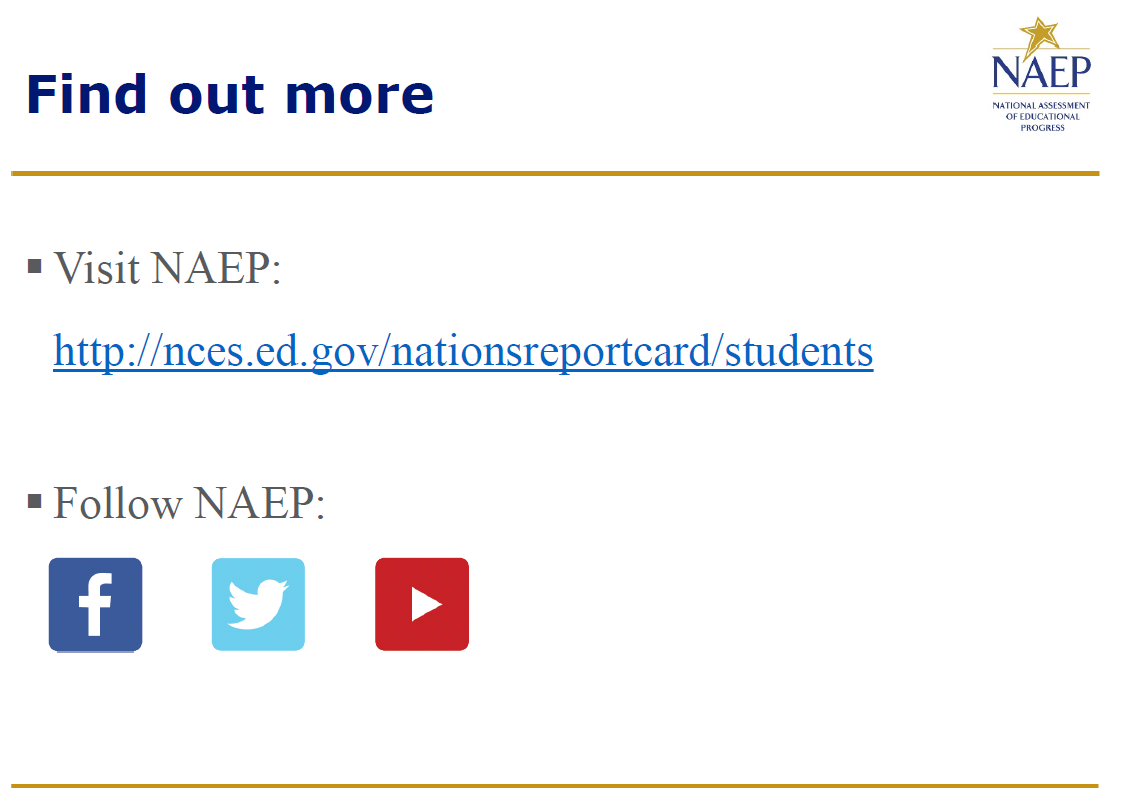

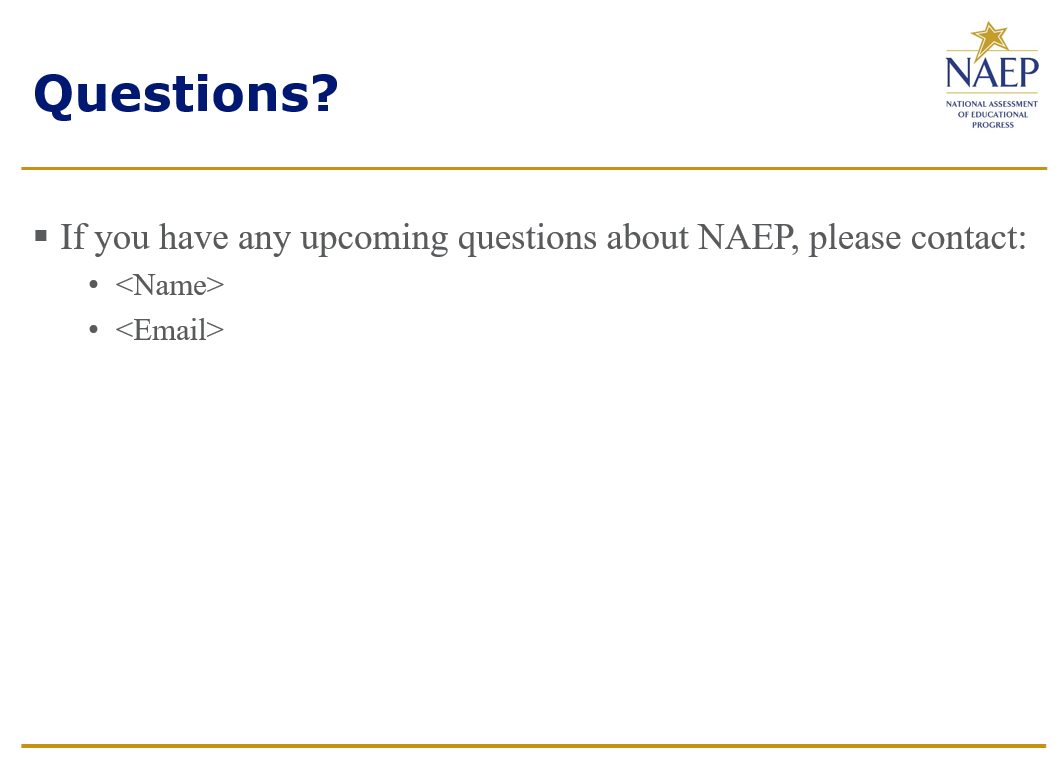
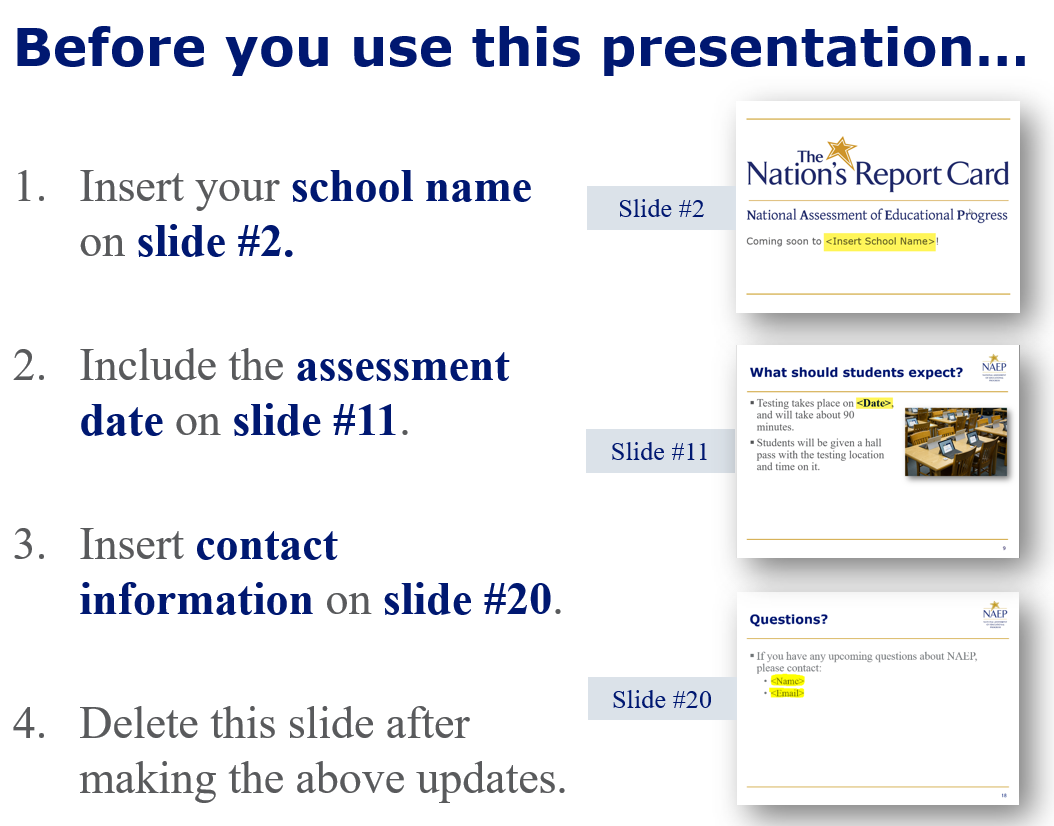
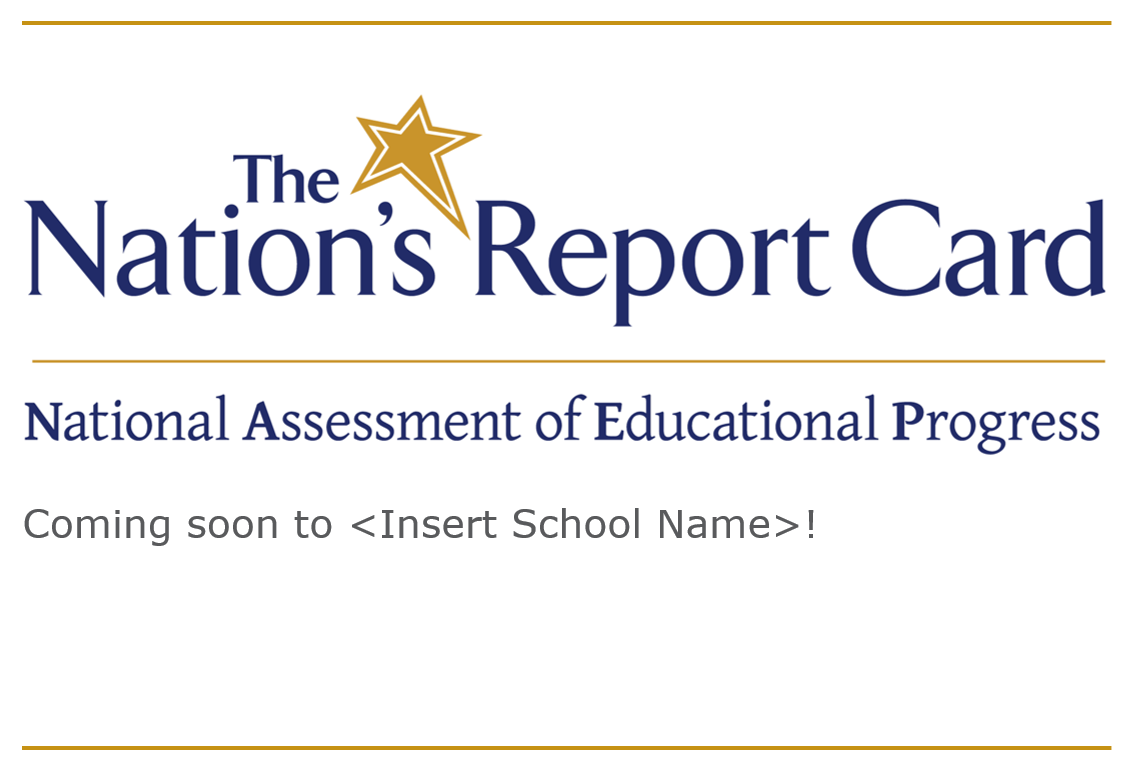
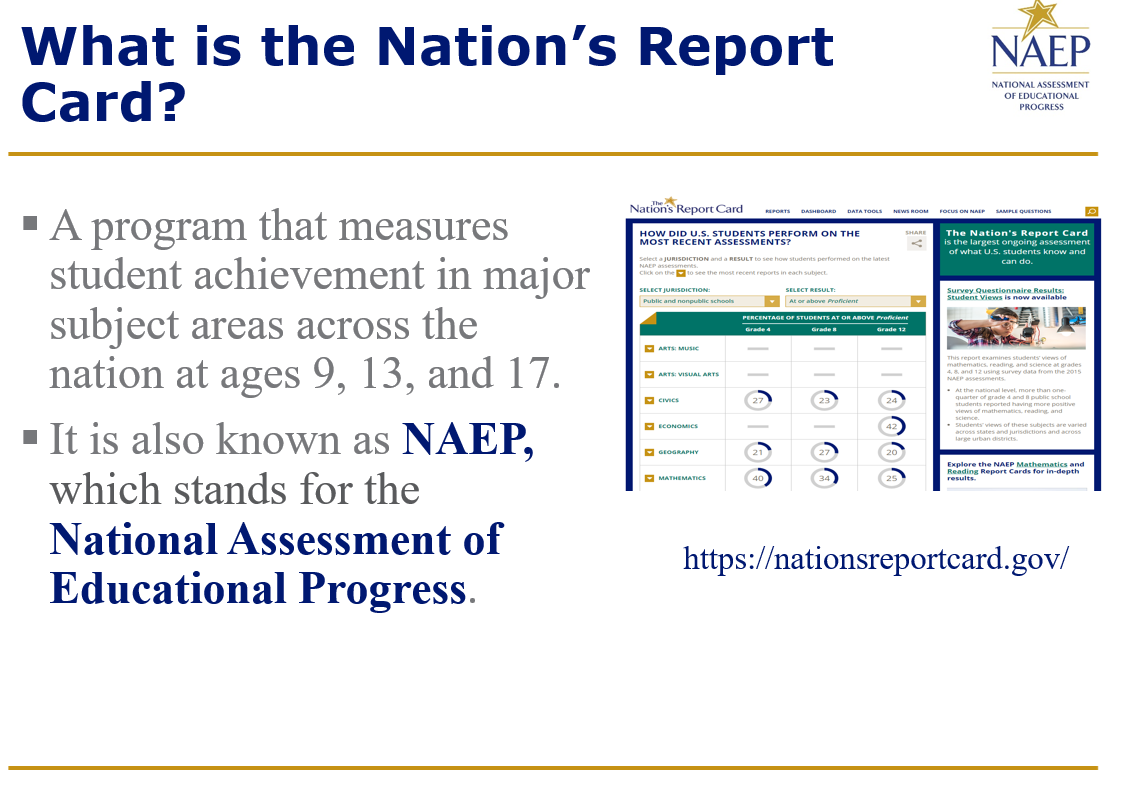
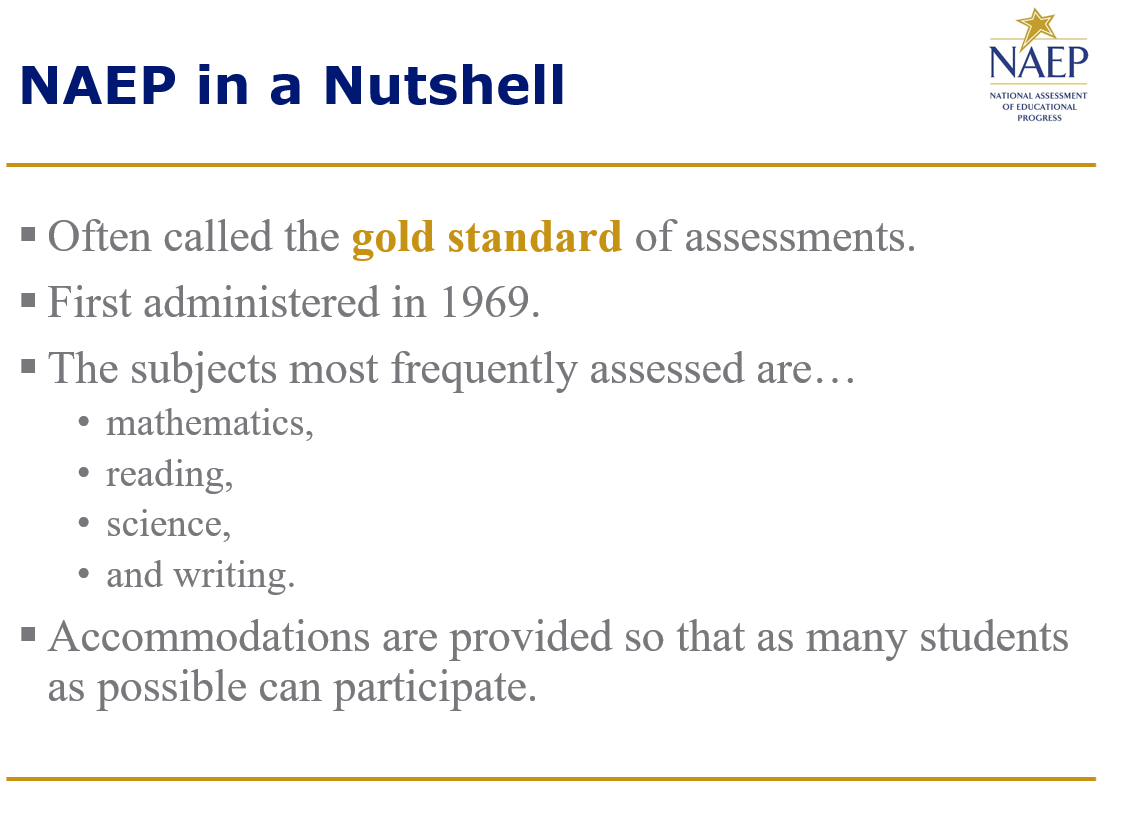

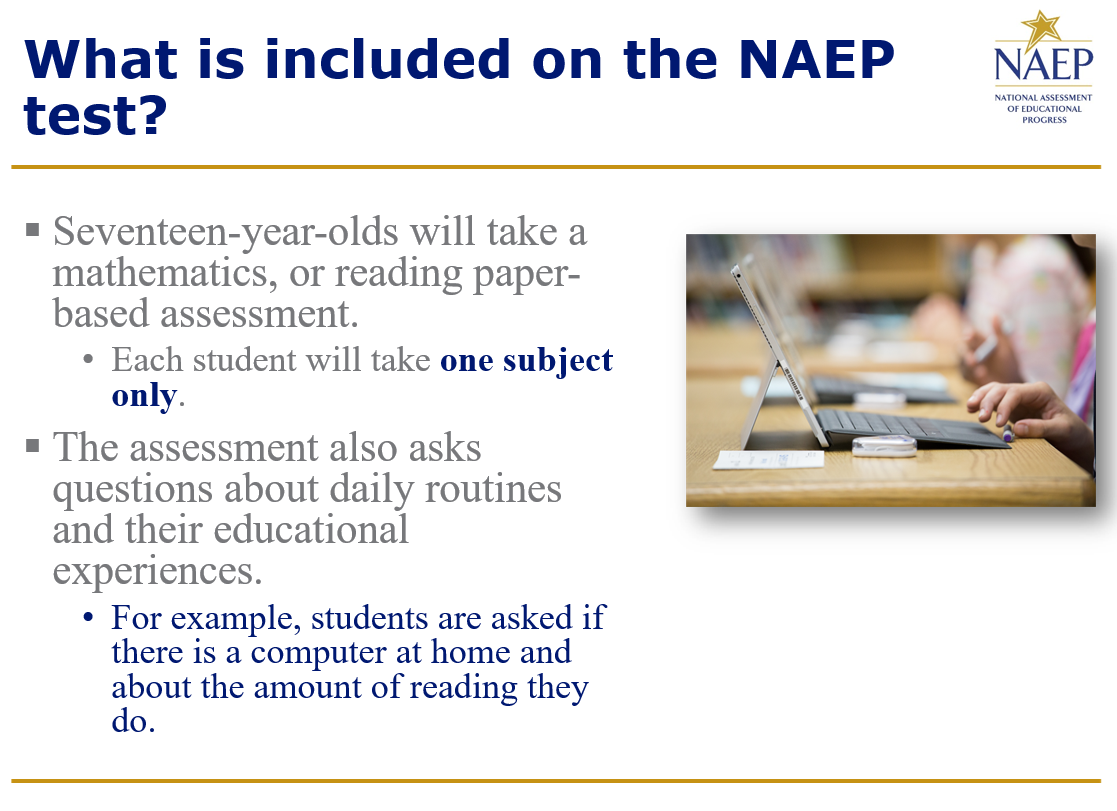
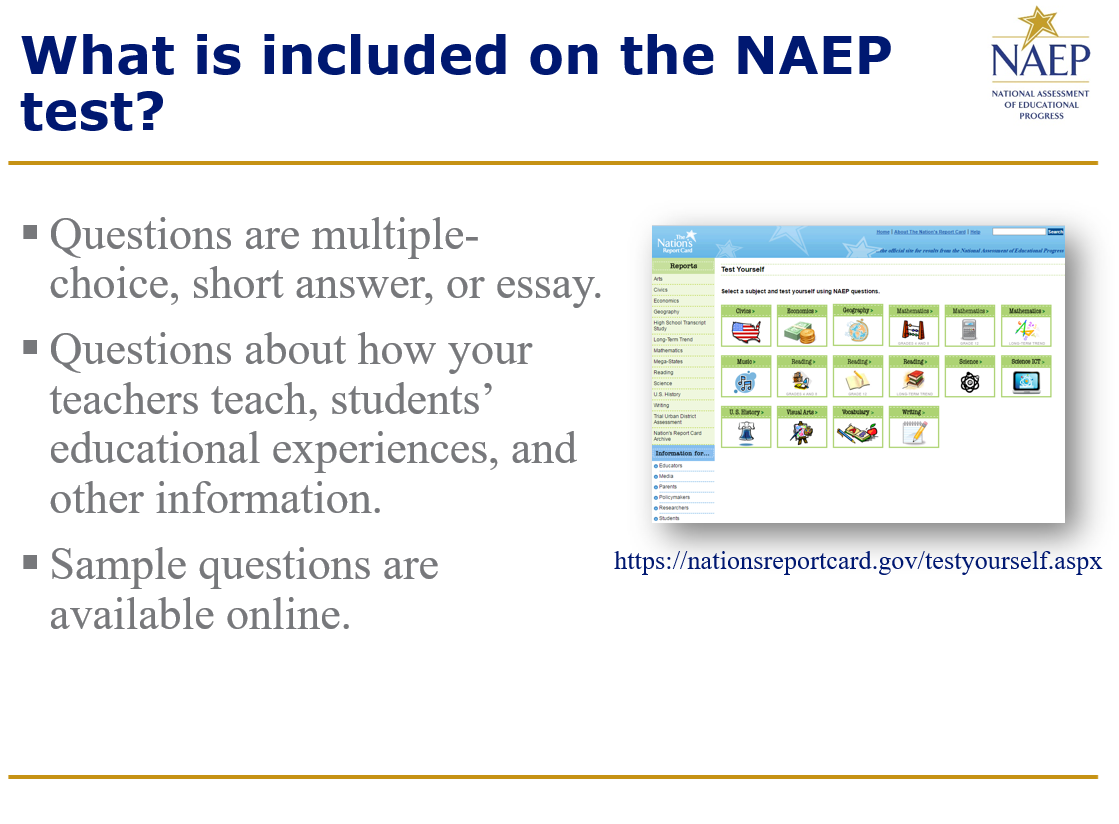
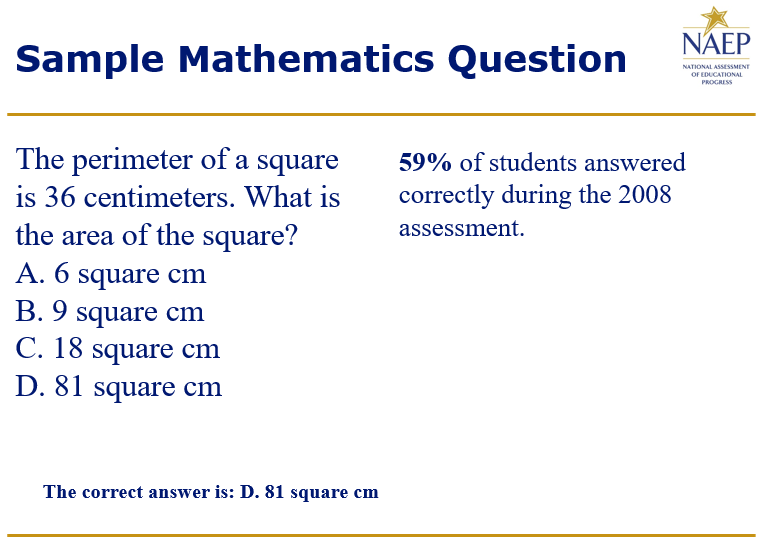
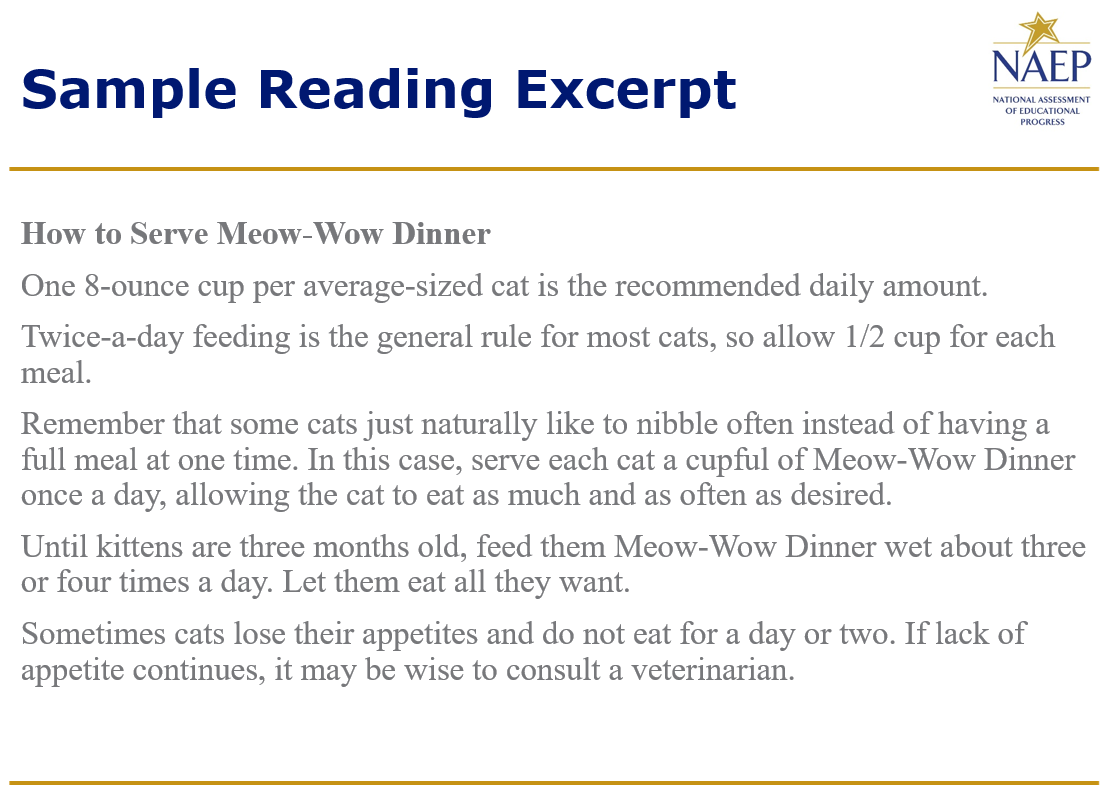
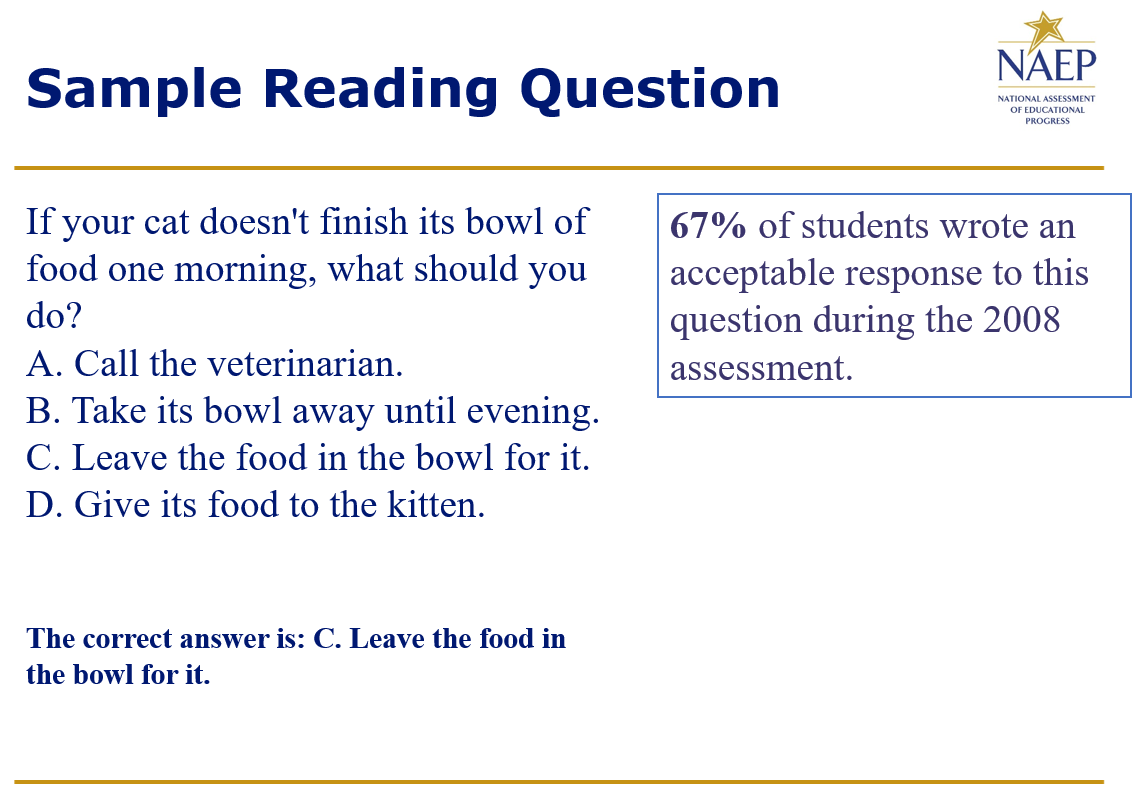
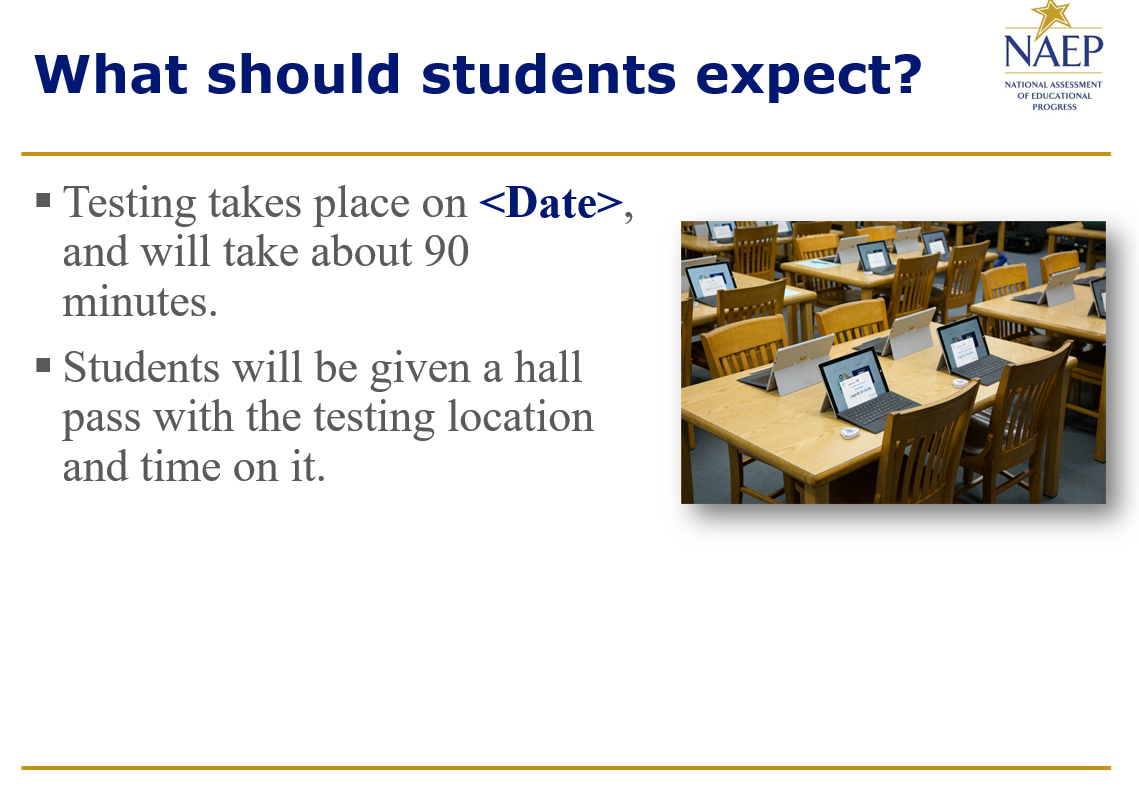

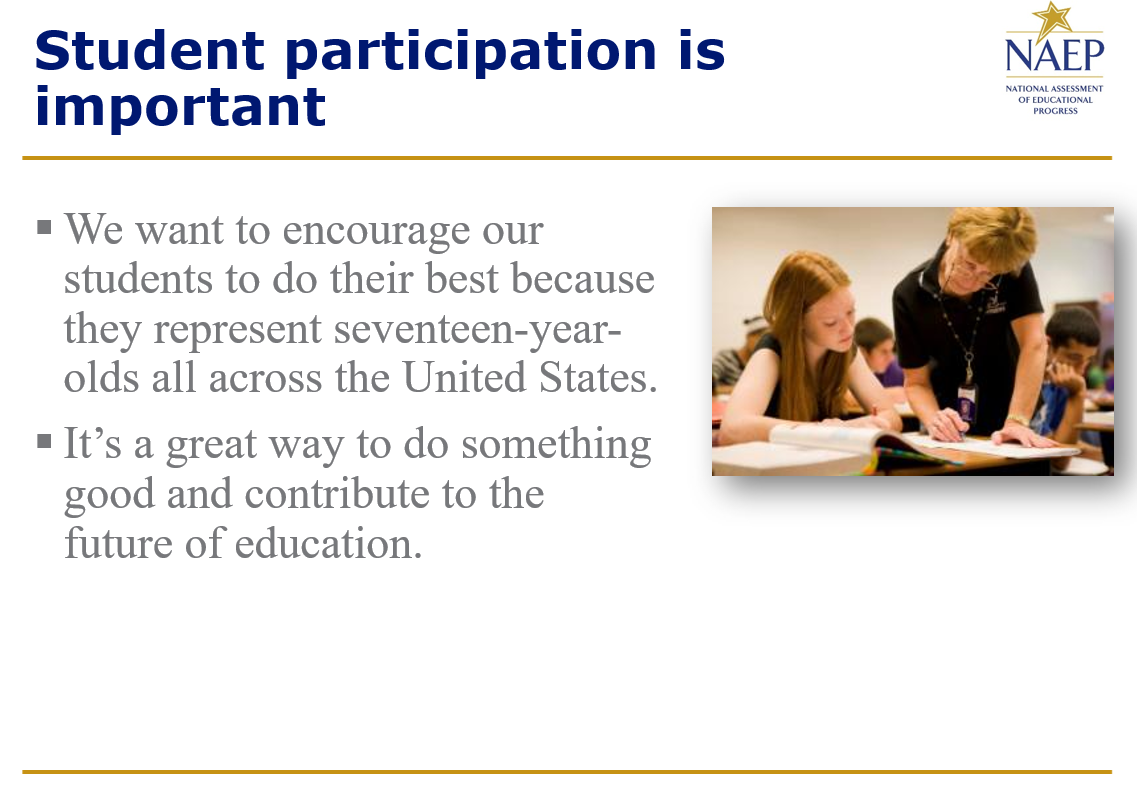
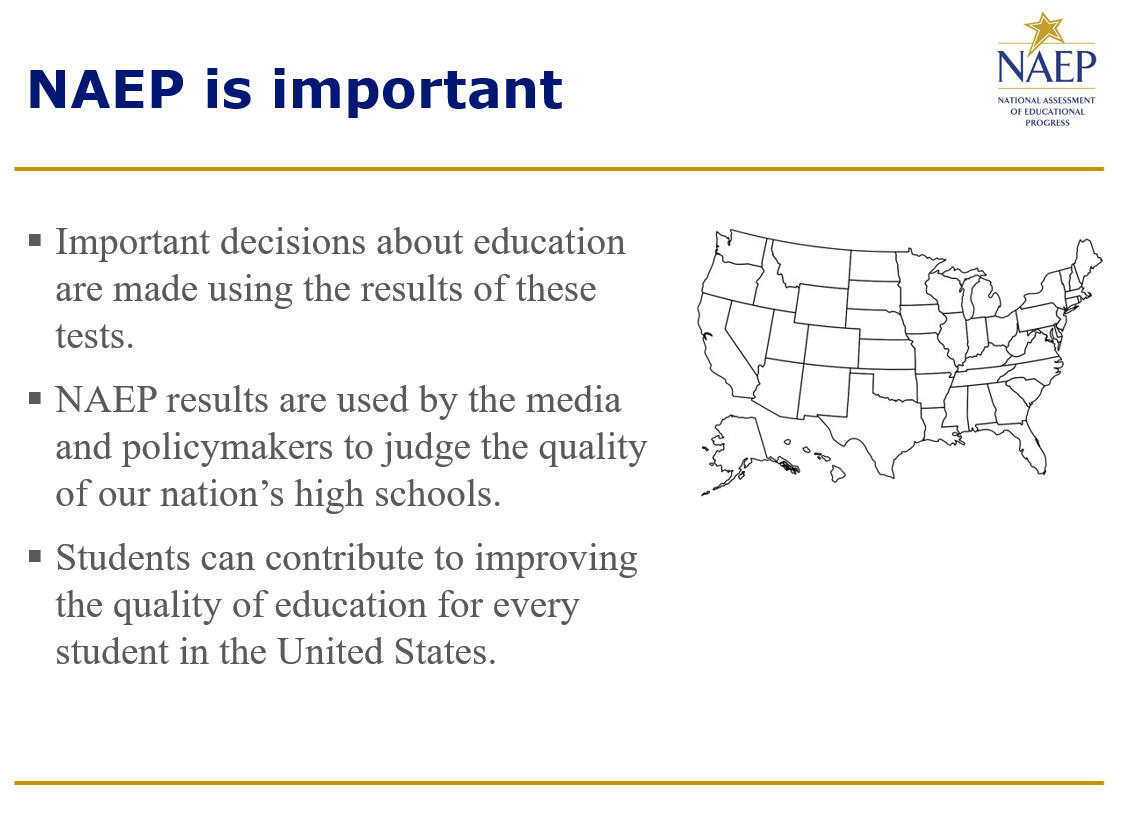
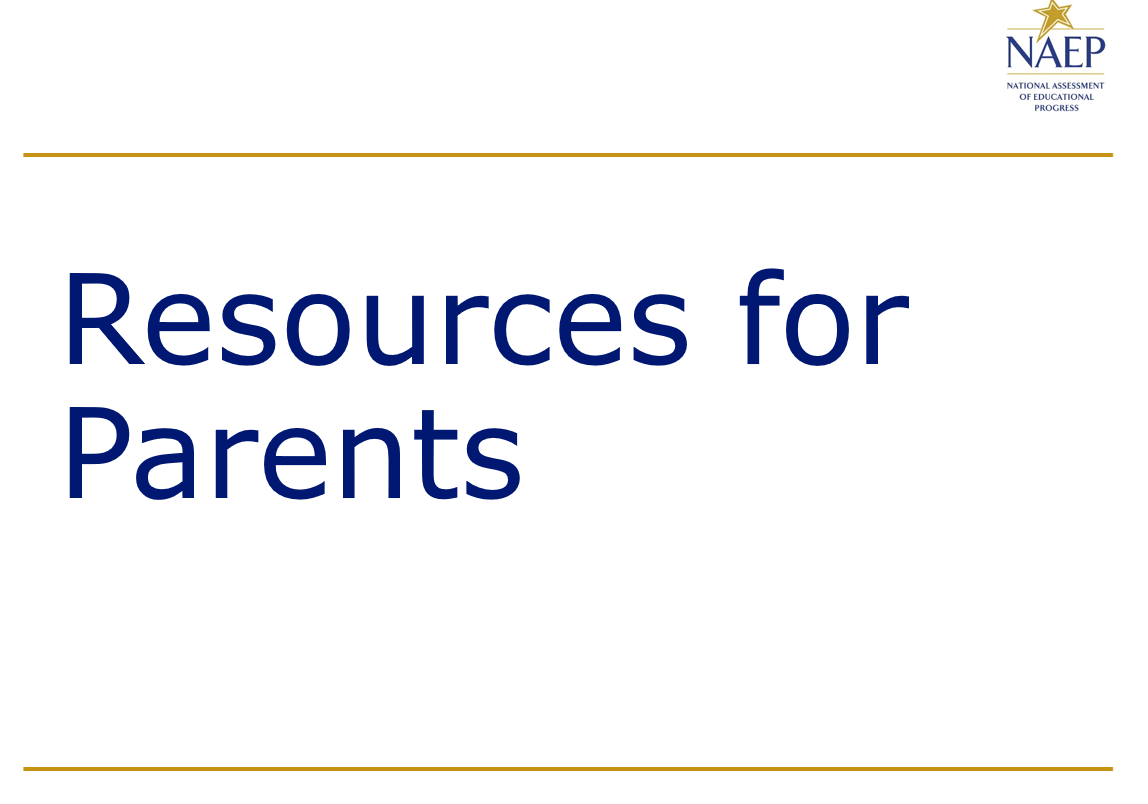
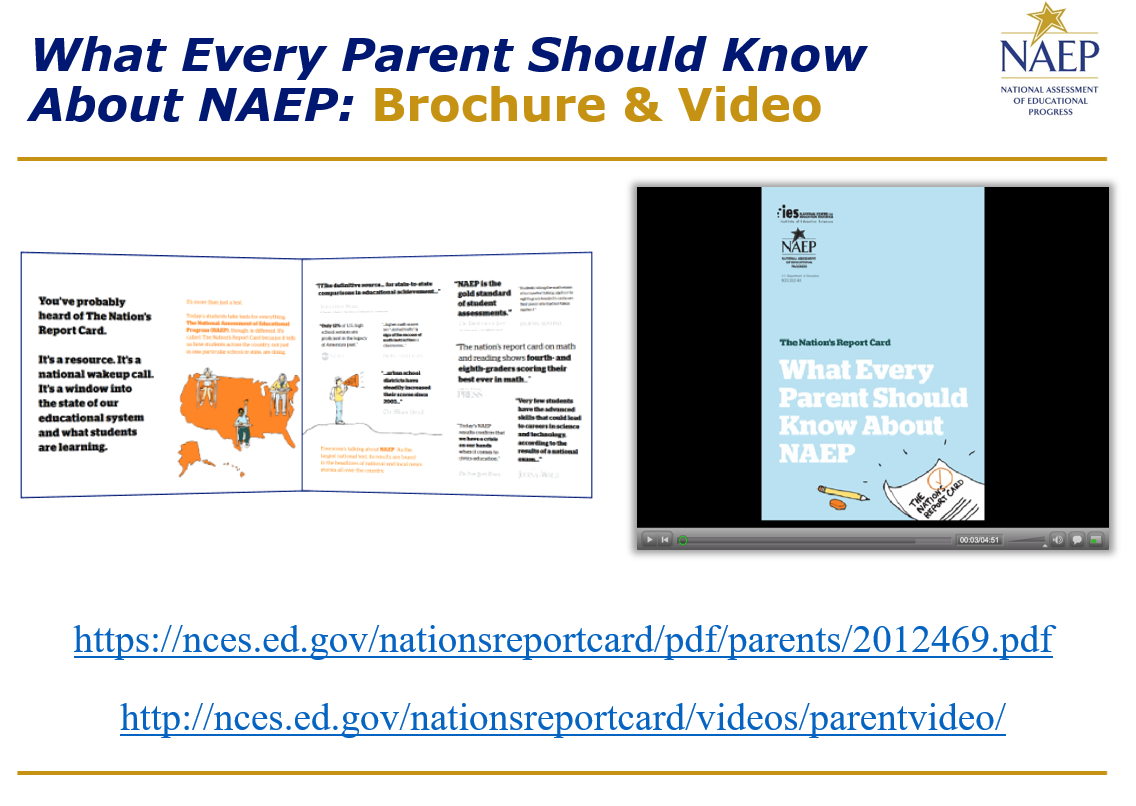

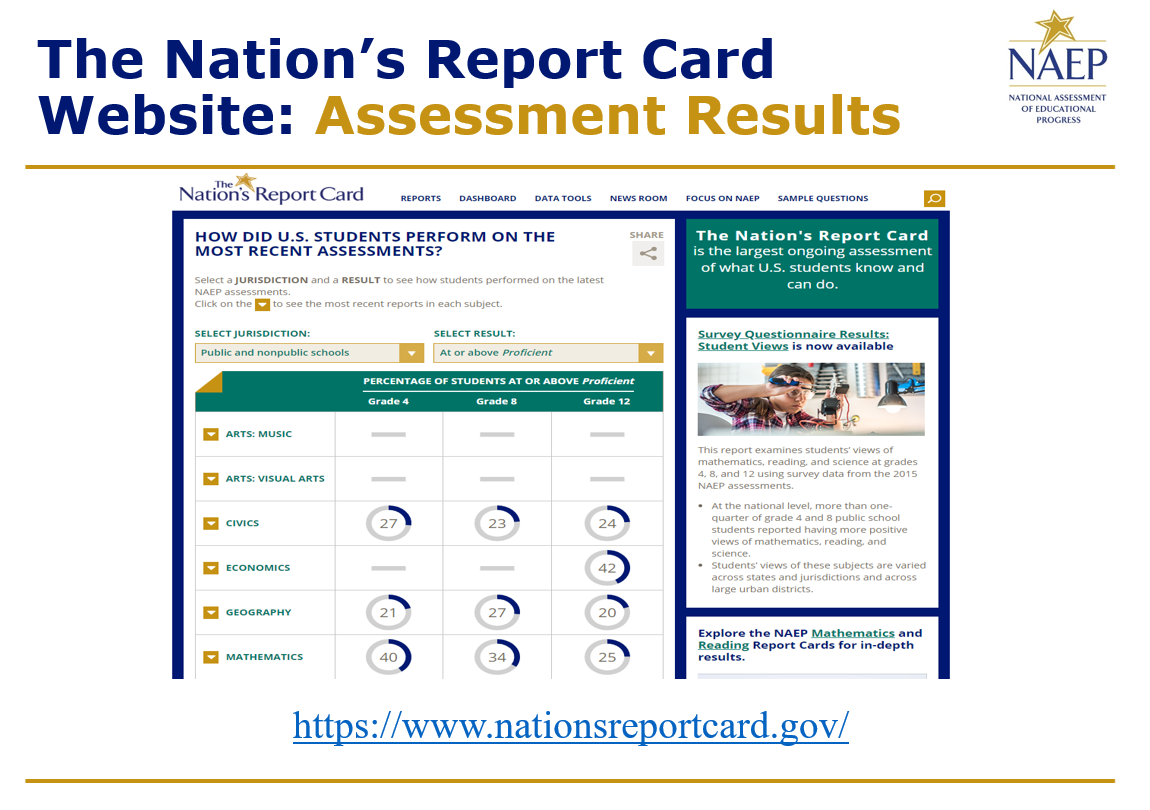
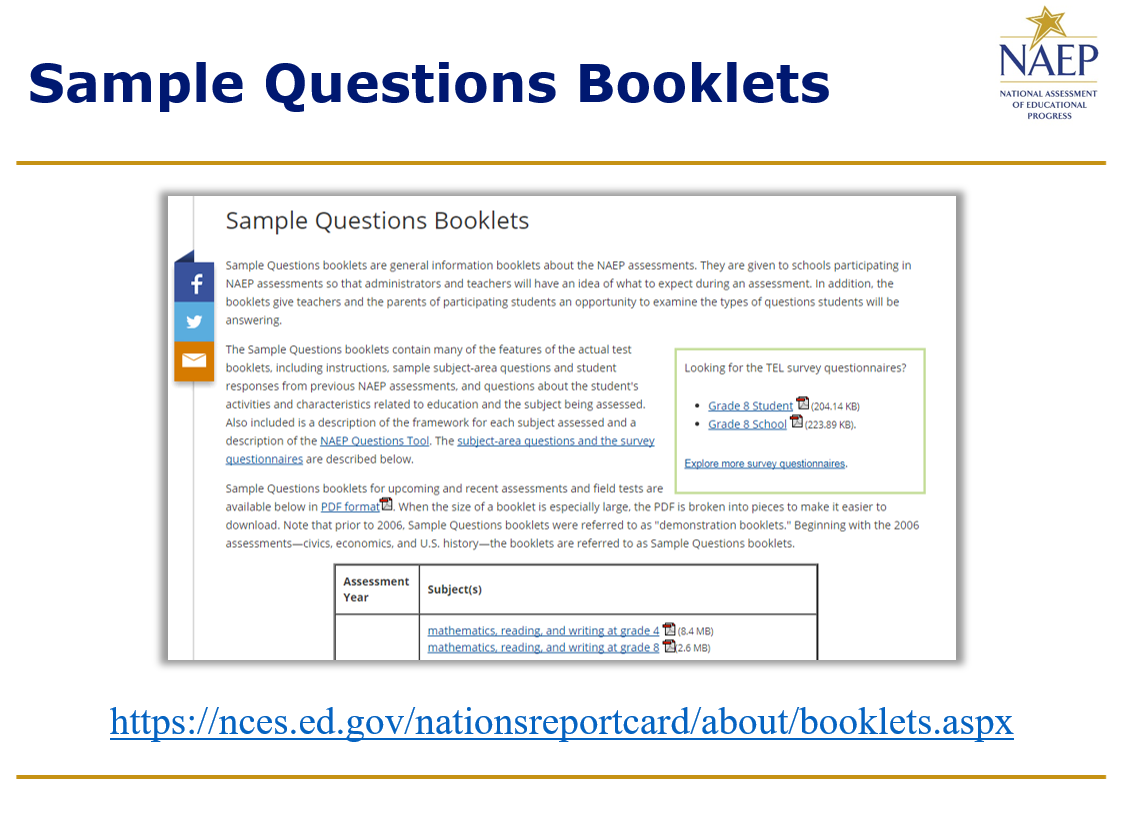
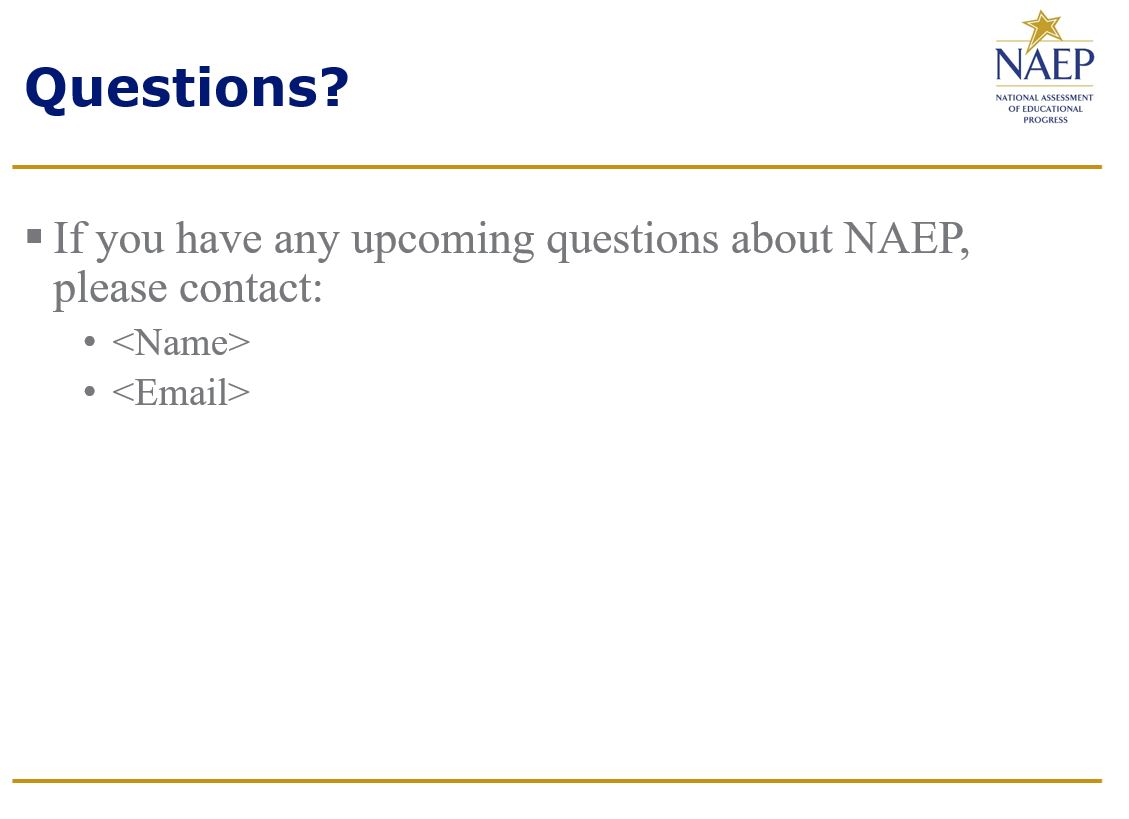
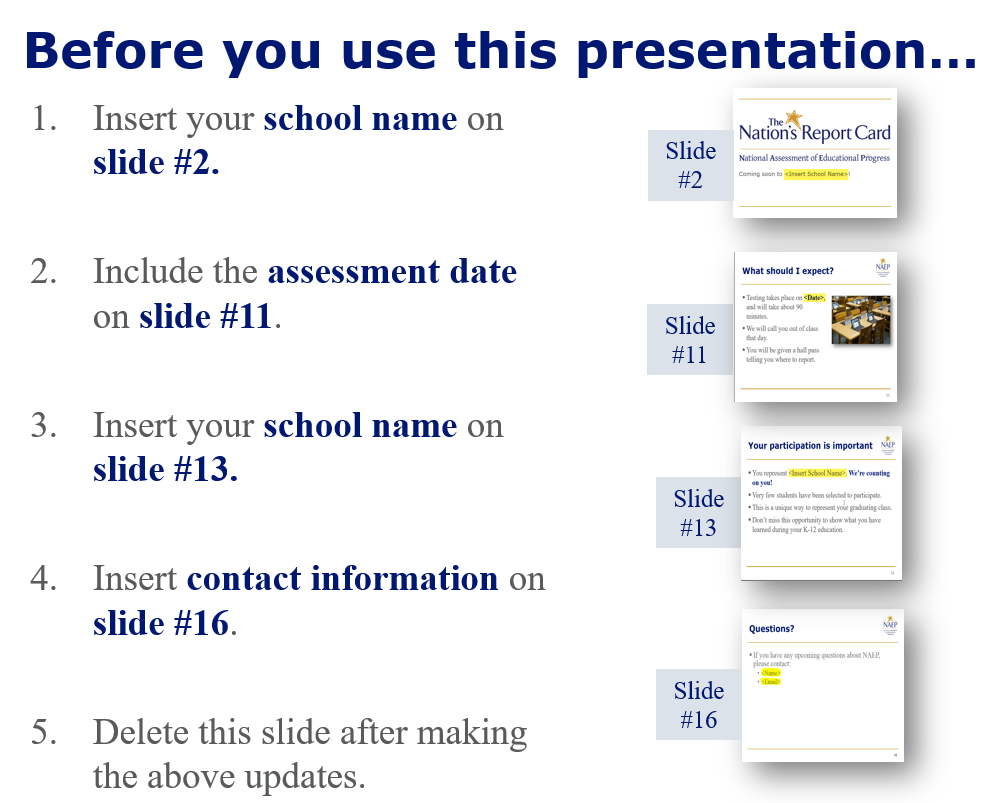
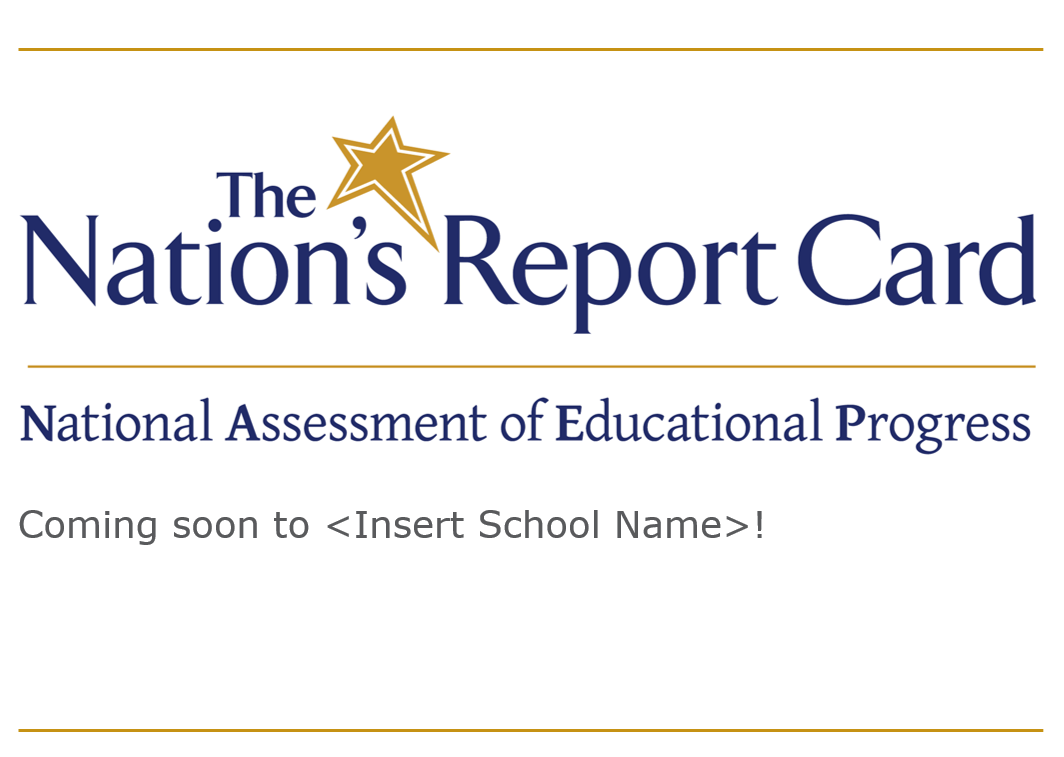
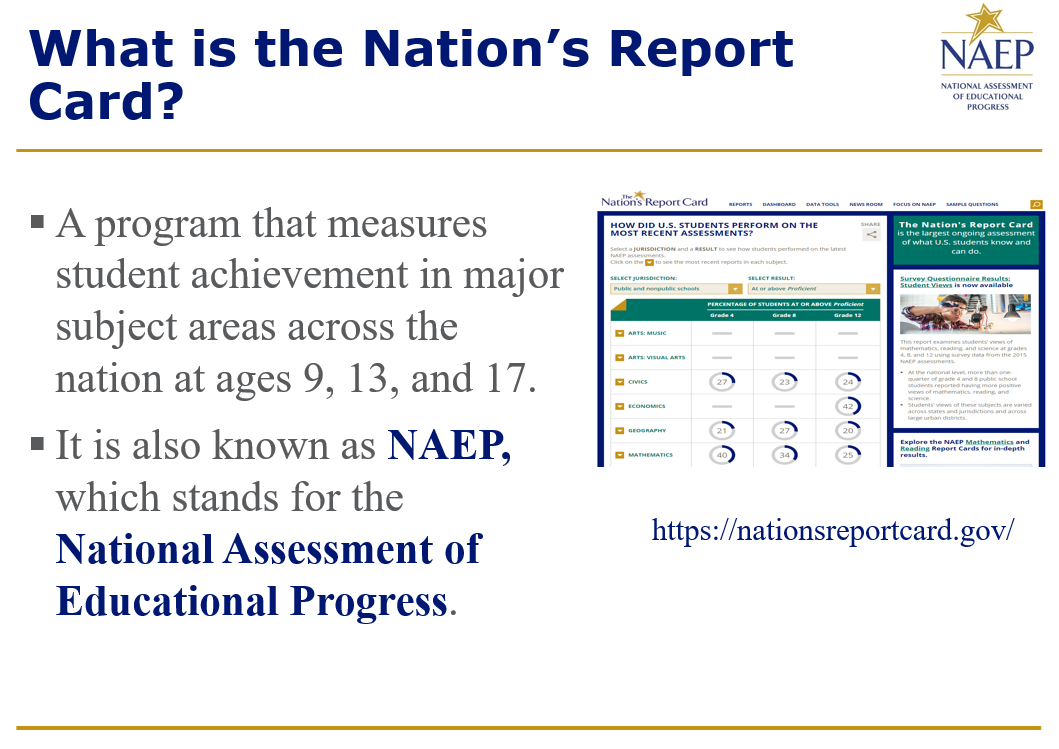
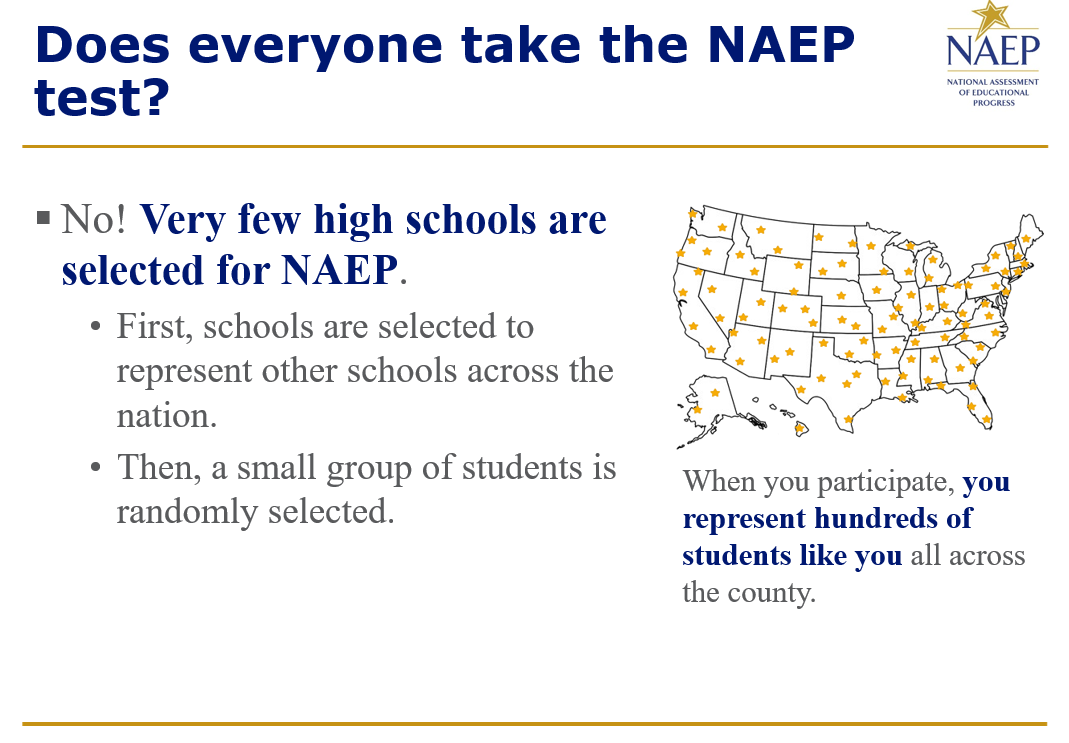
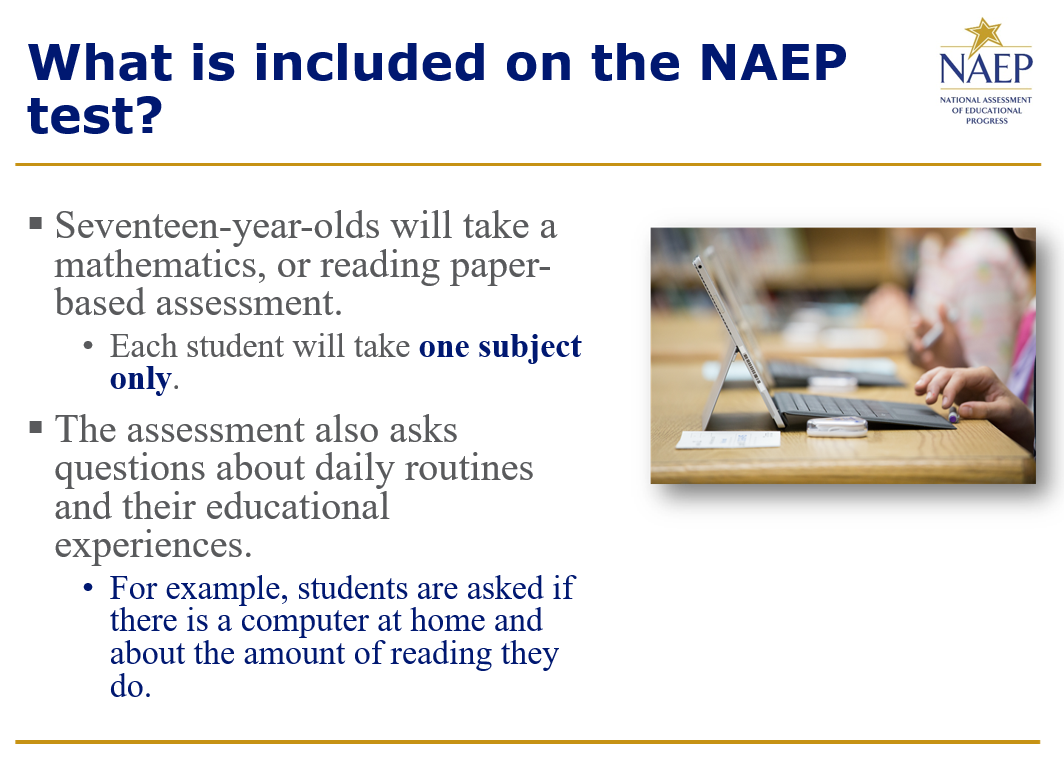
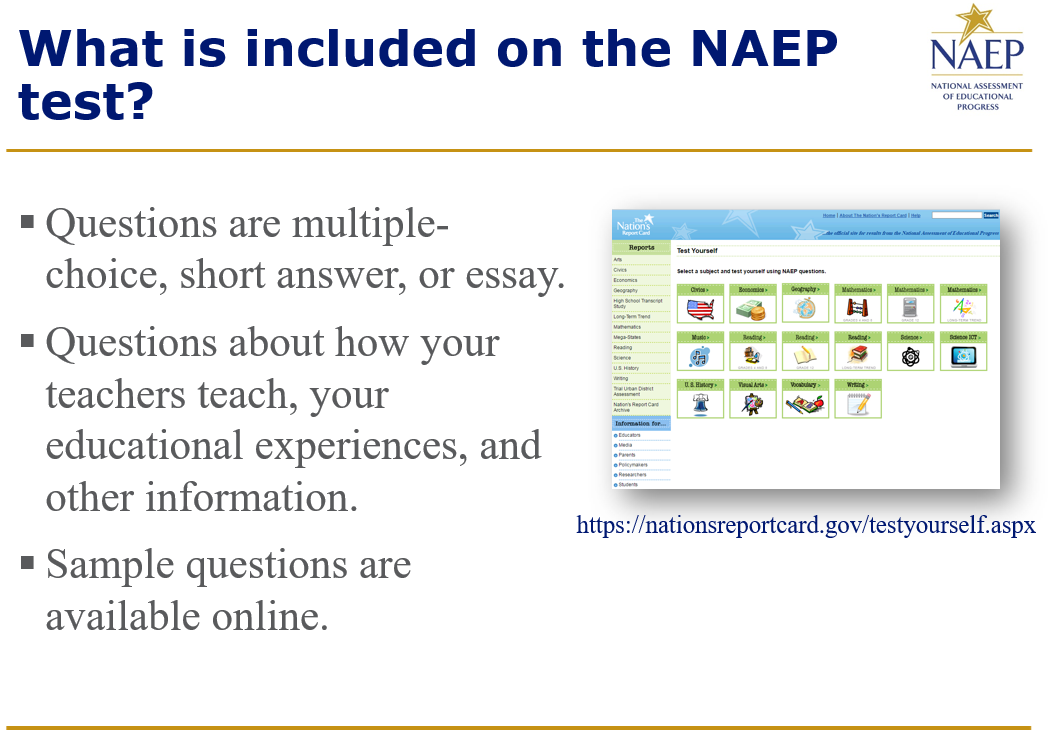

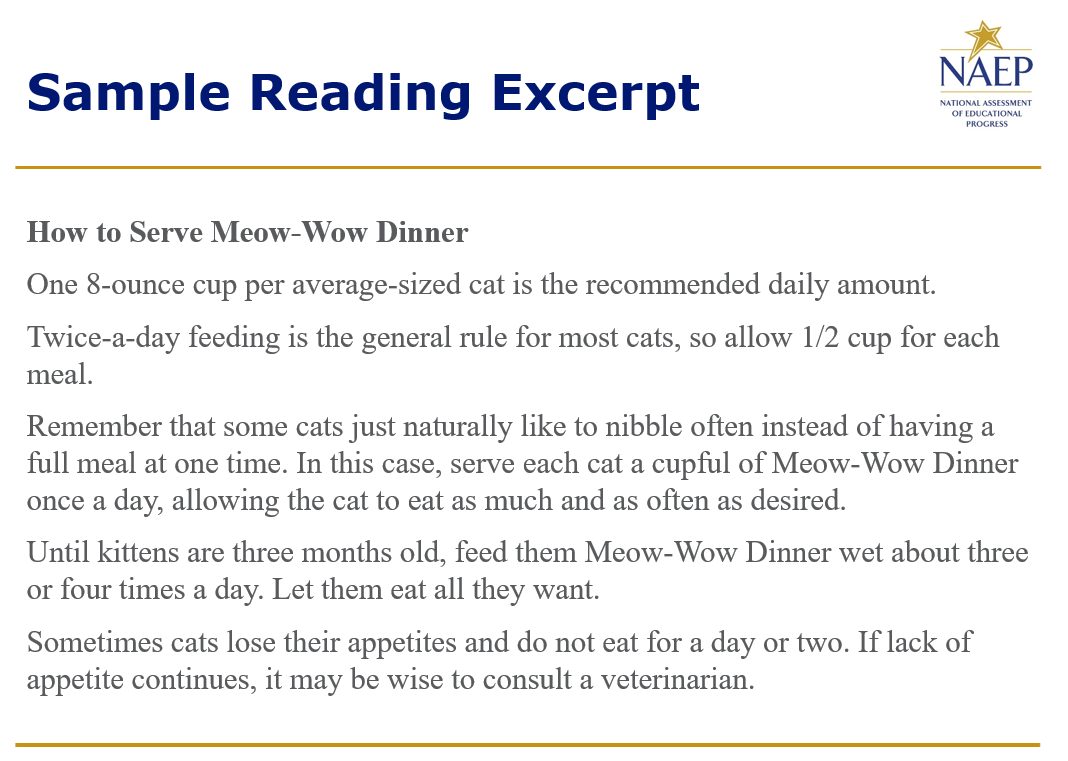
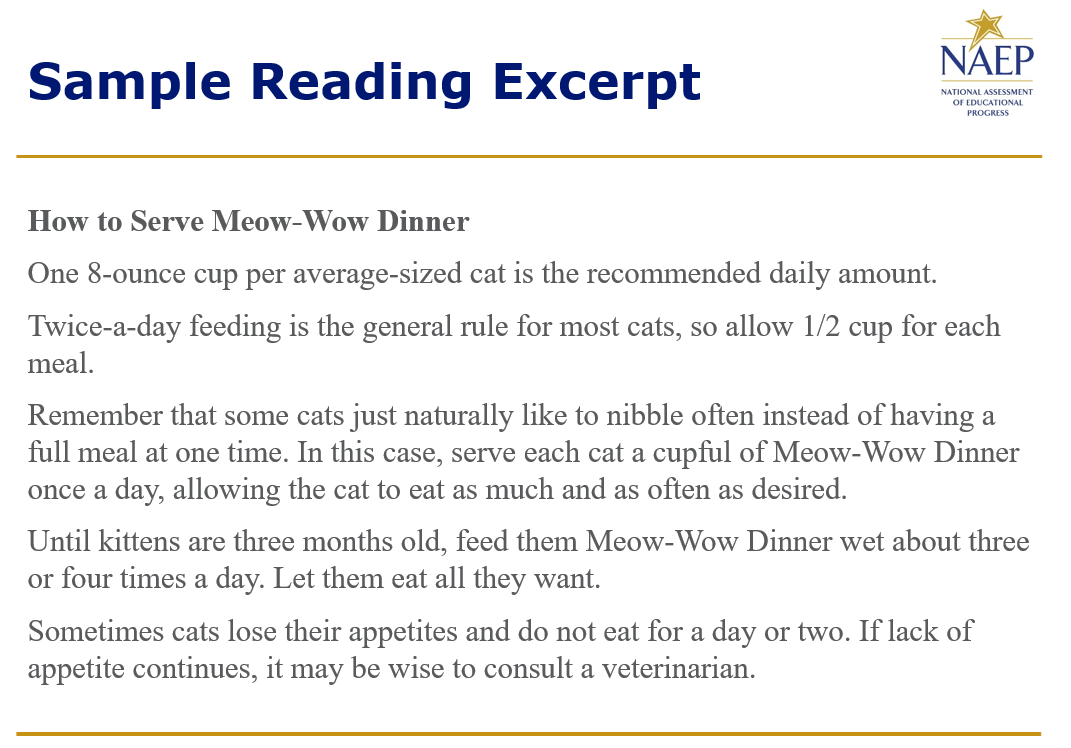
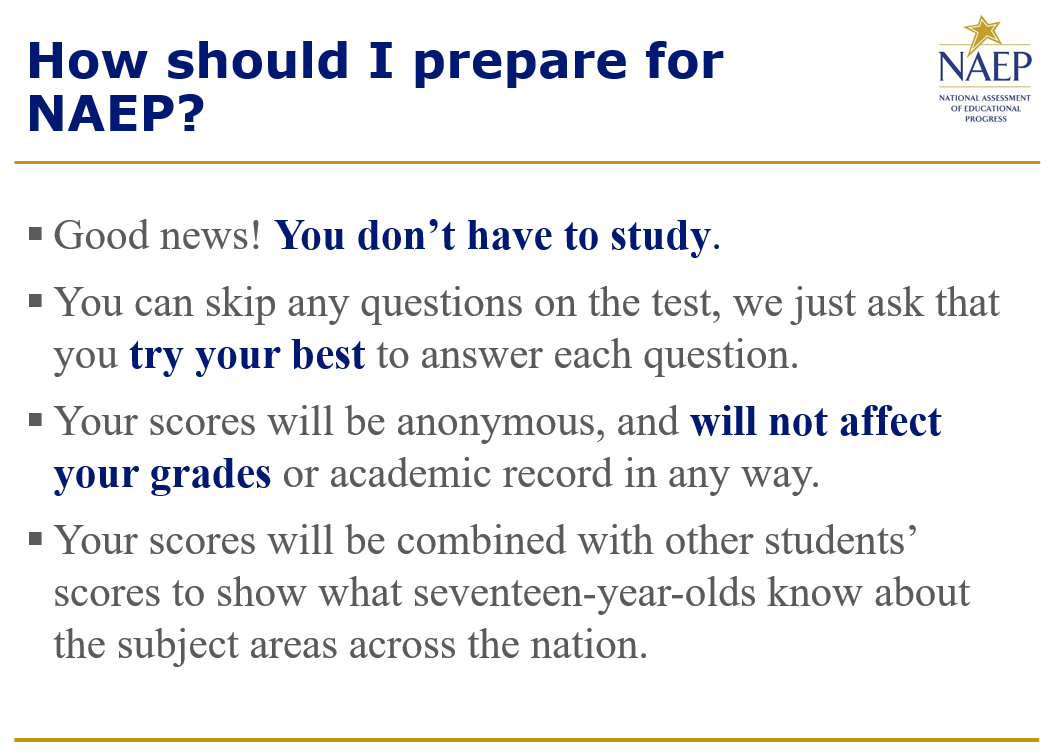
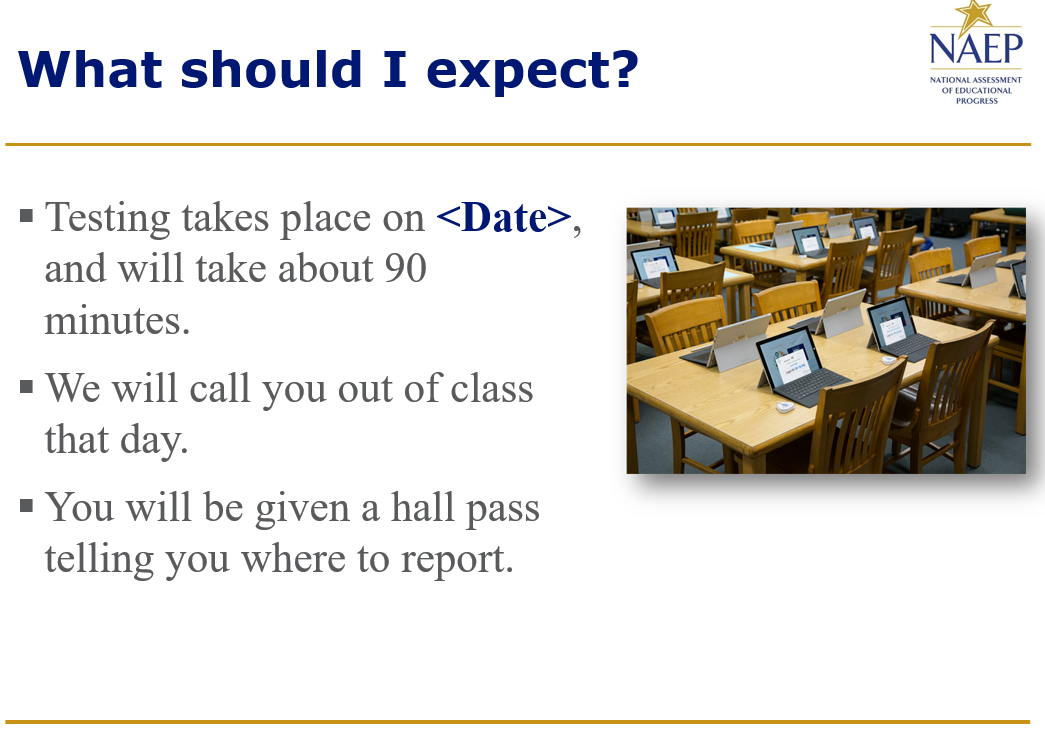


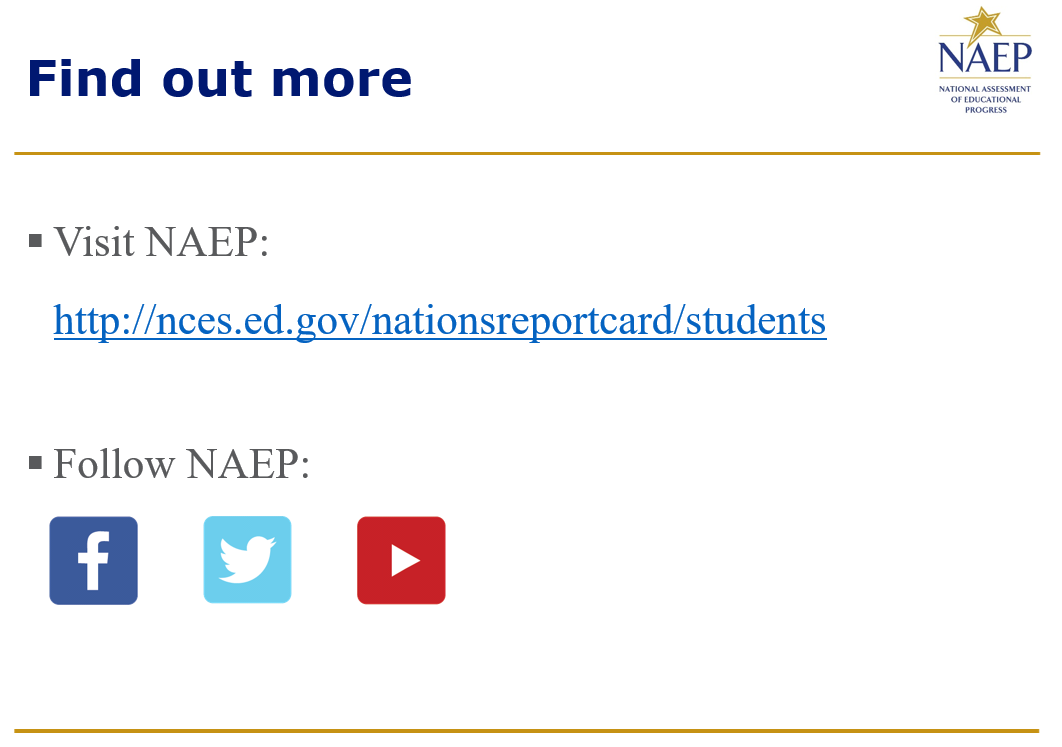

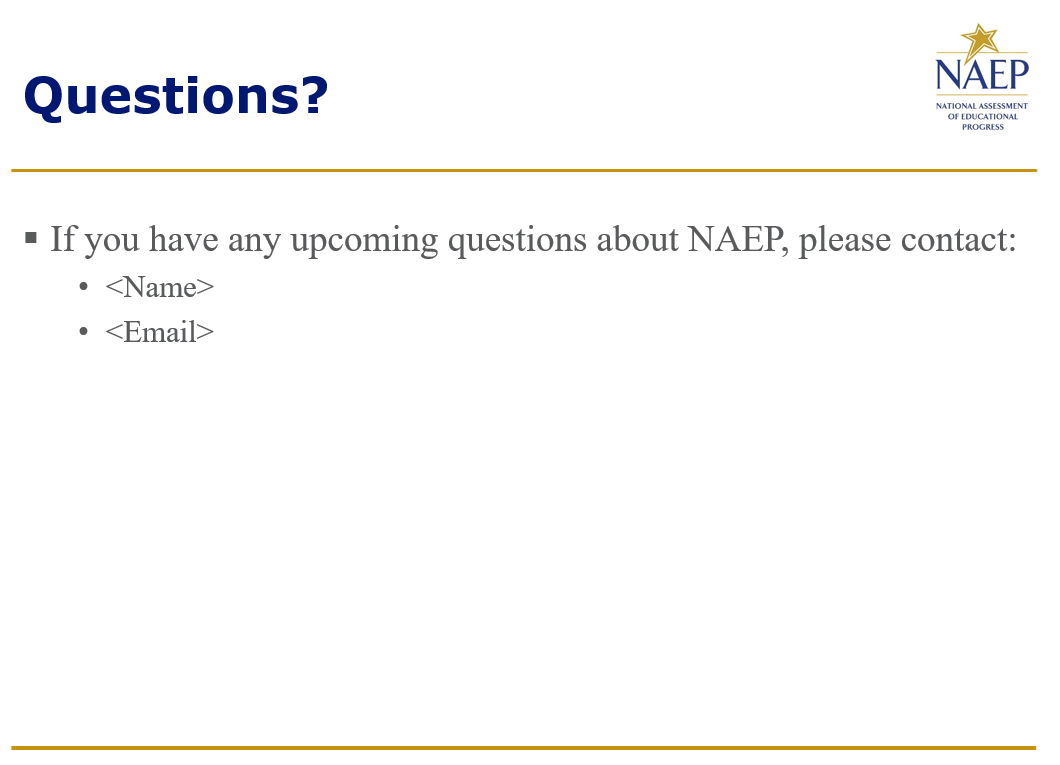
Appendix D3-20: (Spanish version) 2020 Parent/ Guardian Notification Letter, Public
CARTA DE NOTIFICACIÓN A LOS PADRES O TUTORES SOBRE NAEP DE 2019-2020
(School Letterhead)
(Insert Date Here)
Estimado(a) padre, madre o tutor:
(School name) participará en la Evaluación Nacional del Progreso Educativo (NAEP, por sus siglas en inglés) el (date). NAEP es la evaluación continua y nacionalmente representativa más grande acerca de lo que los estudiantes saben y pueden hacer en diferentes materias. NAEP es administrada por el Centro Nacional de Estadísticas de la Educación (NCES, por sus siglas en inglés), parte del Departamento de Educación de Estados Unidos. NAEP es diferente de nuestras evaluaciones estatales ya que ofrece una medida común de los logros en todo el país. Los resultados se publican en un informe llamado La Libreta de Calificaciones de la Nación, el cual les proporciona información a los educadores, padres, legisladores y al público en general acerca de los logros de los estudiantes.
Su hijo(a) (tomará/posiblemente tome) una evaluación de matemáticas o de lectura. Además de las preguntas sobre la materia, los estudiantes contestan los cuestionarios de NAEP de manera voluntaria. Los cuestionarios proporcionan información valiosa acerca de las experiencias y oportunidades educativas de los estudiantes participantes, tanto dentro como fuera del aula de clases. Puede encontrar más información acerca de los cuestionarios de NAEP en https://nces.ed.gov/nationsreportcard/parents/spanish.aspx en la sección “¿Qué se le preguntará a su hijo(a)?”
La evaluación toma aproximadamente 90 minutos para la mayoría de los estudiantes, incluyendo el tiempo para pasar de una sección a otra o para las instrucciones.
La información recolectada se utiliza únicamente con fines estadísticos.
Las calificaciones de su hijo(a) no se verán afectadas.
Los estudiantes pueden ser excusados por cualquier motivo, no están obligados a completar la evaluación y pueden dejar de responder cualquier pregunta.
Aunque la evaluación es voluntaria, NAEP depende de la participación de los estudiantes para ayudarles a los legisladores a mejorar la educación. No obstante, si no desea que su hijo(a) participe, por favor, notifíqueme por escrito antes del (date).
No es necesario estudiar en preparación para NAEP, pero anime a su hijo(a) a que haga su mejor esfuerzo. Un folleto que explica lo que la participación en NAEP significa para usted y para su hijo(a) está disponible en: https://nces.ed.gov/nationsreportcard/pdf/parents/2012575.pdf. Si tiene alguna pregunta, comuníquese con (name) al (telephone number) o por correo electrónico a (email address).
Nos entusiasma que nuestra escuela participe en NAEP. Sabemos que los estudiantes de (school name) demostrarán lo que los estudiantes de nuestro país saben y pueden hacer.
Atentamente,
(School Principal’s Name)
El Centro Nacional para Estadísticas de la Educación (NCES, por sus siglas en inglés) está autorizado por la Ley de autorización para la Evaluación Nacional del Progreso Educativo (20 U.S.C.§9622) para administrar NAEP, y para recopilar los expedientes educativos de los estudiantes de agencias o instituciones educativas con el propósito de evaluar programas de educación apoyados por el gobierno federal bajo la Ley de Derechos Educativos y Privacidad Familiar (FERPA) (FERPA, 34 CFR §§ 99.31(a)(3)(iii) y 99.35). Toda la información que proporcionen los participantes podrá usarse únicamente con fines estadísticos y no podrá darse a conocer o usarse ni para identificarlos ni para cualquier otro propósito salvo aquél requerido legalmente (20 U.S.C.§9573 y 6 U.S.C §151). Por ley, todos los empleados de NCES al igual que todo representante del mismo, tales como contratistas y coordinadores de NAEP, han hecho un juramento y están sujetos a encarcelamiento hasta por 5 años, una multa de hasta $250,000 dólares o ambas cosas, si intencionadamente dan a conocer CUALQUIER información de identificación de los participantes. El envío de información de los participantes por vía electrónica será monitoreado por empleados y contratistas federales para detectar virus, programas maliciosos (malware) y otras amenazas conforme a la Ley de Mejoramiento de la Seguridad Cibernética de 2015. La información recolectada se combinará para elaborar informes estadísticos.
Appendix D3-21: (Spanish version) 2020 Parent/ Guardian Notification Letter, Private
CARTA DE NOTIFICACIÓN A LOS PADRES O TUTORES PARA ESCUELAS PRIVADAS SOBRE NAEP DE 2020
(School Letterhead)
(Insert Date Here)
Estimado(a) padre, madre o tutor:
Nos complace informarle que (school name) ha sido seleccionada para representar a las escuelas privadas de la nación al participar en la Evaluación Nacional del Progreso Educativo (NAEP, por sus siglas en inglés) el (date). NAEP es la evaluación continua y nacionalmente representativa más grande acerca de lo que los estudiantes en escuelas públicas y privadas saben y pueden hacer en diferentes materias. NAEP es administrada por el Centro Nacional de Estadísticas de la Educación (NCES, por sus siglas en inglés), parte del Departamento de Educación de Estados Unidos. NAEP es diferente de las evaluaciones estatales y escolares ya que ofrece una medida común de los logros estudiantiles en todo el país. Los resultados se publican en un informe llamado La Libreta de Calificaciones de la Nación, el cual les proporciona información a los educadores, padres, legisladores y al público en general acerca de los logros de los estudiantes.
Su hijo(a) (tomará/posiblemente tome) una evaluación de matemáticas o lectura. Además de las preguntas sobre la materia, los estudiantes contestan los cuestionarios de NAEP de manera voluntaria. Los cuestionarios proporcionan información valiosa acerca de las experiencias y oportunidades educativas de los estudiantes participantes, tanto dentro como fuera del aula de clases. Puede encontrar más información acerca de los cuestionarios de NAEP en https://nces.ed.gov/nationsreportcard/parents/spanish.aspx en la sección “¿Qué se le preguntará a su hijo(a)?”
La evaluación toma aproximadamente 90 minutos para la mayoría de los estudiantes, incluyendo el tiempo para pasar de una sección a otra o para las instrucciones.
La información recolectada se utiliza únicamente con fines estadísticos.
Las calificaciones de su hijo(a) no se verán afectadas.
Los estudiantes pueden ser excusados por cualquier motivo, no están obligados a completar la evaluación y pueden dejar de responder cualquier pregunta.
Aunque la evaluación es voluntaria, NAEP depende de la participación de los estudiantes para ayudarles a los legisladores a mejorar la educación. No obstante, si no desea que su hijo(a) participe, por favor, notifíqueme por escrito antes del (date).
No es necesario estudiar en preparación para NAEP, pero anime a su hijo(a) a que haga su mejor esfuerzo. Un folleto que explica lo que la participación en NAEP significa para usted y para su hijo(a) está disponible en: https://nces.ed.gov/nationsreportcard/pdf/parents/2012575.pdf. Si tiene alguna pregunta, comuníquese con (name) al (telephone number) o por correo electrónico a (email address). Para obtener información adicional (en inglés) acerca de la participación de las escuelas privadas en NAEP, vaya a https://nces.ed.gov/nationsreportcard/participating/private_nonpublic.aspx.
Nos entusiasma que nuestra escuela participe en NAEP. Sabemos que los estudiantes de (school name) demostrarán lo que los estudiantes de las escuelas privadas en nuestro país saben y pueden hacer.
Atentamente,
Director(a) de escuela
El Centro Nacional para Estadísticas de la Educación (NCES, por sus siglas en inglés) está autorizado por la Ley de autorización para la Evaluación Nacional del Progreso Educativo (20 U.S.C.§9622) para administrar NAEP, y para recopilar los expedientes educativos de los estudiantes de agencias o instituciones educativas con el propósito de evaluar programas de educación apoyados por el gobierno federal bajo la Ley de Derechos Educativos y Privacidad Familiar (FERPA) (FERPA, 34 CFR §§ 99.31(a)(3)(iii) y 99.35). Toda la información que proporcionen los participantes podrá usarse únicamente con fines estadísticos y no podrá darse a conocer o usarse ni para identificarlos ni para cualquier otro propósito salvo aquél requerido legalmente (20 U.S.C.§9573 y 6 U.S.C §151). Por ley, todos los empleados de NCES al igual que todo representante del mismo, tales como contratistas y coordinadores de NAEP, han hecho un juramento y están sujetos a encarcelamiento hasta por 5 años, una multa de hasta $250,000 dólares o ambas cosas, si intencionadamente dan a conocer CUALQUIER información de identificación de los participantes. El envío de información de los participantes por vía electrónica será monitoreado por empleados y contratistas federales para detectar virus, programas maliciosos (malware) y otras amenazas conforme a la Ley de Mejoramiento de la Seguridad Cibernética de 2015.La información recolectada se combinará para elaborar informes estadísticos.
Appendix D3-22: 2020 NCES Letter to Chiefs
U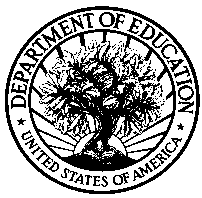 NITED
STATES DEPARTMENT OF EDUCATION
NITED
STATES DEPARTMENT OF EDUCATION
INSTITUTE OF EDUCATION SCIENCES
NATIONAL CENTER FOR EDUCATION STATISTICS
March 25, 2019
NAME
TITLE
ADDRESS 1
ADDRESS 2
CITY, STATE, ZIP
Dear NAME:
The National Center for Education Statistics (NCES) is preparing for the 2019-2020 school year collection cycles and I would like to inform you of upcoming activities which may have implications for your state. We have traditionally sent such notices for our assessment operations, but are expanding to include all data collection operations for the upcoming school year.
Assessments:
NCES will be administering a national Long-Term Trend (LTT) assessment in during the 2019-2020 school year. Since the early 1970s, the National Assessment of Educational Progress (NAEP) has monitored student performance in mathematics and reading through LTT assessments. These assessments measure students’ educational progress over long time periods to look for and monitor trends in performance. Results from the LTT assessments are based on nationally representative samples of 9-, 13-, and 17-year olds.
Schools in your state may be selected to participate in LTT; participation in these components is voluntary. As each state’s participation in NAEP is essential for providing a national perspective, I respectfully encourage your support. If selected, your NAEP State Coordinator will receive the sample of schools for the LTT assessments in May 2019.
NCES will be administering the LTT assessments on the following dates:
Age 13: October 14 – December 20, 2019
Age 9: January 6 – March 13, 2020
Age 17: March 16 – May 22, 2020
Because the NAEP LTT assessments will be conducted at the national level only, there will be no state level results reported. The national results for these assessments will be available in 2021. If you have any questions, or if you would like additional information about the NAEP assessments, please contact Holly Spurlock, Branch Chief, Assessment Operations, at [email protected] or (202) 245-7132, or Gina Broxterman at [email protected] or (202) 245-7791. Further information is also available through the NAEP website at www.nationsreportcard.gov.
Other voluntary national sample survey-based data collections include:
The 2019-2020 School Survey on Crime and Safety (SSOCS) is the only national study about crime and safety in public schools. It collects information from principals on incidence, frequency, and nature of unsafe behaviors affecting students and school personnel, as well as practices and programs developed to provide a safe school environment. We will start recruitment of approximately 4,800 schools across all states this fall and the SSOCS collection will begin in February 2020 and end in June 2020. Results will be available in the summer of 2021. SSOCS data are a key component of the Indicators of School Crime and Safety report and is frequently requested by the administration and Congress. Additionally, a validation study comparing items on SSOCS and similar items on the Civil Rights Data Collection (CRDC) will be conducted during the summer of 2019 with a small number of schools and districts. The purpose of the validation study is to reduce the number of questions on the surveys. This will involve qualitative interviews with SSOCS respondents and CRDC respondents. For questions about the study, please contact Andy Zukerberg at [email protected] or (202) 245-6186.
The 2019-2020 Use of Educational Technology for Instruction in Public Schools survey will be a fast response survey of principals in 1,300 public schools that will be fielded from the beginning of the school year through June 30. Data will be collected regarding access to internet and computing technology in schools. The information will be used to help the Department modify the National Education Technology Plan. For questions about the study, please contact Chris Chapman at [email protected].
The 8th-grade collection for the Middle Grades Longitudinal Study of 2017-18 (MGLS:2017) is the follow-up to the first study conducted by NCES that examines the experiences and progress of a cohort of 6th-graders and fills the gap in longitudinal studies on information during the middle grade years. The national 6th-grade data collection took place from January 2018 through July 2018. Decisions about fielding the 8th-grade collection are still under consideration. If collection is undertaken, data will be collected in 700 public schools that educate students in the middle grades across the country. Contacts would start in September 2019 with data collection beginning in January 2020. Information will be collected from principals, teachers, students and their parents in these schools as was done for the 6th-grade collection. For questions about the study, please contact Gail Mulligan at [email protected].
NCES will also be field testing data collection procedures and content for the upcoming High School and Beyond 2020 (HS&B:20) study, which will include contacts with 100 public K-12 schools across the country. Data collection activities will include surveys of principals, teachers, school counselors, students, and parents of sampled students in these schools and will include administration of short reading and math assessments to sampled students within the sampled schools. The first full data collection is scheduled for the fall of 2020. HS&B is frequently used by researchers to better understand the impacts of high school experiences on long-term life outcomes. If you have questions about HS&B, please contact Gail Mulligan at [email protected].
Collection work to support design of future studies will be undertaken across many of our international studies. Both Program for International Student Assessment (PISA) and the Progress in International Reading Literacy Study (PIRLS) will have pilots as part of our 2019-2020 cycle. These pilot assessments will occur in the spring of 2020 and should involve only approximately 50 schools across the country. If you have any questions regarding the PISA or PIRLS assessment, please contact Stephen Provasnik at [email protected].
NCES is developing several new initiatives and continuing with ongoing collections and technical assistance related to supporting states’ needs with administrative records and data systems. In the coming weeks we will make available the applications for the next round of Statewide Longitudinal Data System (SLDS) grants. We just completed the Annual SLDS Best Practices Conference which was attended by representatives from almost every state and featured presentations by active grantees from our last round (Fiscal Year 2015). Presentations and other technical assistance resources from SLDS can be accessed by your offices at https://nces.ed.gov/programs/slds/. The Information Collection Clearance package for the Department’s EDFacts collection will be posted for its second public comment period soon. We would like to thank all the state education employees who took time to provide input and responses to directed questions during the first public comment period. Lastly, we will be hosting our annual meeting of the Forum on Education Statistics and summer data conference, STATS-DC, in late July 2019.
Thank you for your continued support of NCES studies.
Sincerely,

James Woodworth, Ph.D.
Commissioner
National Center for Education Statistics
CC: State Assessment Director
Our mission is to ensure equal access to education and to promote educational excellence throughout the Nation.
| File Type | application/vnd.openxmlformats-officedocument.wordprocessingml.document |
| Author | Molin, Ed C |
| File Modified | 0000-00-00 |
| File Created | 2021-01-15 |
© 2025 OMB.report | Privacy Policy